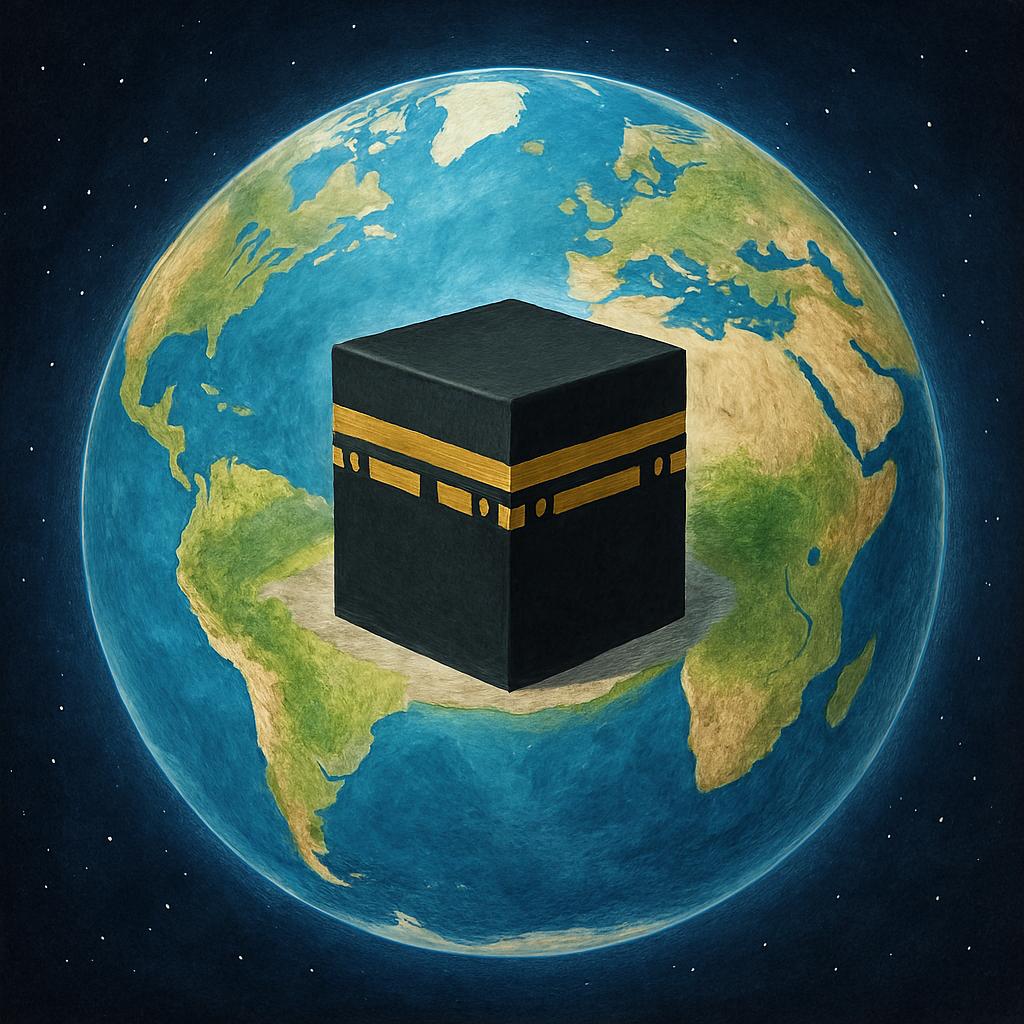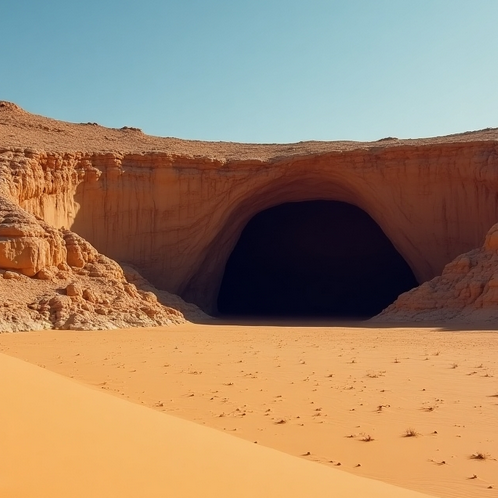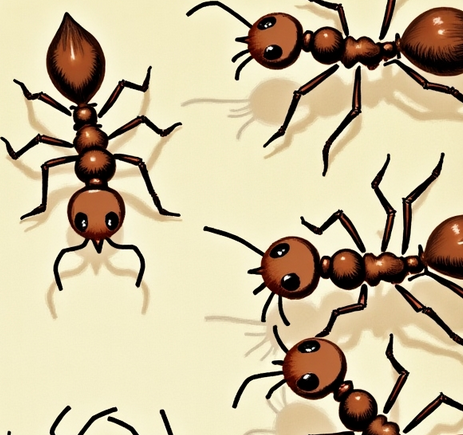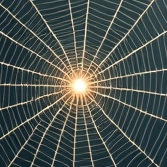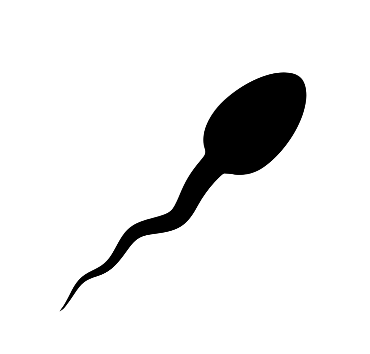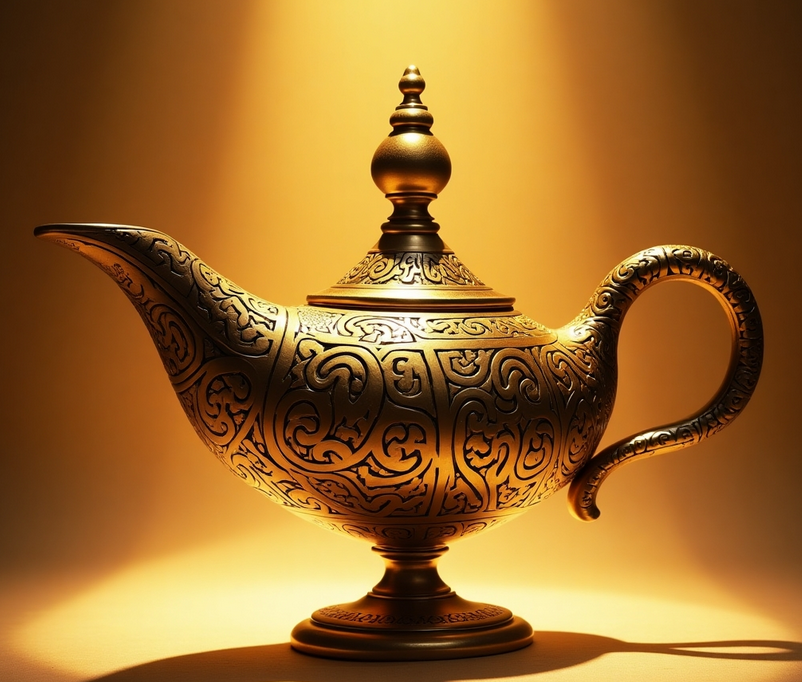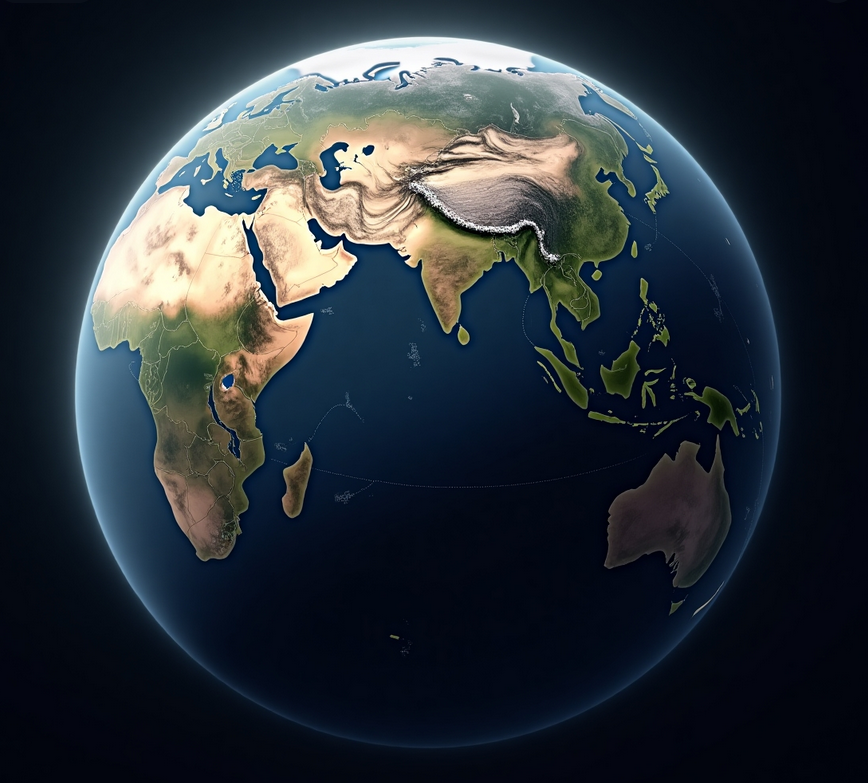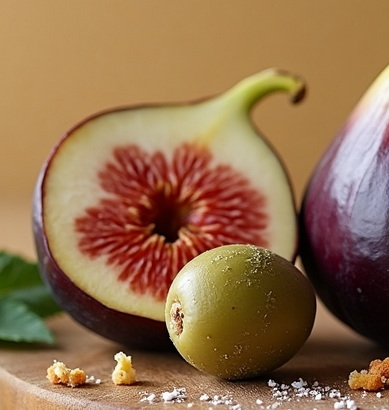Bukti Adanya Allah
[archive]



We will show them Our signs in the universe and within themselves until it becomes clear to them that this ˹Quran˺ is the truth. Is it not enough that your Lord is a Witness over all things? (Fussilat 53)
Kami akan memperlihatkan kepada mereka tanda-tanda (kebesaran) Kami di segenap penjuru dan pada diri mereka sendiri, sehingga jelaslah bagi mereka bahwa Alquran itu adalah benar. Tidak cukupkah (bagi kamu) bahwa Tuhanmu menjadi saksi atas segala sesuatu? (Fussilat 53)
Daftar Isi
What we did not experience, but the prophet’s companions did:
Apa yang kita tidak alami, tetapi sahabat Nabi mengalaminya:
The Romans have been defeated in a nearby land. Yet following their defeat, they will triumph within three to nine years. The ˹whole˺ matter rests with Allah before and after ˹victory˺. And on that day the believers will rejoice at the victory willed by Allah. He gives victory to whoever He wills. For He is the Almighty, Most Merciful. (Ar Rum 2-5)
611–623 Persians gradually conquer Syria, Palestine (614), Egypt (621) and Rhodes (622) and enter Anatolia
625 Ar Rum 2-5 was revealed
627 The outnumbered Romans defeat Persian at Nineveh
629 Persian withdraw from all occupied territories
632 The passing of Prophet Muhammad (PBUH)
Telah dikalahkan bangsa Romawi, di negeri yang terdekat dan mereka sesudah dikalahkan itu akan menang, dalam beberapa tahun lagi. Bagi Allah-lah urusan sebelum dan sesudah (mereka menang). Dan pada hari (kemenangan bangsa Romawi) itu, bergembiralah orang-orang yang beriman, karena pertolongan Allah. Dia menolong siapa yang dikehendaki-Nya. Dan Dialah Maha Perkasa lagi Penyayang. (Ar Rum 2-5)
611–623 Persia secara berangsur-angsur menaklukkan Syria, Palestina, Mesir dan Rhodes, serta memasuki Anatolia
625 Ar Rum 2-5 diturunkan
627 Pasukan Romawi yang kalah jumlah mengalahkan Persia di Nineveh
629 Persia mundur dari semua daerah kekuasaan
632 Wafatnya Nabi Muhammad SAW
Fun Fact
Disclaimer:
AI assists in material discovery, text composition, wording refinement, and translation.
Advancement in Mapping, Matter, Biology, and Cosmos
Scientific understanding has advanced remarkably since Eratosthenes’s 3rd century BCE calculation of Earth’s circumference, which aided early latitude determination. The Quran was revealed to Prophet Muhammad (PBUH) incrementally over 23 years in the 7th century. While it contains verses that touch upon natural phenomena, creation, and the universe, it does not explicitly present information about mapping, the precise composition of matter (like atomic theory), specific biological structures (like cells or DNA), or detailed cosmic observations in the form of scientific formulas or systematic explanations.. The 17th century saw pivotal inventions like the compound microscope by Janssen, Galileo’s initial telescopic observations of the Milky Way, Hooke’s coining of “cells,” Leeuwenhoek’s microscopic insights, and Picard’s refined land mapping techniques. This pursuit of precision continued into the 18th century with Harrison’s marine chronometers revolutionizing oceanic longitude and Bergman’s early chemical systematization. The 19th century brought fundamental scientific shifts, including Dalton’s atomic theory, Berzelius’s chemical notation, the formalization of Cell Theory by Schwann and Schleiden, the initial recognition and naming of enzymes, and the discovery of chromosomes. The early 20th century featured Hubble’s profound revelation of distant galaxies and the development of electron microscopes that greatly surpassed optical limits. Finally, the mid-20th century saw the groundbreaking discovery of DNA’s double helix structure, culminating in the late 20th century with GPS providing unprecedented global precision in mapping.
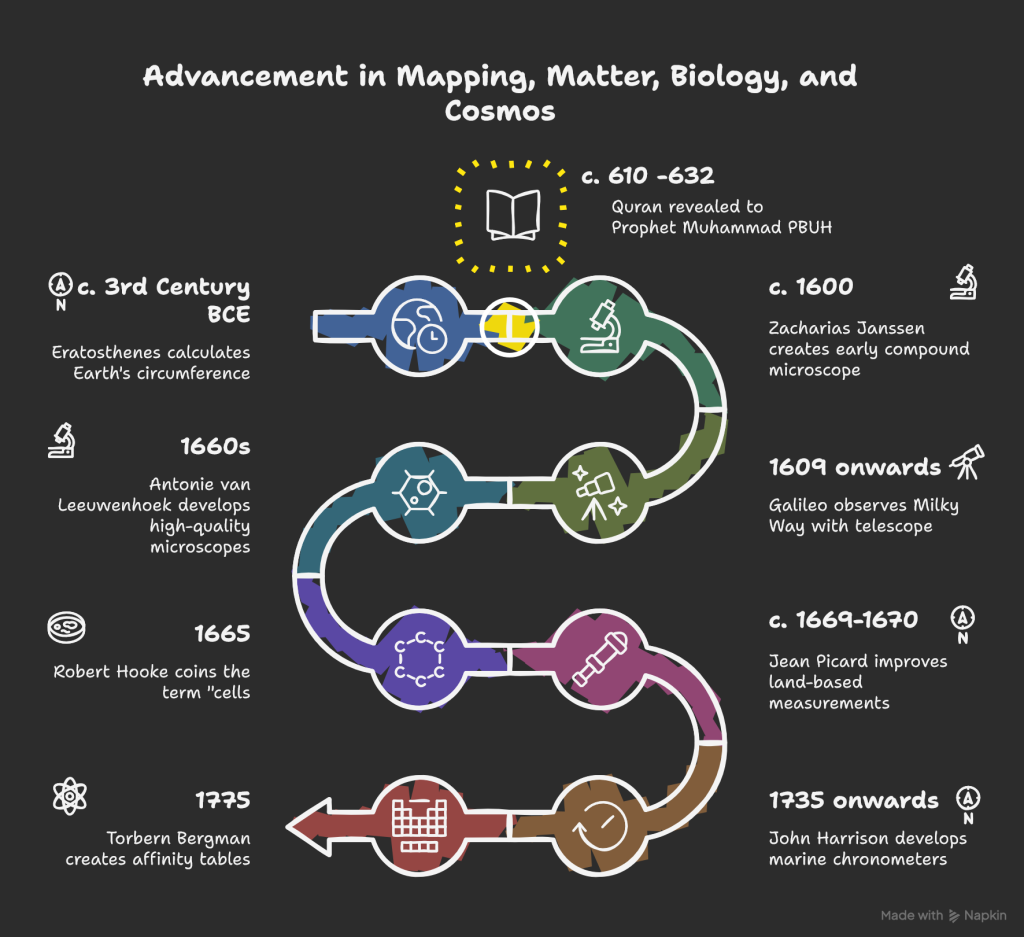
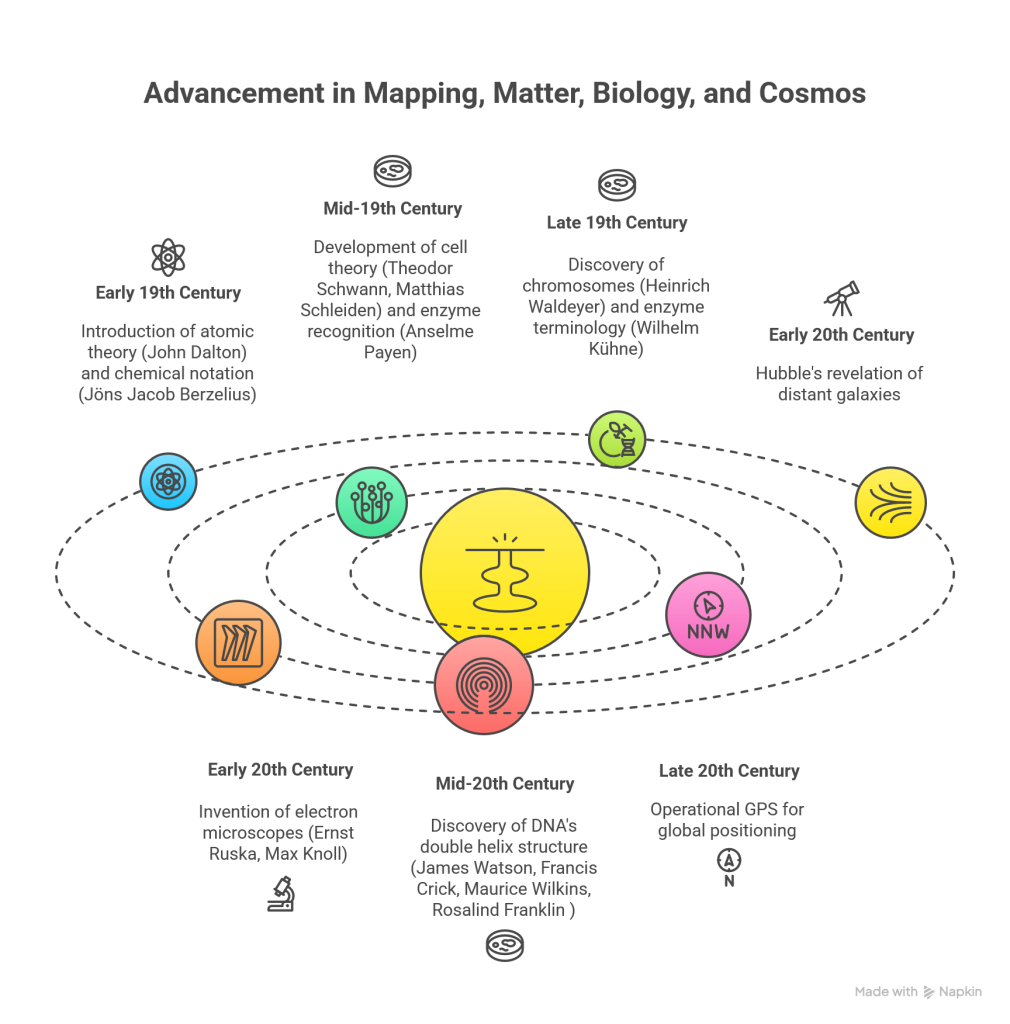
Fun Math Rules
- Number of letters for each Verse is taken from Binimad [archive]
- Final Result
The sum of all substrings must equal the determined target number (e.g., 6461). - Full String Usage
A substring can be the entire original number (e.g., for “5978932”, the substring “5978932” is allowed). - Digit Coverage
All digits from the original number must be used at least once in a combination of substrings, with the substring length being flexible (1 digit, 2 digits, etc.). - Substring Flexibility
You can use a substring from any part of the number (front/middle/back). - Substring Formation (in one original number)
- Substrings must consist of consecutive digits without being reversed (valid example: “5978”; invalid example: “8795” because it’s not consecutive).
- A single substring with an identical index range cannot be repeated (example: in “5978932”, the substring “9” at [1-1] and [4-4] can only be used once).
- Digits at different positions can be used again as long as the substrings have a different index range (example: the digit “9” at index 1 and 5 can be used in two different substrings), or in other words, the index range must be unique for each substring, even if overlapping. For example, subtring “97” (index [1-2]) and substring “9” (index [1-1]) are both valid because their index ranges are different, even though they both use the digit “9.”
- Example of Original Number:
5978932 - Example of Target Number:
6461 - Example of Substring Sum:
5978+59+97+78+89+93+32+5+9+7+9+3+2
Kaaba Position
Inspired by online video on the same theme (Kaaba and Golden Ratio), calculate with different calculation and perspective.
In the book “Is God a Mathematician?”, it is mentioned that some parts of the universe are arranged according to the Fibonacci number pattern (1, 1, 2, 3, 5, 8, 13, 21, …) and the division between those numbers (3/2, 5/3, 8/5, 13/8, …), the longer it goes on, the closer the result gets to the golden ratio 1.61803.
The Kaaba is located at a position of 21.423° N. The ratio of its position to the poles is (90+21.423)/(90-21.423)≈1.625. This value is equal to the ratio of the two consecutive numbers before 21, specifically 13/8=1.625
Fun Fact: Kaaba Position

Dalam buku “Is God a Mathematician?”, disebutkan bahwa beberapa bagian alam semesta disusun menggunakan pola angka Fibonacci (1, 1, 2, 3, 5, 8, 13, 21, …) dan pembagian antara angka-angka tersebut (3/2, 5/3, 8/5, 13/8, …), yang semakin lama hasilnya semakin mendekati golden ratio 1.61803.
Kakbah berada pada posisi 21,423 N. Perbandingan posisi dengan kutub adalah (90+21,423)/(90-21,423)≈1,625. Nilai ini sama dengan rasio dari dua angka berurutan sebelum 21, yaitu 13/8=1.625.
Fun Fact: Posisi Kakbah
In the book “Is God a Mathematician?”, it is mentioned that some parts of the universe are arranged according to the Fibonacci number pattern (1, 1, 2, 3, 5, 8, 13, 21, …) and the division between those numbers (3/2, 5/3, 8/5, 13/8, …), the longer it goes on, the closer the result gets to the golden ratio 1.61803.
The Kaaba is located at 39.826° E. The ratio calculated from this position relative to the Earth’s full circle of longitude is (180 – 39.826) / (180 + 39.826) ≈ 0.638. This value is approximately equal to 5/8 + 0.013, which is derived from a sequence involving three consecutive numbers before 21.
Fun Fact: Kaaba Position

Dalam buku “Is God a Mathematician?”, disebutkan bahwa beberapa bagian alam semesta disusun menggunakan pola angka Fibonacci (1, 1, 2, 3, 5, 8, 13, 21, …) dan pembagian antara angka-angka tersebut (3/2, 5/3, 8/5, 13/8, …), yang semakin lama hasilnya semakin mendekati golden ratio 1.61803.
Ka’bah terletak pada posisi 39,826 T. Rasio yang dihitung dari posisi ini relatif terhadap lingkaran penuh bujur Bumi adalah (180−39,826)/(180+39,826)≈0,638. Nilai ini kira-kira sama dengan 5/8+0,013, yang diturunkan dari urutan yang melibatkan tiga bilangan berurutan sebelum 21.
Fun Fact: Posisi Kakbah
The cow is mentioned in Quran Chapter 2. In fact, Chapter 2 of the Quran is named “Al-Baqarah” (The Cow). Within the chapter, the detailed story of the yellow cow sacrifice can be understood on both literally and metaphorically. Yellow coat color typically arises from 2 factors: (1) presence of 2 recessive “e” alleles (e/e) at the MC1R gene (2) at least a dominant dilution allele (D) or similar genotype (D/D) or (D/d) at PMEL17 gene, lightens red pigment (e) to yellow. The story can be interpreted metaphorically as a lesson about two groups within the faith whose belief is diluted. Sacrifice it, then return to pure faith.
Fun Fact: The Cow (Al Baqarah)

Sapi Betina disebutkan dalam Al-Quran Surat ke 2. Bahkan, Surat 2 Al-Quran diberi nama “Al-Baqarah” (Sapi Betina). Di dalam surat ini, kisah rinci tentang pengorbanan sapi betina kuning dapat dipahami secara harfiah dan metaforis. Warna bulu kuning pada sapi biasanya disebabkan oleh 2 faktor: (1) adanya 2 alel resesif “e” (e/e) pada gen MC1R (2) setidaknya satu alel dilusi (pengencer) dominan (D) atau genotipe serupa (D/D) atau (D/d) pada gen PMEL17, yang mencerahkan pigmen merah (e) menjadi kuning. Kisah ini dapat diinterpretasikan secara metaforis sebagai pelajaran tentang dua kelompok di dalam keyakinan yang imannya “diencerkan.” Korbankanlah, lalu kembalilah pada iman.
Fun Fact: Sapi Betina (Al Baqarah)
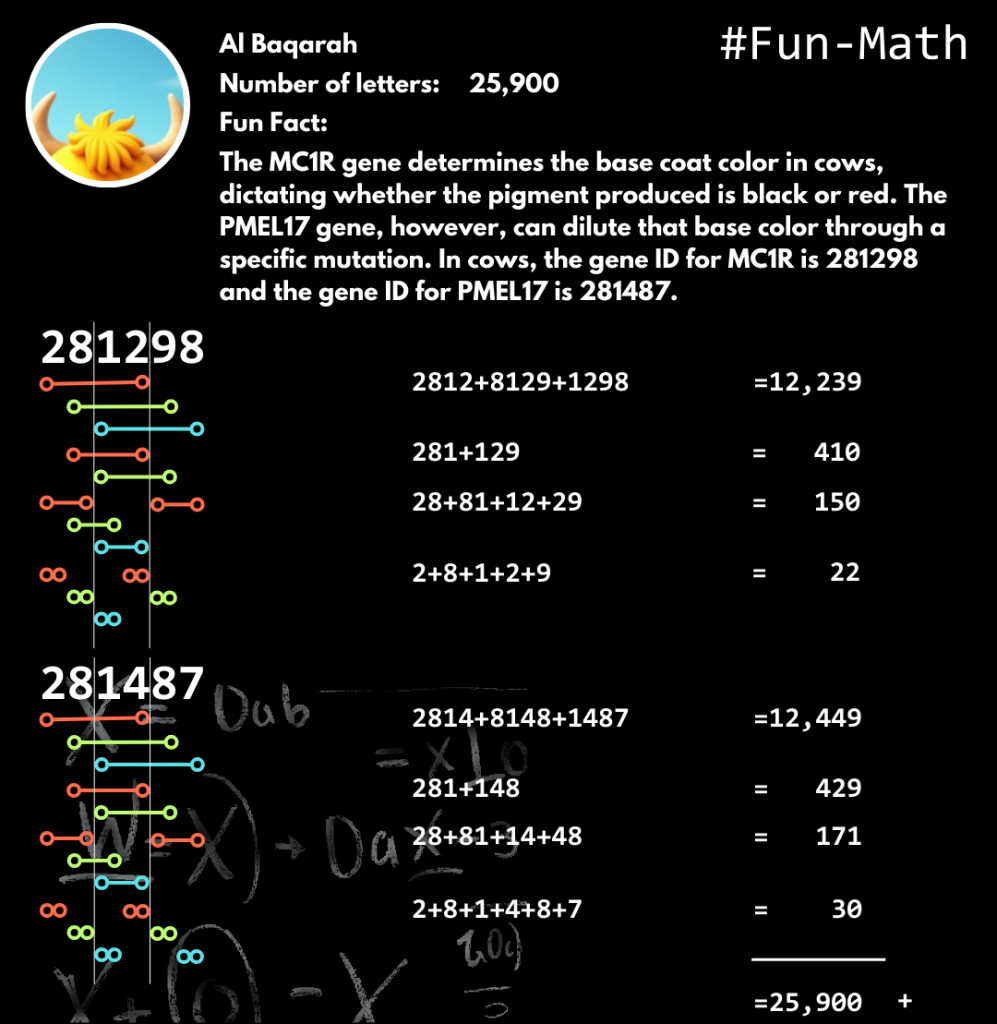
Al Baqarah
Number of letters:
25,900
Fun Fact:
The MC1R gene determines the base coat color in cows, dictating whether the pigment produced is black or red. The PMEL17 gene, however, can dilute that base color through a specific mutation. In cows, the gene ID for MC1R is 281298 and the gene ID for PMEL17 is 281487.
281298 281487
2812+8129+1298+2814+8148+1487 + 129+281+148+281 + 28+81+12+29+28+81+14+48 + 2+8+1+2+9+2+8+1+4+8+7 = 25,900
#Fun-Math
- The Cow
- Sapi Betina
The cow is mentioned in Quran Chapter 2. In fact, Chapter 2 of the Quran is named “Al-Baqarah” (The Cow). Within the chapter, the detailed story of the yellow cow sacrifice can be understood on both literally and metaphorically. Yellow coat color typically arises from 2 factors: (1) presence of 2 recessive “e” alleles (e/e) at the MC1R gene (2) at least a dominant dilution allele (D) or similar genotype (D/D) or (D/d) at PMEL17 gene, lightens red pigment (e) to yellow. The story can be interpreted metaphorically as a lesson about two groups within the faith whose belief is diluted. Sacrifice it, then return to pure faith.
This surah is named after the cow in this story, which happened at the time of Moses (ﷺ). A rich man was killed by his nephew, his only heir, and the body was thrown at the door of an innocent man. After a long investigation, no one was identified as the killer. Moses (ﷺ) prayed for guidance and was told that the only way to find the killer was to sacrifice a cow and strike the victim with a piece of it. When this was done, the victim spoke miraculously and said who the killer was.
They said, “Call upon your Lord to clarify for us what type ˹of cow˺ it should be!” He replied, “Allah says, ‘The cow should neither be old nor young but in between. So do as you are commanded!’ ”. They said, “Call upon your Lord to specify for us its colour.” He replied, “Allah says, ‘It should be a bright yellow cow—pleasant to see.’ ”
Al Baqarah 2:68-69
Many mammals, including cows, share a genetic basis for coat color, with a few key genes playing a central role in determining an animal’s appearance. The principles of epistasis, where one gene influences the expression of another, and incomplete dominance, where a heterozygous genotype results in an intermediate phenotype, are common across different species. The Melanocortin 1 Receptor (MC1R) gene [archive], for example, is a fundamental determinant of whether an animal produces black/brown pigment (eumelanin) or red/yellow pigment (phaeomelanin).
In cows, specific variants of this gene control the base coat color, such as red or black. This same gene is found in a wide variety of other mammals, including dogs, cats, and horses, where its alleles also dictate the primary base coat color. Similarly, dilution genes that act on these base colors are widespread in the mammalian class. The PMEL17 gene [archive], which is responsible for the “yellow bright” phenotype in cows, is an excellent example. This same gene in horses causes the “silver dapple” trait, which specifically dilutes black pigment.
In a similar vein, the MLPH gene is responsible for the common “dilute” coat color in both cats and dogs, turning black fur into blue/gray and red fur into cream. These shared genes and genetic mechanisms highlight the conserved nature of coat color genetics across diverse mammalian species, from livestock to companion animals. While specific mutations and their effects may vary, the underlying genetic principles and the central role of genes like MC1R and various dilution genes remain remarkably consistent.
The “yellow bright” coat color in cows is a result of a specific genetic combination involving two key genes: MC1R and PMEL17.
The first component is the base coat color, which is determined by the MC1R gene.
The “red” allele of this gene is represented by e, and a cow must be homozygous recessive (e/e) to have a red or yellow base coat. This means the cow inherited an “e” allele from both its mother and father, causing its melanocytes to produce only the red/yellow pigment phaeomelanin.
The second component for the yellow coat is the dilution of the red base color, which is controlled by the PMEL17 gene. The allele responsible for dilution is dominant and is often represented by D. For a cow to have a diluted coat color, it must have at least one copy of this dominant allele, so its genotype for the dilution gene is D/– (where the dash signifies that the second allele can be either D or the non-diluted allele, d).
Specifically, the “yellow bright” color is the result of the Dilutor gene acting on a red base coat. The cow must be heterozygous for the dilution gene, having one copy of the dominant dilution allele (D) and one copy of the recessive non-dilution allele (d), so its genotype for the dilution gene is D/d.
If the cow were homozygous for the dominant dilution allele (D/D), it would be a much lighter, nearly white color. This is the genetic basis for the very light coats seen in breeds like Charolais, where the dominant diluter gene dilutes a black base coat to a creamy white. Therefore, to have the “yellow bright” coat color, a cow must have the combined genotype of e/e (for a red base coat) and D/d (for a single copy of the dominant diluter gene). This genetic makeup results in a light, yellowish-red appearance.
Metaphor #1: Munafiq (Hypocrite)
In this metaphor, a hypocrite’s faith or sincerity could be seen as being “diluted.” Here’s how the metaphor could work:
The Original Substance: This represents the core, pure, and sincere belief of a true follower. It is a concentrated and genuine conviction.
The Diluting Agent: This represents the hypocrite’s ulterior motives, insincerity, selfish desires, or hidden disbelief. It is the “water” added to the pure substance.
The Diluted Solution: This represents the hypocrite’s outward display of faith. It has the appearance of the original substance—it looks and acts like a believer—but its concentration is weak and its genuineness is compromised. The “color” is there, but it is pale and insipid.
Methapor #2: Those Who Tamper the Original Message
The “dilution” then refers to the gradual weakening and corruption of this truth. The Quran in Al-Baqarah details various ways this “dilution” occurred:
Adding to the Message: The Quran speaks of them “writing the Book with their own hands” and then claiming, “This is from Allah” to gain a paltry price (2:79). This act is like adding an impure substance to the original, diluting its purity and authenticity.
Omitting the Message: The Quran also accuses them of “concealing what Allah has sent down of the Book” (2:159) and “distorting the words from their places” (2:75). This is a form of dilution by omission, where vital parts of the original truth are removed, leaving a less potent and incomplete version.
Prioritizing Worldly Desires: The Quran describes their preference for worldly gain over divine commands, often breaking covenants and turning away from prophets (2:87−88). This is the “diluting agent”—the desires and greed that corrupt the sincerity of their faith, watering down their commitment to God’s law.
In-depth information retrieval using AI and website.
Sapi Betina disebutkan dalam Al-Quran Surat ke 2. Bahkan, Surat 2 Al-Quran diberi nama “Al-Baqarah” (Sapi Betina). Di dalam surat ini, kisah rinci tentang pengorbanan sapi betina kuning dapat dipahami secara harfiah dan metaforis. Warna bulu kuning pada sapi biasanya disebabkan oleh 2 faktor: (1) adanya 2 alel resesif “e” (e/e) pada gen MC1R (2) setidaknya satu alel dilusi (pengencer) dominan (D) atau genotipe serupa (D/D) atau (D/d) pada gen PMEL17, yang mencerahkan pigmen merah (e) menjadi kuning. Kisah ini dapat diinterpretasikan secara metaforis sebagai pelajaran tentang dua kelompok di dalam keyakinan yang imannya “diencerkan.” Korbankanlah, lalu kembalilah pada iman.
Surah ini dinamai berdasarkan sapi dalam kisah ini, yang terjadi pada masa Nabi Musa (ﷺ). Seorang pria kaya dibunuh oleh keponakannya, satu-satunya ahli warisnya, dan mayatnya dibuang di depan pintu rumah seorang pria tak bersalah. Setelah penyelidikan panjang, tidak ada yang diidentifikasi sebagai pembunuhnya. Nabi Musa (ﷺ) berdoa meminta petunjuk dan diberitahu bahwa satu-satunya cara untuk menemukan pembunuhnya adalah dengan mengorbankan seekor sapi dan memukul korban dengan sepotong darinya. Ketika hal ini dilakukan, korban secara ajaib berbicara dan memberitahu siapa pembunuhnya.
Mereka menjawab, “Mohonkanlah kepada Tuhan-mu untuk kami, sapi betina apakah itu?” Musa menjawab, “Sesungguhnya Allah berfirman bahwa sapi betina itu adalah sapi betina yang tidak muda dan tidak tua; pertengahan antara itu; maka kerjakanlah apa yang diperintahkan kepadamu”. Mereka berkata, “Mohonkanlah kepada Tuhan-mu untuk kami agar Dia menerangkan kepada kami apa warnanya.” Musa menjawab, “Sesungguhnya Allah berfirman bahwa sapi betina itu adalah sapi betina yang kuning tua warnanya, lagi menyenangkan orang-orang yang memandangnya.”
Al Baqarah 2: 68-69
Banyak mamalia, termasuk sapi, memiliki dasar genetik yang sama untuk warna bulu, dengan beberapa gen kunci memainkan peran sentral dalam menentukan penampilan hewan. Prinsip epistasis, di mana satu gen memengaruhi ekspresi gen lain, dan dominansi tidak lengkap, di mana genotipe heterozigot menghasilkan fenotipe perantara, adalah umum di berbagai spesies. Gen Melanocortin 1 Receptor (MC1R) [archive], misalnya, merupakan penentu dasar apakah suatu hewan menghasilkan pigmen hitam/coklat (eumelanin) atau pigmen merah/kuning (phaeomelanin).
Pada sapi, varian spesifik dari gen ini mengontrol warna bulu dasar, seperti merah atau hitam. Gen yang sama ini ditemukan pada berbagai mamalia lain, termasuk anjing, kucing, dan kuda, di mana alelnya juga mendikte warna bulu dasar utama. Demikian pula, gen dilusi yang bekerja pada warna dasar ini tersebar luas di kelas mamalia. Gen PMEL17 [archive], yang bertanggung jawab atas fenotipe “kuning cerah” pada sapi, adalah contoh yang sangat baik. Gen yang sama pada kuda menyebabkan sifat “silver dapple”, yang secara spesifik mengencerkan pigmen hitam.
Dalam konteks yang serupa, gen MLPH bertanggung jawab atas warna bulu “dilusi” yang umum pada kucing dan anjing, mengubah bulu hitam menjadi biru/abu-abu dan bulu merah menjadi krem. Gen dan mekanisme genetik yang sama ini menyoroti sifat genetik warna bulu yang terlestarikan di berbagai spesies mamalia, dari hewan ternak hingga hewan peliharaan. Meskipun mutasi spesifik dan efeknya mungkin berbeda, prinsip genetik yang mendasari dan peran sentral gen seperti MC1R dan berbagai gen dilusi tetap sangat konsisten.
Warna bulu “kuning cerah” pada sapi adalah hasil dari kombinasi genetik spesifik yang melibatkan dua gen kunci: MC1R dan PMEL17.
Komponen pertama adalah warna bulu dasar, yang ditentukan oleh gen MC1R. Alel “merah” dari gen ini diwakili oleh e, dan sapi harus homozigot resesif (e/e) untuk memiliki bulu dasar merah atau kuning. Ini berarti sapi tersebut mewarisi alel “e” dari ibu dan ayahnya, yang menyebabkan melanositnya hanya menghasilkan pigmen merah/kuning (phaeomelanin).
Komponen kedua untuk bulu berwarna kuning adalah pengenceran warna dasar merah, yang dikendalikan oleh gen PMEL17. Alel yang bertanggung jawab untuk pengenceran bersifat dominan dan sering dilambangkan dengan D. Agar sapi memiliki warna bulu yang encer, ia harus memiliki setidaknya satu salinan dari alel dominan ini, sehingga genotipnya untuk gen pengenceran adalah D/– (di mana tanda hubung menunjukkan bahwa alel kedua bisa berupa D atau alel non-encer, d).
Secara khusus, warna “kuning cerah” adalah hasil dari gen Dilutor yang bekerja pada warna dasar merah. Sapi harus heterozigot untuk gen pengenceran, yaitu memiliki satu salinan alel pengenceran dominan (D) dan satu salinan alel non-pengenceran resesif (d), sehingga genotipnya untuk gen pengenceran adalah D/d.
Jika sapi homozigot untuk alel pengenceran dominan (D/D), warnanya akan jauh lebih terang, hampir putih. Ini adalah dasar genetik untuk bulu yang sangat terang yang terlihat pada ras seperti Charolais, di mana gen pengenceran dominan mengencerkan warna dasar hitam menjadi putih krem. Oleh karena itu, untuk memiliki warna bulu “kuning cerah”, sapi harus memiliki genotip gabungan e/e (untuk warna dasar merah) dan D/d (untuk satu salinan gen pengenceran dominan). Susunan genetik ini menghasilkan penampilan yang lebih terang, yaitu merah kekuningan.
Metafora #1: Orang Munafik
Dalam metafora ini, iman atau ketulusan seorang munafik dapat dilihat sebagai “diencerkan.” Berikut adalah cara kerja metafora ini:
Zat Asli (Original Substance): Ini mewakili inti, keyakinan murni, dan tulus dari seorang pengikut sejati. Ini adalah keyakinan yang terkonsentrasi dan asli.
Agen Pengencer (The Diluting Agent): Ini mewakili motif tersembunyi, ketidakikhlasan, keinginan egois, atau ketidakpercayaan tersembunyi seorang munafik. Ini adalah “air” yang ditambahkan ke zat murni.
Larutan yang Diencerkan (The Diluted Solution): Ini mewakili tampilan iman seorang munafik di luar. Ia memiliki penampilan zat asli—terlihat dan bertindak seperti seorang mukmin—tetapi konsentrasinya lemah dan ketulusannya terkompromi. “Warna” itu ada, tetapi pucat dan hambar.
Metafora #2: Kelompok yang Merusak Pesan Asli
“Pengenceran” kemudian merujuk pada pelemahan dan korupsi bertahap dari kebenaran ini. Al-Qur’an dalam Al-Baqarah merinci berbagai cara “pengenceran” ini terjadi:
Menambah Pesan: Al-Qur’an berbicara tentang mereka yang “menulis Kitab dengan tangan mereka sendiri” dan kemudian mengklaim, “Ini dari Allah,” untuk mendapatkan harga yang sedikit (2:79). Tindakan ini seperti menambahkan zat yang tidak murni ke dalam aslinya, mengencerkan kemurnian dan keasliannya.
Menghilangkan Pesan: Al-Qur’an juga menuduh mereka “menyembunyikan apa yang telah diturunkan Allah berupa Kitab” (2:159) dan “mengubah kata-kata dari tempat-tempatnya” (2:75). Ini adalah bentuk pengenceran dengan menghilangkan, di mana bagian-bagian penting dari kebenaran asli dihilangkan, meninggalkan versi yang kurang kuat dan tidak lengkap.
Memprioritaskan Keinginan Duniawi: Al-Qur’an menggambarkan preferensi mereka terhadap keuntungan duniawi daripada perintah ilahi, sering kali melanggar perjanjian dan berpaling dari para nabi (2:87-88). Ini adalah “agen pengencer”—keinginan dan keserakahan yang merusak ketulusan iman mereka, mengencerkan komitmen mereka terhadap hukum Tuhan.
Penggalian informasi mendalam dengan bantuan AI dan situs web.
The Cattle is mentioned in Quran Chapter 6. In fact, Chapter 6 of the Quran is named “Al-An’am” (The Cattle). The animals are mentioned in pairs: sheep and goats, and camels and cattle. Interestingly, when their chromosome numbers are mentioned, the pairs are
Fun Fact: The Cattle (Al An’am)
54 and 60 (for sheep and goats), and
74 and 60 (for camels and cows).
A chromosome number of 60 is shared by both goats and cattle, even though they are entirely different animals. However, both are ruminants. All of the mentioned ruminants—sheep, goats, and cattle—have a chromosome count that’s divisible by 6, as their GCD (Greatest Common Divisor) is 6.

Hewan ternak disebutkan dalam Al-Qur’an Surat 6. Faktanya, Surat 6 dalam Al-Qur’an dinamakan “Al-An’am” (Hewan Ternak). Hewan-hewan tersebut disebutkan secara berpasangan: domba dan kambing, serta unta dan sapi. Menariknya, jika disebutkan berdasarkan jumlah kromosomnya, pasangan-pasangan tersebut adalah:
Fun Fact: Binatang Ternak (Al An’am)
54 dan 60 (untuk domba dan kambing)
74 dan 60 (untuk unta dan sapi)
Jumlah kromosom 60 dimiliki bersama oleh kambing dan sapi, meskipun keduanya adalah hewan yang sama sekali berbeda. Namun, keduanya adalah hewan ruminansia. Semua hewan ruminansia yang disebutkan—domba, kambing, dan sapi—memiliki jumlah kromosom yang dapat dibagi dengan 6, di mana FPB (Faktor Persekutuan Terbesarnya)-nya adalah 6.
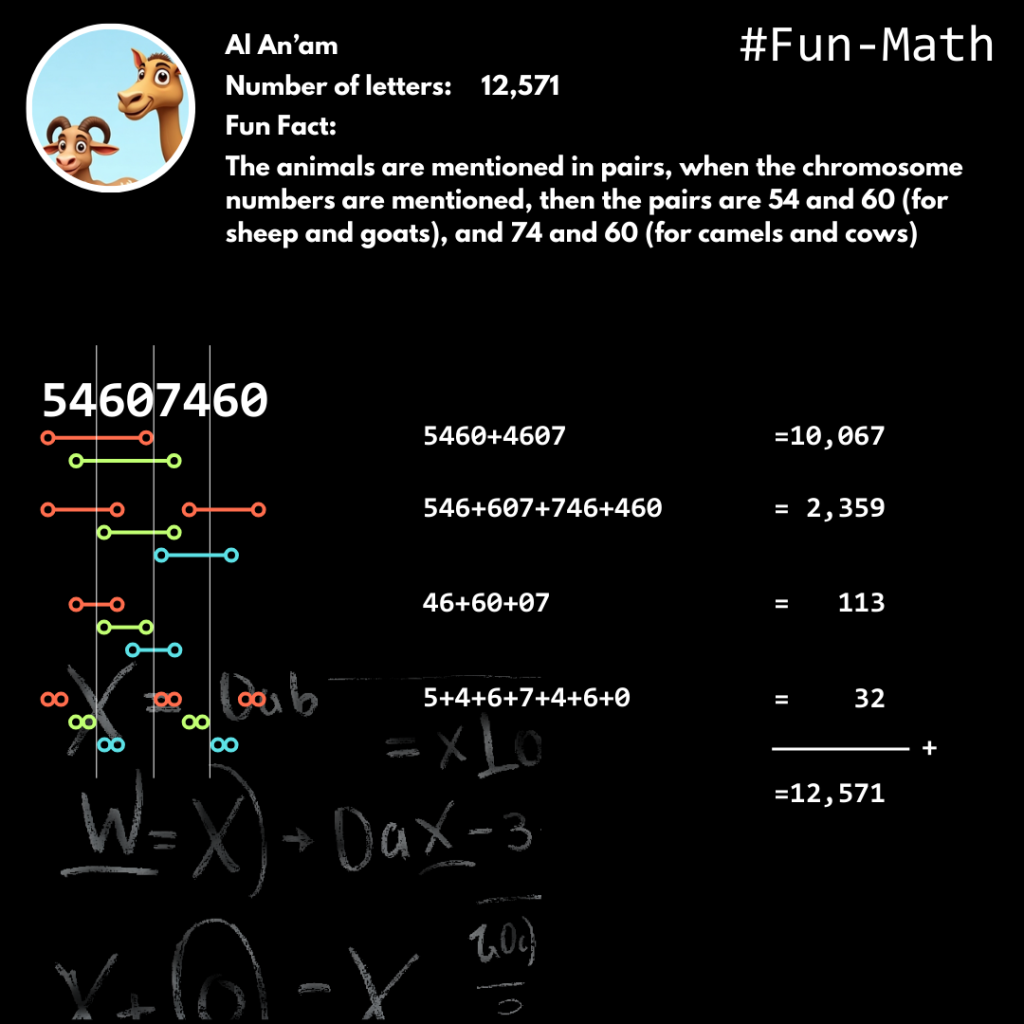
Al An’am
Number of letters:
12,571
Fun Fact:
The animals are mentioned in pairs, when the chromosome numbers are mentioned, then the pairs are 54 and 60 (for sheep and goats), and 74 and 60 (for camels and cows)
54607460
5460+4607 + 546+607+746+460 + 46+60+07 + 5+4+6+7+4+6+0 = 12,571
- The Cattle
- Binatang Ternak
The Cattle is mentioned in Quran Chapter 6. In fact, Chapter 6 of the Quran is named “Al-An’am” (The Cattle). The animals are mentioned in pairs: sheep and goats, and camels and cattle. Interestingly, when their chromosome numbers are mentioned, the pairs are:
54 and 60 (for sheep and goats), and
74 and 60 (for camels and cows).
A chromosome number of 60 is shared by both goats and cattle, even though they are entirely different animals. However, both are ruminants. All of the mentioned ruminants—sheep, goats, and cattle—have a chromosome count that’s divisible by 6, as their GCD (Greatest Common Divisor) is 6.
Notes:
The Cattle means domesticated animals on a farm like oxen/cow, sheep, goat, camel, etc; Cattle means oxen/cow;
˹Allah has created˺ four pairs: a pair of sheep and a pair of goats—ask ˹them, O Prophet˺, “Has He forbidden ˹to you˺ the two males or the two females or what is in the wombs of the two females? Tell me with knowledge, if what you say is true.” and a pair of camels and a pair of cattle. Ask ˹them˺, “Has He forbidden ˹to you˺ the two males or the two females or what is in the wombs of the two females? Or were you present when Allah gave you this commandment?” Who does more wrong than those who fabricate lies against Allah to mislead others without ˹any˺ knowledge? Surely Allah does not guide the wrongdoing people.
Al An’am 6:143-144
Some animals are grouped together for convenience, but they have distinct biological characteristics, as seen in their chromosome numbers. For example, sheep and goats are often seen together, but they have different chromosome counts: 54 [archive] for sheep and 60 [archive] for goats. Similarly, camels and cattle are distinct species, with camels having 74 [archive] chromosomes and cattle having 60 [archive]. This difference in genetic material is a key factor in why these animals cannot interbreed successfully.
Lineage:
Eukaryota – Metazoa – Chordata – Mammalia – Artiodactyla:
– Camelidae: Camelus (camel)
– Bovidae: Ovis (sheep), Bos (cattle), Capra (goat)
The significant difference in chromosome numbers is the primary reason why sheep and goats cannot produce fertile offspring. Although they can sometimes be crossbred to create a hybrid known as a “geep,” [archive] this offspring is almost always sterile. The mismatch in chromosome numbers (27 pairs from one parent and 30 from the other) prevents the proper pairing of chromosomes during the formation of reproductive cells, making the hybrid unable to reproduce. This genetic barrier ensures that these two species remain distinct.
In contrast, a unique connection exists between goats and cattle: they both have 60 chromosomes. Even with this identical number, they are entirely different animals and cannot interbreed. This is because their chromosomes contain different genes arranged in different ways. Both goats and cattle are classified as ruminants, a group of animals with a four-chambered stomach specialized for digesting tough plant material. This shared digestive system is a key biological similarity that links them.
While cattle, goats, and sheep are all true ruminants, camels are an interesting exception. They are often called pseudo-ruminants because they also have a multi-chambered stomach, but with only three compartments instead of four. This biological difference highlights how a shared characteristic, like digesting plant matter, can be achieved through different evolutionary pathways. This helps to further categorize these animals beyond their superficial similarities.
In-depth information retrieval using AI and website.
Hewan ternak disebutkan dalam Al-Qur’an Surat 6. Faktanya, Surat 6 dalam Al-Qur’an dinamakan “Al-An’am” (Hewan Ternak). Hewan-hewan tersebut disebutkan secara berpasangan: domba dan kambing, serta unta dan sapi. Menariknya, jika disebutkan berdasarkan jumlah kromosomnya, pasangan-pasangan tersebut adalah:
54 dan 60 (untuk domba dan kambing)
74 dan 60 (untuk unta dan sapi)
Jumlah kromosom 60 dimiliki bersama oleh kambing dan sapi, meskipun keduanya adalah hewan yang sama sekali berbeda. Namun, keduanya adalah hewan ruminansia. Semua hewan ruminansia yang disebutkan—domba, kambing, dan sapi—memiliki jumlah kromosom yang dapat dibagi dengan 6, di mana FPB (Faktor Persekutuan Terbesarnya)-nya adalah 6.
Ada delapan hewan ternak yang berpasangan (empat pasang); sepasang domba dan sepasang kambing. Katakanlah, “Apakah yang diharamkan Allah dua yang jantan atau dua yang betina atau yang ada dalam kandungan kedua betinanya? Terangkanlah kepadaku berdasar pengetahuan jika kamu orang yang benar.” Dan dari unta sepasang dan dari sapi sepasang. Katakanlah, “Apakah yang diharamkan dua yang jantan atau dua yang betina, atau yang ada dalam kandungan kedua betinanya? Apakah kamu menjadi saksi ketika Allah menetapkan ini bagimu? Siapakah yang lebih zalim daripada orang-orang yang mengada-adakan kebohongan terhadap Allah untuk menyesatkan orang-orang tanpa pengetahuan?” Sesungguhnya Allah tidak akan memberi petunjuk kepada orang-orang yang zalim.
Al An’am 6:143-144
Beberapa hewan dikelompokkan bersama demi kenyamanan, tetapi mereka memiliki karakteristik biologis yang berbeda, seperti yang terlihat pada jumlah kromosomnya. Sebagai contoh, domba dan kambing sering terlihat bersama, tetapi mereka memiliki jumlah kromosom yang berbeda: 54 [archive] untuk domba dan 60 [archive] untuk kambing. Demikian pula, unta dan sapi adalah spesies yang berbeda, dengan unta memiliki 74 [archive] kromosom dan sapi memiliki 60 [archive]. Perbedaan materi genetik ini adalah faktor kunci mengapa hewan-hewan ini tidak dapat berkembang biak dengan sukses.
Silsilah:
Eukaryota – Metazoa – Chordata – Mammalia – Artiodactyla:
– Camelidae: Camelus (unta)
– Bovidae: Ovis (domba), Bos (sapi), Capra (kambing)
Perbedaan signifikan dalam jumlah kromosom adalah alasan utama mengapa domba dan kambing tidak dapat menghasilkan keturunan yang subur. Meskipun terkadang mereka dapat disilangkan untuk menghasilkan hibrida yang dikenal sebagai “geep,” [archive] keturunan ini hampir selalu steril. Ketidaksesuaian jumlah kromosom (27 pasang dari satu induk dan 30 dari induk lainnya) mencegah penyatuan kromosom yang tepat selama pembentukan sel reproduksi, membuat hibrida tidak mampu bereproduksi. Hambatan genetik ini memastikan bahwa kedua spesies ini tetap terpisah.
Sebaliknya, ada hubungan unik antara kambing dan sapi: keduanya memiliki 60 kromosom. Bahkan dengan jumlah yang identik ini, mereka adalah hewan yang sama sekali berbeda dan tidak dapat saling kawin. Ini karena kromosom mereka mengandung gen yang berbeda yang tersusun dengan cara yang berbeda pula. Baik kambing maupun sapi digolongkan sebagai ruminansia, kelompok hewan dengan perut empat ruang yang khusus untuk mencerna bahan tumbuhan yang sulit. Sistem pencernaan yang sama ini adalah kesamaan biologis utama yang menghubungkan mereka.
Sementara sapi, kambing, dan domba semuanya adalah ruminansia sejati, unta adalah pengecualian yang menarik. Mereka sering disebut pseudo-ruminansia karena mereka juga memiliki perut multi-ruang, tetapi hanya dengan tiga kompartemen, bukan empat. Perbedaan biologis ini menyoroti bagaimana karakteristik yang sama, seperti mencerna bahan tumbuhan, dapat dicapai melalui jalur evolusi yang berbeda. Ini membantu untuk lebih lanjut mengkategorikan hewan-hewan ini di luar kemiripan luarnya.
Penggalian informasi mendalam dengan bantuan AI dan situs web.
The thunder is mentioned in Quran Chapter 13. In fact, Chapter 13 of the Quran is named “Ar-Ra’d” (The Thunder). Thunder and lightning actually occur at the same time and place. Lightning contributes to fertilizing the soil indirectly with the nitrate ion (NO3−, 1 atom of N and 3 atom of O) through a process called atmospheric nitrogen fixation, as follows:
Fun Fact: The Thunder (Ar Ra’d)
N2(g) + O2(g) —lightning⟶ 2NO(g)
2NO(g) + O2(g) → 2NO2(g)
2NO2(g) + H2O(l) → HNO3(aq) + HNO2(aq)
HNO3(aq) → H+(aq) + NO3−(aq)

Guruh disebutkan dalam Al-Qur’an Surah 13. Bahkan, Surah ke-13 dalam Al-Qur’an dinamai “Ar-Ra’d” (Guruh). Guruh dan petir sebenarnya terjadi pada waktu dan tempat yang sama. Petir berkontribusi dalam menyuburkan tanah secara tidak langsung dengan ion nitrat (NO3−, 1 atom N dan 3 atom O) melalui proses yang disebut fiksasi nitrogen atmosfer, sebagai berikut:
Fun Fact: Guruh (Ar Ra’d)
N2(g) + O2(g) —petir⟶ 2NO(g)
2NO(g) + O2(g) → 2NO2(g)
2NO2(g) + H2O(l) → HNO3(aq) + HNO2(aq)
HNO3(aq) → H+(aq) + NO3−(aq)
Quran Chapter 13, Verse 4 highlights how fruits and crops, despite being irrigated with the same water, can vary in taste and quality, influenced by carbon in the soil. Quran Chapter 13, Verse 12 speaks of divine signs like thunder and lightning, which contribute to the nitrogen cycle by producing nitrogen compounds that fertilize the earth and support life, underscoring the interconnectedness of natural forces. Both carbon and nitrogen, with atomic numbers 6 and 7, are essential for the fertility of the earth and the development of life and flavor.
Fun Fact: The Thunder (Ar Ra’d)

Al-Qur’an Surah ke-13 Ayat 4 menyoroti bagaimana buah-buahan dan tanaman, meskipun diairi dengan air yang sama, dapat bervariasi rasa dan kualitasnya, dipengaruhi oleh karbon di dalam tanah. Karbon, sebagai bahan organik, memengaruhi ketersediaan nutrisi, retensi air, dan aktivitas mikroba, yang semuanya krusial untuk pengembangan rasa. Al-Qur’an Surah ke-13 Ayat 12 berbicara tentang tanda-tanda ilahi seperti guntur dan kilat, yang berkontribusi pada siklus nitrogen dengan menghasilkan senyawa nitrogen yang menyuburkan bumi dan menopang kehidupan, menggarisbawahi keterkaitan kekuatan alam. Baik karbon maupun nitrogen, dengan nomor atom 6 dan 7, sangat penting untuk kesuburan bumi serta pengembangan kehidupan dan rasa.
Fun Fact: Guruh (Ar Ra’d)
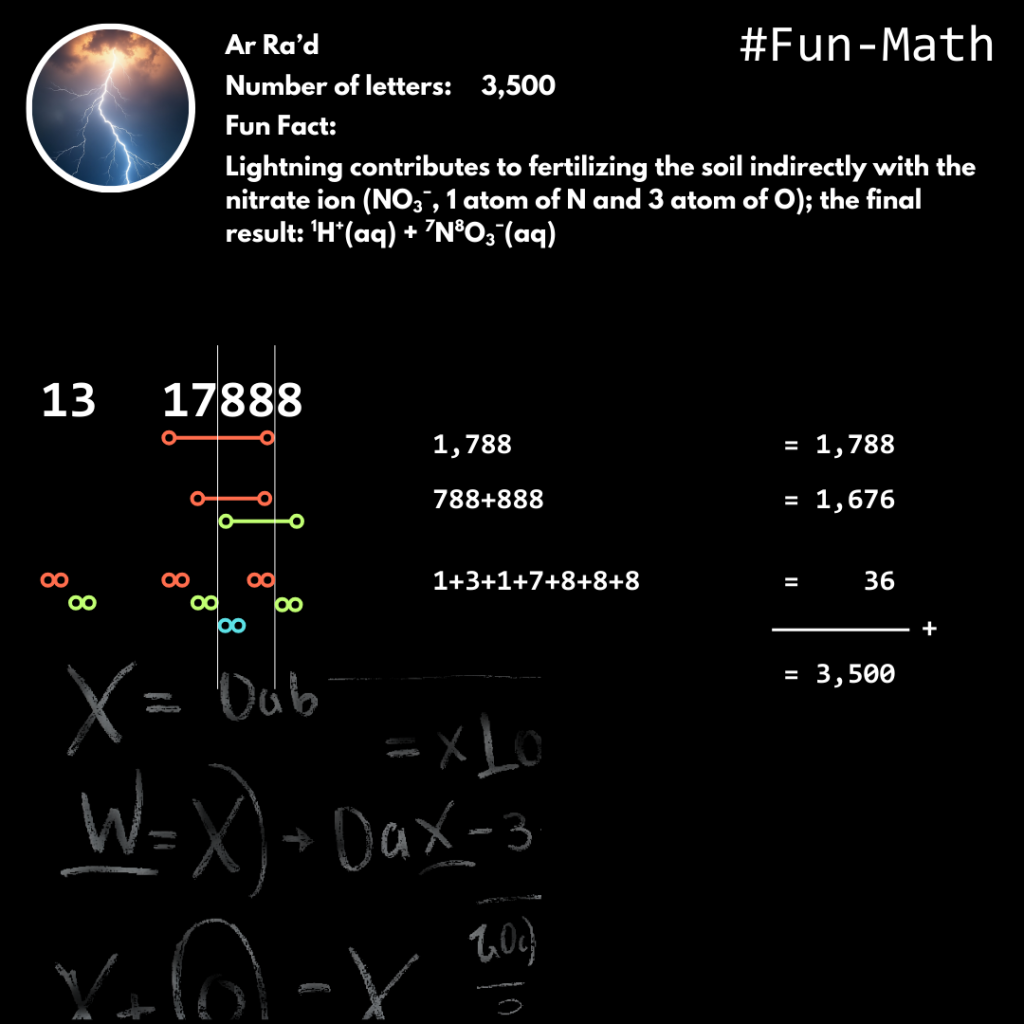
Ar Ra’d
Number of letters:
3,500
Fun Fact:
Lightning contributes to fertilizing the soil indirectly with the nitrate ion (NO3−, 1 atom of N and 3 atom of O); the final result: 1H+(aq) + 7N8O3−(aq)
13 17888
1,788 + 788+888 + 1+3+1+7+8+8+8 = 3,500
#Fun-Math
- The Thunder
- Guruh
Quran Chapter 13, Verse 4 highlights how fruits and crops, despite being irrigated with the same water, can vary in taste and quality, influenced by carbon in the soil. Carbon, as organic matter, impacts nutrient availability, water retention [archive], and microbial activity, all crucial for flavor development. Quran Chapter 13, Verse 12 speaks of divine signs like thunder and lightning, which contribute to the nitrogen cycle by producing nitrogen compounds that fertilize the earth and support life, underscoring the interconnectedness of natural forces. Both carbon and nitrogen, with atomic numbers 6 and 7, are essential for the fertility of the earth and the development of life and flavor.
And on the earth there are ˹different˺ neighbouring tracts, gardens of grapevines, ˹various˺ crops, palm trees—some stemming from the same root, others standing alone. They are all irrigated with the same water, yet We make some taste better than others. Surely in this are signs for those who understand.
Ar Ra’d 13:4
Nitrogen
The Earth’s atmosphere is composed of several gases, but nitrogen (N₂) and oxygen (O₂) are the most abundant, together making up about 99% of the total atmospheric content. These two elements play a central role in sustaining life on Earth and maintaining the balance of our ecosystem.
Nitrogen accounts for approximately 78% of the atmosphere. It is chemically inert in its molecular form (N₂), meaning it does not readily react with other compounds. This inertness makes it ideal for maintaining the stability of the atmosphere, ensuring that processes like respiration and combustion can occur without destabilizing the environment.
Oxygen makes up about 21% of the atmosphere. It is highly reactive and plays a vital role in respiration, combustion, and oxidation reactions, all of which are fundamental to life on Earth. Oxygen also reacts with other elements to form essential compounds like water (H₂O) and carbon dioxide (CO₂), which are central to the processes of photosynthesis and respiration in living organisms.
Together, nitrogen and oxygen are the backbone of the Earth’s biogeochemical cycles, providing the necessary components for plant, animal, and microbial life.
Nitrogen oxides (NO and NO₂) are gases formed when nitrogen (N₂) and oxygen (O₂) in the atmosphere react under conditions of high energy. One such event that generates these reactions is lightning. During a lightning strike, temperatures can reach up to 30,000 Kelvin (53,540°F), hot enough to break the bonds between nitrogen and oxygen molecules. This extreme heat leads to the formation of nitrogen oxides . These nitrogen oxides (NO and NO₂) are then carried by atmospheric currents and can dissolve in water vapor, falling to Earth as nitric acid (HNO3) and nitrous acid (HNO2).
Once in the soil, it dissociates, releasing the nitrate ion (NO₃⁻). Nitrates are a form of nitrogen that plants can readily absorb and use to synthesize essential proteins and amino acids. The nitrates deposited by lightning-induced rain become part of the soil’s nitrogen content, providing a natural source of nutrients for plants and promoting soil fertility.
Beyond fertilization, the presence of nitrogen oxides in the atmosphere also has a slight acidifying effect on the soil. As nitric acid (HNO₃) forms from nitrogen oxides and water vapor, it can lower the pH of the soil. While small amounts of acidity are beneficial for some plants, excessive acidification can harm certain crops and ecosystems. This is an example of how the balance of natural processes is vital for maintaining a healthy environment.
Carbon
The carbon content in soil has a significant and multifaceted impact on the taste of fruit. This is primarily through its role in soil organic matter and the soil microbiome [1 archive, 2 archive, 3 archive], both of which profoundly influence nutrient availability, water retention, and overall plant health.
The foundational element here is soil organic carbon (SOC), which forms the very essence of healthy, vibrant soil. It’s not just inert material; rather, it represents the living, breathing component of the soil system, derived from the decomposition of countless generations of plant and animal residues, along with the biomass of the microscopic life that teems within. This rich organic matter serves as an extraordinary nutrient reservoir, a biological “bank” that meticulously stores essential plant nutrients. Unlike synthetic fertilizers that offer a rapid, often fleeting, burst of nutrients, the decomposition of organic matter ensures a gradual, sustained release of these vital elements – nitrogen, phosphorus, potassium, and a spectrum of micronutrients like boron and zinc. This steady, balanced nutrient supply is paramount because it directly fuels the plant’s metabolic machinery. It’s the engine for photosynthesis, enabling the plant to produce the very sugars that define a fruit’s sweetness. It supports the synthesis of organic acids, which are critical for the pleasant tartness and overall balance that makes a fruit truly palatable. Furthermore, this consistent nutrient stream allows for the intricate creation of volatile organic compounds (VOCs) – the complex, aromatic molecules that give each fruit its unique fragrance and contribute profoundly to its perceived flavor. Without this stable nutrient delivery, fruits can often taste bland, exhibit underdeveloped sweetness, or lack their characteristic aromatic complexity.
Beyond its role as a nutrient custodian, soil organic carbon profoundly enhances the soil’s water-holding capacity. Imagine it as a giant, incredibly efficient sponge woven throughout the soil structure. This remarkable ability to absorb and retain water is a game-changer for fruit quality. It acts as a crucial buffer, protecting fruit development from the detrimental effects of both drought stress and excessive moisture. During dry spells, this stored water is slowly released to the plant’s roots, preventing the plant from experiencing the severe stress that can result in smaller, tougher fruits with concentrated, sometimes unpleasant, flavors. Conversely, in periods of heavy rain, the improved soil structure fostered by organic carbon allows for better drainage, preventing waterlogging that can suffocate roots and lead to disease, again compromising fruit quality. A consistent, well-regulated water supply ensures that fruit cells expand properly and sugars are efficiently transported, resulting in juicy, plump fruits with a consistent, delightful taste.
Crucially, soil organic carbon is the lifeblood of the soil microbiome. It provides the primary food source and the intricate architecture for the vast, diverse communities of bacteria, fungi, archaea, and other microorganisms that call the soil home. These microscopic allies are not merely passive residents; they are active partners in the plant’s growth and taste development. Many microbes tirelessly work to solubilize nutrients, converting insoluble forms of elements like phosphorus into plant-available compounds. Others engage in the remarkable process of nitrogen fixation, pulling inert nitrogen gas from the atmosphere and transforming it into usable forms for plants. Beyond basic nutrient acquisition, there’s growing evidence that the soil microbiome can directly influence a plant’s secondary metabolism, subtly guiding the production of compounds that are not strictly for survival but are key to defense, communication, and, most relevantly, flavor. This might involve the production of phytohormones that fine-tune ripening, or even direct precursors to those very VOCs that delight our senses. A thriving, diverse microbial community also bolsters overall plant health and resilience, making the plant less susceptible to pests and diseases. A less stressed plant can then dedicate more energy and resources to developing highly flavorful fruits.
Finally, soil organic carbon significantly improves soil structure and aeration. By binding tiny soil particles into stable aggregates, it creates a porous environment. These pores allow for optimal air circulation, providing the oxygen essential for healthy root respiration and efficient nutrient uptake. They also ensure proper water infiltration and drainage, preventing root damage from compaction or anaerobic conditions. Healthy, well-aerated roots are fundamental to a plant’s ability to absorb everything it needs from the soil, directly impacting the intricate biochemical processes that culminate in the superior sweetness, acidity, and complex aromas of a truly delicious fruit.
Based on the comprehensive review [archive], the sweetness of grape berries is fundamentally a story of carbon accumulation. Essentially, all the carbon that forms the sweet-tasting sugars is imported from the leaves. Through photosynthesis, leaves fix atmospheric carbon dioxide into sucrose, which is then transported via the phloem to the developing berry. The berry’s sweetness is not determined by the leaf’s ability to produce sugar but by the berry’s own highly regulated capacity to unload, process, and store this imported carbon.
The fate of this carbon changes dramatically at a key developmental stage called véraison, which marks the onset of ripening. Before véraison, most imported carbon is used for growth or channeled into metabolic pathways that produce organic acids, primarily malic acid, making the berry tart. At véraison, a major shift occurs: the berry switches its phloem unloading strategy and its internal metabolism. Now, the imported sucrose is systematically broken down into the hexose sugars glucose and fructose, which are then actively transported for storage.
This final step of storing sugars is managed by specialized transport proteins. Families of transporters like SUTs, HTs, and most importantly, TMTs and SWEETs, act as gatekeepers, moving the hexose sugars across the plasma membrane and into the vacuole of the berry’s flesh cells. Here, they accumulate to extremely high concentrations. Therefore, a grape’s sweetness is the direct result of this efficient, multi-stage process of carbon import, metabolic conversion, and active transport into storage within the berry.
In-depth information retrieval using AI and website.
Al-Qur’an Surah ke-13 Ayat 4 menyoroti bagaimana buah-buahan dan tanaman, meskipun diairi dengan air yang sama, dapat bervariasi rasa dan kualitasnya, dipengaruhi oleh karbon di dalam tanah. Karbon, sebagai bahan organik, memengaruhi ketersediaan nutrisi, retensi air [archive], dan aktivitas mikroba, yang semuanya krusial untuk pengembangan rasa. Al-Qur’an Surah ke-13 Ayat 12 berbicara tentang tanda-tanda ilahi seperti guntur dan kilat, yang berkontribusi pada siklus nitrogen dengan menghasilkan senyawa nitrogen yang menyuburkan bumi dan menopang kehidupan, menggarisbawahi keterkaitan kekuatan alam. Baik karbon maupun nitrogen, dengan nomor atom 6 dan 7, sangat penting untuk kesuburan bumi serta pengembangan kehidupan dan rasa.
Dan di bumi ini terdapat bagian-bagian yang berdampingan dan kebun-kebun anggur, tanaman-tanaman dan pohon kurma yang bercabang, dan yang tidak bercabang disirami dengan air yang sama. Kami melebihkan sebagian tanam-tanaman itu atas sebagian yang lain tentang rasanya. Sesungguhnya pada yang demikian itu terdapat tanda-tanda (kebesaran Allah) bagi kaum yang berpikir.
Ar Ra’d 13:4
Nitrogen
Atmosfer Bumi terdiri dari beberapa gas, tetapi nitrogen (N₂) dan oksigen (O₂) adalah yang paling melimpah, bersama-sama membentuk sekitar 99% dari total kandungan atmosfer. Kedua elemen ini memainkan peran sentral dalam menopang kehidupan di Bumi dan menjaga keseimbangan ekosistem kita.
Nitrogen menyumbang sekitar 78% dari atmosfer. Dalam bentuk molekuler (N₂), ia secara kimiawi inert, artinya tidak mudah bereaksi dengan senyawa lain. Kelembaman ini membuatnya ideal untuk menjaga stabilitas atmosfer, memastikan bahwa proses seperti respirasi dan pembakaran dapat terjadi tanpa mengganggu lingkungan.
Oksigen membentuk sekitar 21% dari atmosfer. Ia sangat reaktif dan memainkan peran penting dalam respirasi, pembakaran, dan reaksi oksidasi, yang semuanya fundamental bagi kehidupan di Bumi. Oksigen juga bereaksi dengan elemen lain membentuk senyawa penting seperti air (H₂O) dan karbon dioksida (CO₂), yang merupakan pusat proses fotosintesis dan respirasi pada organisme hidup.
Bersama-sama, nitrogen dan oksigen adalah tulang punggung siklus biogeokimia Bumi, menyediakan komponen yang diperlukan untuk kehidupan tumbuhan, hewan, dan mikroba.
Nitrogen oksida (NO dan NO₂) adalah gas yang terbentuk ketika nitrogen (N₂) dan oksigen (O₂) di atmosfer bereaksi dalam kondisi energi tinggi. Salah satu peristiwa yang menghasilkan reaksi ini adalah petir. Selama sambaran petir, suhu dapat mencapai 30.000 Kelvin (53.540°F), cukup panas untuk memutus ikatan antara molekul nitrogen dan oksigen. Panas ekstrem ini mengarah pada pembentukan nitrogen oksida. Nitrogen oksida (NO dan NO₂) ini kemudian dibawa oleh arus atmosfer dan dapat larut dalam uap air, jatuh ke Bumi sebagai asam nitrat (HNO3) and asam nitrit (HNO2) saat hujan.
Begitu sampai di tanah, itu terurai, melepaskan ion nitrat (NO₃⁻). Nitrat adalah bentuk nitrogen yang dapat dengan mudah diserap dan digunakan tanaman untuk mensintesis protein dan asam amino esensial. Nitrat yang diendapkan oleh hujan yang diinduksi petir menjadi bagian dari kandungan nitrogen tanah, menyediakan sumber nutrisi alami bagi tanaman dan meningkatkan kesuburan tanah.
Di luar pemupukan, keberadaan nitrogen oksida di atmosfer juga memiliki efek pengasaman ringan pada tanah. Karena asam nitrat (HNO₃) terbentuk dari nitrogen oksida dan uap air, ia dapat menurunkan pH tanah. Meskipun sejumlah kecil keasaman bermanfaat bagi beberapa tanaman, pengasaman yang berlebihan dapat membahayakan tanaman dan ekosistem tertentu. Ini adalah contoh bagaimana keseimbangan proses alami sangat penting untuk menjaga lingkungan yang sehat.
Karbon
Kandungan karbon di dalam tanah memiliki dampak signifikan dan multifaset terhadap rasa buah. Hal ini terutama melalui perannya dalam bahan organik tanah dan mikrobioma tanah [1 archive, 2 archive, 3 archive], yang keduanya sangat memengaruhi ketersediaan nutrisi, retensi air, dan kesehatan tanaman secara keseluruhan.
Elemen dasar di sini adalah karbon organik tanah (SOC), yang membentuk inti dari tanah yang sehat dan subur. Ini bukan hanya materi inert; sebaliknya, ia mewakili komponen hidup dan bernapas dari sistem tanah, yang berasal dari dekomposisi sisa-sisa tumbuhan dan hewan yang tak terhitung jumlahnya selama beberapa generasi, bersama dengan biomassa kehidupan mikroskopis yang berlimpah di dalamnya. Bahan organik yang kaya ini berfungsi sebagai penyimpanan nutrisi yang luar biasa, sebuah “bank” biologis yang dengan cermat menyimpan nutrisi penting bagi tanaman. Berbeda dengan pupuk sintetis yang menawarkan pasokan nutrisi yang cepat, seringkali singkat, dekomposisi bahan organik memastikan pelepasan unsur-unsur vital ini secara bertahap dan berkelanjutan – nitrogen, fosfor, kalium, dan spektrum mikronutrien seperti boron dan seng. Pasokan nutrisi yang stabil dan seimbang ini sangat penting karena secara langsung memicu mekanisme metabolisme tanaman. Ini adalah mesin untuk fotosintesis, memungkinkan tanaman menghasilkan gula yang menentukan kemanisan buah. Ini mendukung sintesis asam organik, yang sangat penting untuk rasa asam yang menyenangkan dan keseimbangan keseluruhan yang membuat buah benar-benar lezat. Selain itu, aliran nutrisi yang konsisten ini memungkinkan penciptaan senyawa organik volatil (VOC) yang rumit – molekul aromatik kompleks yang memberikan aroma unik pada setiap buah dan berkontribusi besar pada rasa yang dirasakan. Tanpa pengiriman nutrisi yang stabil ini, buah seringkali terasa hambar, menunjukkan kemanisan yang kurang berkembang, atau kehilangan kompleksitas aromatik khasnya.
Di luar perannya sebagai penjaga nutrisi, karbon organik tanah secara mendalam meningkatkan kapasitas retensi air tanah. Bayangkan sebagai spons raksasa yang sangat efisien yang terjalin di seluruh struktur tanah. Kemampuan luar biasa untuk menyerap dan menahan air ini adalah pengubah permainan untuk kualitas buah. Ini bertindak sebagai penyangga krusial, melindungi perkembangan buah dari efek merugikan dari stres kekeringan dan kelembaban berlebihan. Selama musim kemarau, air yang tersimpan ini perlahan-lahan dilepaskan ke akar tanaman, mencegah tanaman mengalami stres parah yang dapat mengakibatkan buah lebih kecil, lebih keras, atau kurang berair dengan rasa yang terkonsentrasi, kadang-kadang tidak menyenangkan. Sebaliknya, pada periode hujan lebat, struktur tanah yang lebih baik yang didukung oleh karbon organik memungkinkan drainase yang lebih baik, mencegah genangan air yang dapat mencekik akar dan menyebabkan penyakit, yang kembali mengorbankan kualitas buah. Pasokan air yang konsisten dan diatur dengan baik memastikan bahwa sel-sel buah mengembang dengan benar dan gula diangkut secara efisien, menghasilkan buah yang berair, montok dengan rasa yang konsisten dan menyenangkan.
Sangat penting, karbon organik tanah adalah urat nadi mikrobioma tanah. Ini menyediakan sumber makanan utama dan arsitektur rumit untuk komunitas bakteri, jamur, arkea, protozoa, nematoda, dan mikroorganisme lain yang beragam dan luas yang mendiami tanah. Sekutu mikroskopis ini bukan hanya penghuni pasif; mereka adalah mitra aktif dalam pertumbuhan tanaman dan pengembangan rasa. Banyak mikroba tanpa lelah bekerja untuk melarutkan nutrisi, mengubah bentuk unsur yang tidak larut seperti fosfor menjadi senyawa yang tersedia bagi tanaman. Yang lain terlibat dalam proses luar biasa fiksasi nitrogen, menarik gas nitrogen inert dari atmosfer dan mengubahnya menjadi bentuk yang dapat digunakan tanaman. Di luar akuisisi nutrisi dasar, ada bukti yang berkembang bahwa mikrobioma tanah dapat secara langsung memengaruhi metabolisme sekunder tanaman – produksi senyawa yang tidak mutlak untuk kelangsungan hidup dasar tetapi kunci untuk pertahanan, komunikasi, dan, yang paling relevan, rasa. Ini mungkin melibatkan produksi fitohormon yang menyempurnakan pematangan, atau bahkan prekursor langsung dari VOC yang menyenangkan indra kita. Komunitas mikroba yang berkembang pesat dan beragam juga mendukung kesehatan dan ketahanan tanaman secara keseluruhan, membuat tanaman kurang rentan terhadap hama dan penyakit. Tanaman yang tidak terlalu stres kemudian dapat mendedikasikan lebih banyak energi dan sumber daya untuk mengembangkan buah yang sangat beraroma.
Terakhir, karbon organik tanah secara signifikan meningkatkan struktur dan aerasi tanah. Dengan mengikat partikel tanah kecil menjadi agregat yang stabil, ia menciptakan lingkungan berpori. Pori-pori ini memungkinkan sirkulasi udara yang optimal, menyediakan oksigen yang penting untuk respirasi akar yang sehat dan penyerapan nutrisi yang efisien. Mereka juga memastikan infiltrasi dan drainase air yang tepat, mencegah kerusakan akar akibat pemadatan atau kondisi anaerobik. Akar yang sehat dan beraerasi baik sangat mendasar bagi kemampuan tanaman untuk menyerap semua yang dibutuhkan dari tanah, secara langsung memengaruhi proses biokimia rumit yang memuncak pada kemanisan, keasaman, dan aroma kompleks yang unggul dari buah yang benar-benar lezat.
Berdasarkan tinjauan [archive] komprehensif, rasa manis buah anggur pada dasarnya adalah kisah tentang akumulasi karbon. Pada intinya, semua karbon yang membentuk gula berasa manis diimpor dari daun. Melalui fotosintesis, daun mengikat karbon dioksida atmosfer menjadi sukrosa, yang kemudian diangkut melalui floem ke buah anggur yang sedang berkembang. Manisnya buah anggur tidak ditentukan oleh kemampuan daun untuk memproduksi gula, melainkan oleh kapasitas buah anggur itu sendiri yang sangat teregulasi untuk membongkar, memproses, dan menyimpan karbon yang diimpor ini.
Nasib karbon ini berubah secara drastis pada tahap perkembangan utama yang disebut véraison, yang menandai dimulainya pematangan. Sebelum véraison, sebagian besar karbon yang diimpor digunakan untuk pertumbuhan atau disalurkan ke jalur metabolisme yang menghasilkan asam organik, terutama asam malat, membuat buah menjadi asam. Saat véraison, terjadi pergeseran besar: buah anggur mengubah strategi pembongkaran floem dan metabolisme internalnya. Sekarang, sukrosa yang diimpor secara sistematis dipecah menjadi gula heksosa glukosa dan fruktosa, yang kemudian secara aktif diangkut untuk disimpan.
Langkah terakhir untuk menyimpan gula ini dikelola oleh protein pengangkut khusus. Famili transporter seperti SUT, HT, dan yang paling penting, TMT dan SWEET, bertindak sebagai penjaga gerbang, memindahkan gula heksosa melintasi membran plasma dan masuk ke dalam vakuola sel-sel daging buah. Di sini, gula tersebut terakumulasi hingga konsentrasi yang sangat tinggi. Oleh karena itu, manisnya buah anggur adalah hasil langsung dari proses yang efisien dan bertahap ini, yaitu impor karbon, konversi metabolisme, dan pengangkutan aktif untuk disimpan di dalam buah anggur.
Penggalian informasi mendalam dengan bantuan AI dan situs web.
The bee is mentioned in Quran Chapter 16. In fact, Chapter 16 of the Quran is named “An-Nahl” (The Bee), and bees basically have 32 chromosomes (16 pairs) for females and 16 chromosomes for males.
Fun Fact: The Bee (An Nahl)

Lebah disebutkan dalam Al-Quran Surat ke 16. Bahkan, Surat 16 Al-Quran diberi nama “An-Nahl” (Lebah), dan lebah pada dasarnya memiliki 32 kromosom (16 pasang) untuk betina dan 16 kromosom untuk jantan.
Fun Fact: Lebah (An Nahl)
- Bee
- Lebah
The bee is mentioned in Quran Chapter 16. In fact, Chapter 16 of the Quran is named “An-Nahl” (The Bee), and bees basically have 32 chromosomes (16 pairs) for females and 16 chromosomes for males.
A honey bee’s chromosome number [archive] depends on its sex. Males have 16 chromosomes, while females have 32 chromosomes. This difference is due to a unique system of sex determination called haplodiploidy, which is found in all Hymenoptera insects, including bees, wasps, and ants.
Verses 68 and 69 specifically talk about the bee and its role, describing how Allah inspired the bee to build its hives in mountains, trees, and structures, and to eat from various fruits to produce honey, which is described as having healing properties.
In verse 69 there is a line:
…There emerges from their bellies/her (two) bellies (buṭūnihā) a drink (honey), varying in colors, in which there is healing for people…
An Nahl 16:69
The word “بُطُوْنِهَا” (buṭūnihā) is an Arabic word. Here’s a breakdown
بُطُوْن (buṭūn) is the plural of بَطْن (baṭn), which means belly or abdomen. هَا (hā) is a feminine singular possessive pronoun meaning her or its (referring to a feminine noun). So, buṭūnihā means “their bellies” or “her bellies” (if referring to multiple bellies belonging to a single feminine entity).
The use of “buṭūnihā” in this verse has led to various interpretations and discussions, particularly in the context of scientific compatibility with the Quran:
- Referring to multiple “stomachs” of a single female bee: Some interpretations highlight that “butuniha” (plural bellies, singular female pronoun) could subtly indicate that a single female bee has multiple internal compartments or “stomachs.” As we discussed, bees do indeed have two main internal compartments that function like stomachs: the honey stomach (crop) for nectar storage and the midgut for digestion. This is seen by some as a scientific marvel mentioned in the Quran long before modern biology.
- Referring to the bellies of the “bees” (plural, feminine grammatical gender): Other interpretations argue that “An-Nahl” (The Bees) is a collective noun, and while the pronoun “ha” is grammatically singular feminine, it can refer back to the collective plural “bees.” In this view, “butuniha” means “from their (the bees’) bellies,” acknowledging that honey comes from the collective effort of many bees, each with its own internal system. The use of feminine grammatical forms for the verbs preceding “butuniha” (like “kuli” – eat, and “usluki” – follow) also points to the female worker bees, which are indeed the honey producers.
Both interpretations highlight the Quran’s precision in language and its alignment with scientific facts discovered much later, particularly regarding the female bee’s role in honey production and its unique digestive system.
Fact:
The female bees foraging for nectar and pollen, then converting nectar into honey through a process of regurgitation and fanning to reduce water content. Female worker bees, like all honey bees, have two main “stomachs” that are distinct in their function. The male bees primary purpose is to mate with the queen. They do not collect nectar or pollen, do not produce honey, and do not have stingers. They are often larger than worker bees.
Directly inspired by an online video.
Lebah disebutkan dalam Al-Quran Surat ke 16. Bahkan, Surat 16 Al-Quran diberi nama “An-Nahl” (Lebah), dan lebah pada dasarnya memiliki 32 kromosom (16 pasang) untuk betina dan 16 kromosom untuk jantan.
Jumlah [archive] kromosom lebah madu bergantung pada jenis kelaminnya. Lebah jantan memiliki 16 kromosom, sedangkan lebah betina memiliki 32 kromosom. Perbedaan ini disebabkan oleh sistem penentuan jenis kelamin yang unik yang disebut haplodiploidy, yang ditemukan pada semua serangga Hymenoptera, termasuk lebah, tawon, dan semut.
Ayat 68 dan 69 secara khusus berbicara tentang lebah dan perannya, menggambarkan bagaimana Allah mengilhami lebah untuk membangun sarangnya di gunung, pohon, dan bangunan, dan memakan berbagai buah untuk menghasilkan madu, yang digambarkan memiliki khasiat penyembuhan.
Dalam ayat 69 terdapat kalimat:
…Dari perut lebah-lebah/perut-perut (dua perut) lebah betina (buṭūnihā) keluar minuman (madu) yang bermacam-macam warnanya, di dalamnya terdapat obat yang menyembuhkan bagi manusia…
An Nahl 16:69
Kata “بُطُوْنِهَا” (buṭūnihā) adalah kata dalam bahasa Arab. Berikut uraiannya:
بُطُوْن (buṭūn) adalah bentuk jamak dari بَطْن (baṭn), yang berarti perut atau abdomen. هَا (hā) adalah kata ganti kepemilikan tunggal feminin/betina yang berarti dia atau miliknya (merujuk pada kata benda feminin). Jadi, buṭūnihā berarti “perut lebah-lebah” atau “perut-perut lebah betina” (jika merujuk pada beberapa perut yang dimiliki oleh satu entitas betina).
Penggunaan “buṭūnihā” dalam ayat ini telah menimbulkan berbagai penafsiran dan diskusi, khususnya dalam konteks kesesuaian ilmiah dengan Al-Quran:
- Mengacu pada beberapa “perut” seekor lebah betina: Beberapa penafsiran menyoroti bahwa “butuniha” (jamak perut, kata ganti tunggal perempuan) dapat secara halus menunjukkan bahwa seekor lebah betina memiliki beberapa kompartemen internal atau “perut.” Seperti yang telah kita bahas, lebah memang memiliki dua kompartemen internal utama yang berfungsi seperti perut: perut madu (tembolok) untuk penyimpanan nektar dan usus tengah untuk pencernaan. Hal ini dipandang oleh sebagian orang sebagai keajaiban ilmiah yang disebutkan dalam Al-Quran jauh sebelum biologi modern.
- Mengacu pada perut “lebah” (jamak, jenis kelamin gramatikal feminin): Penafsiran lain berpendapat bahwa “An-Nahl” (Lebah) adalah kata benda kolektif, dan sementara kata ganti “ha” secara gramatikal feminin tunggal, ia dapat merujuk kembali ke bentuk jamak kolektif “lebah.” Dalam pandangan ini, “butuniha” berarti “dari perut mereka (lebah),” yang mengakui bahwa madu berasal dari usaha kolektif banyak lebah, masing-masing dengan sistem internalnya sendiri. Penggunaan bentuk tata bahasa feminin untuk kata kerja sebelum “butuniha” (seperti “kuli” – makan, dan “usluki” – mengikuti) juga menunjuk pada lebah pekerja betina, yang memang merupakan penghasil madu.
Fakta:
Lebah betina mencari nektar dan serbuk sari, kemudian mengubah nektar menjadi madu melalui proses regurgitasi dan pengipasan untuk mengurangi kadar air. Lebah pekerja betina, seperti semua lebah madu, memiliki dua “perut” utama yang fungsinya berbeda. Tujuan utama lebah jantan adalah untuk kawin dengan ratu. Mereka tidak mengumpulkan nektar atau serbuk sari, tidak menghasilkan madu, dan tidak memiliki sengat. Mereka sering kali lebih besar dari lebah pekerja.
Terinspirasi langsung dari sebuah video daring.
The cave is mentioned in Quran Chapter 18. In fact, Chapter 18 of the Quran is named “Al-Kahf” (The Cave). The story of Al-Kahf is about a group of young men who sought refuge in a cave and were put into a miraculous, prolonged sleep. A SNP rs1539808, located on chromosome 18 at position 5,978,932, has been identified as a candidate with the strongest effect on increasing sleep time (OBA:2040173). In one study, the T allele of this SNP showed a suggestive but not definitive association with the effect, with a p-value of 4e−6. Therefore, this finding requires replication in other studies to be confirmed as a true genetic link.
Fun Fact: The Cave (Al Kahf)

Gua tersebut disebutkan dalam Al-Qur’an Surat ke-18. Faktanya, Surat ke-18 dalam Al-Qur’an diberi nama “Al-Kahfi” (Gua). Kisah Al-Kahfi adalah tentang sekelompok pemuda yang mencari perlindungan di dalam gua dan ditidurkan. Sebuah SNP rs1539808, yang terletak pada kromosom 18 di posisi 5.978.932, telah diidentifikasi sebagai kandidat dengan efek terkuat dalam meningkatkan waktu tidur (OBA:2040173). Dalam sebuah penelitian, alel T dari SNP ini menunjukkan hubungan yang kuat namun belum definitif dengan efek tersebut, dengan nilai-p sebesar 4e-6. Oleh karena itu, temuan ini masih memerlukan replikasi dalam penelitian lain untuk dikonfirmasi sebagai hubungan genetik.
Fun Fact: Gua (Al Kahfi)
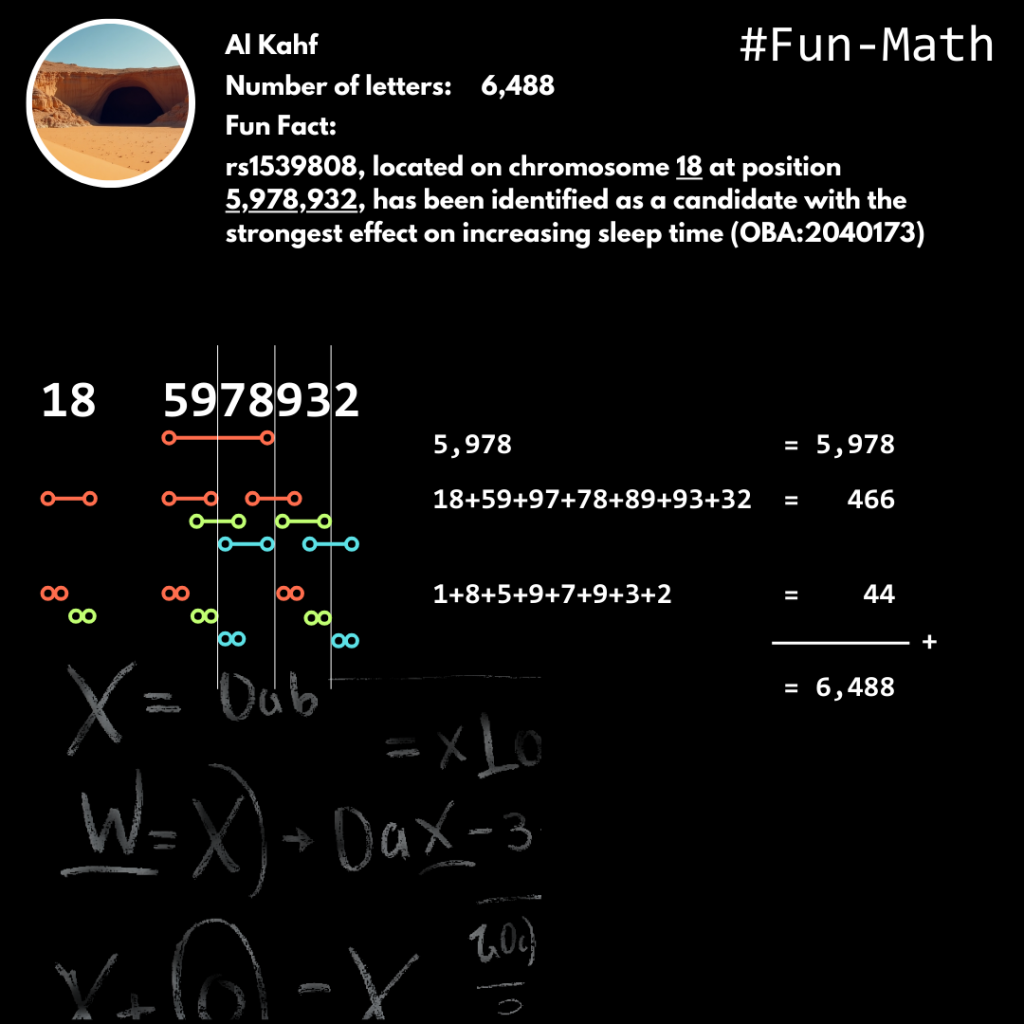
Al Kahf
Number of letters:
6,488
Fun Fact:
rs1539808, located on chromosome 18 at position 5,978,932, has been identified as a candidate with the strongest effect on increasing sleep time (OBA:2040173)
18 5978932
5,978 + 18+59+97+78+89+93+32 + 1+8+5+9+7+9+3+2 = 6,488
#Fun-Math
- The Cave
- Gua
The cave is mentioned in Quran Chapter 18. In fact, Chapter 18 of the Quran is named “Al-Kahfi” (The Cave). The story of Al-Kahf is about a group of young men who sought refuge in a cave and were put into a miraculous, prolonged sleep. A SNP rs1539808, located on chromosome 18 at position 5,978,932, has been identified as a candidate with the strongest effect on increasing sleep time (OBA:2040173). In one study, the T allele of this SNP showed a suggestive but not definitive association with the effect, with a p-value of 4e−6. Therefore, this finding requires replication in other studies to be confirmed as a true genetic link.
And you would have thought they were awake, though they were asleep. We turned them over, to the right and left, while their dog stretched his forelegs at the entrance. Had you looked at them, you would have certainly fled away from them, filled with horror.
Al Kahf 18:18
OBA:2040173 [archive] and EFO:0005274 represent terms from two different biological ontologies that serve distinct purposes. OBA:2040173 corresponds to the term “sleep onset quality,” a highly specific concept from an ontology designed for making granular biological assertions. This level of detail is used for precise scientific descriptions of a particular aspect of the sleep process. In contrast, EFO:0005274 represents the much broader term “sleep time” from the Experimental Factor Ontology (EFO). The EFO is primarily used for annotating and integrating data across large-scale databases, such as those used in genome-wide association studies (GWAS). Therefore, while both terms are related to sleep, OBA’s term is a specific measure of a sleep attribute, whereas EFO’s term is a more general category for organizing and searching experimental data.
The table from GCST002050 [archive] (taken: 2025-08-12) presents genetic variants (SNPs) associated with sleep time, specifically focusing on “sleep onset quality.” Each row represents a SNP with its risk allele, statistical metrics, mapped genes, and study details. The goal is to identify the best variant for increasing sleep time.
Caveats
- Rarity (RAF = 0.01) means only 1% of people carry this allele.
- Biological mechanism: The gene
L3MBTL4is not well-studied for sleep; experimental validation is needed. - Study limitations: All data come from one study (
GCST002050). Replication in independent cohorts would strengthen the finding.
Key Column Definitions
- Variant and risk allele: SNP ID + allele linked to the trait (e.g.,
rs722258-T= T allele of rs722258). - P-value: Statistical significance. Lower = stronger association (e.g.,
3 × 10⁻⁶= 1 in 3.3 million chance the result is random). - RAF: Risk allele frequency (population frequency of the risk allele).
- OR/Beta:
- OR (Odds Ratio): Not provided here (marked “-“).
- Beta: Effect size per risk allele copy. Positive Beta = trait increase; negative = decrease.
- CI: 95% Confidence Interval for Beta/OR. Narrower = more precise estimate.
- Mapped gene: Gene(s) near the SNP, potentially influencing the trait.
- Reported trait: Primary trait studied (“Sleep time”).
- Trait(s): Specific sub-trait (“sleep onset quality”).
- Study accession: Study ID (all from
GCST002050). - Location: Genomic position (chromosome:base pair).
Best Variant for Increasing Sleep Time: rs1539808-T
After analyzing all variants, rs1539808-T has the strongest effect on increasing sleep time. Below is a full breakdown of this SNP:
- Variant and risk allele:
rs1539808-T→ Risk allele = T. Carrying this allele increases sleep time.
- P-value:
4 × 10⁻⁶→ Highly significant (well below the standard genome-wide threshold of 5 × 10⁻⁸ for suggestive associations).
- RAF (Risk Allele Frequency):
0.01→ Extremely rare (only 1% of the population has this allele).
- Beta:
44.44 unit increase→ Each copy of the T allele adds 44.44 units of sleep time.- Units are unspecified but likely minutes (common in sleep studies).
- CI (Confidence Interval):
[25.55–63.33]→ True effect size is between +25.55 and +63.33 units (95% confidence). Does not cross 0, reinforcing reliability.
- Mapped gene:
L3MBTL4→ A gene involved in epigenetic regulation. While its role in sleep is unclear, it may influence circadian rhythms or neuronal function.
- Reported trait & Trait(s):
- Directly linked to increased “Sleep time” via improved “sleep onset quality” (quicker/more efficient sleep initiation).
- Study:
GCST002050→ Part of a large-scale genetic study (likely a GWAS meta-analysis).
- Location:
18:5978932→ Chromosome 18, position 5,978,932.
Why is rs1539808-T the Best?
- Largest effect size: +44.44 units per allele (vs. +8.39 for rs9804200-C and +8.82 for rs1478693-G).
- High precision: Tight confidence interval ([25.55–63.33]) despite rarity.
- Statistical rigor: P-value (4 × 10⁻⁶) is highly significant.
P = 4 × 10⁻⁶ means there is a 1 in 250,000 chance (0.0004%) that the observed association between the variant and sleep time occurred purely by random luck in the data. In other words, the false positive risk: extremely low (1 in 250,000).
In genetics (GWAS studies), the gold standard is P < 5 × 10⁻⁸ (due to multiple testing across millions of variants). 4 × 10⁻⁶ > 5 × 10⁻⁸, it means that the association is suggestive but not definitive. Could still be real, but requires replication in other studies.
Real-World Analogy:
Imagine a journal accepting papers only if findings are “1 in 20 million” reliable (5 × 10⁻⁸). Your result is “1 in 250,000” reliable (4 × 10⁻⁶).
Conclusion: Your paper gets rejected for top journals but is published in a mid-tier journal with a note: “Promising, but needs replication.”
Note: Many biologically important discoveries initially had P-values above 5 × 10⁻⁸ and were later confirmed!
Summary
The variant rs1539808-T is a rare genetic “switch” linked to ~44 extra minutes of sleep per night by improving how quickly you fall asleep. While few people have this allele, its impact is substantial and scientifically robust. If you carry the “T” allele of rs1539808 near the L3MBTL4 gene, your natural sleep duration may be significantly longer.
Note: Genetics is one factor in sleep. Environment (e.g., caffeine, stress) and other genes also play major roles
In-depth information retrieval using AI and website.
Gua tersebut disebutkan dalam Al-Qur’an Surat ke-18. Faktanya, Surat ke-18 dalam Al-Qur’an diberi nama “Al-Kahfi” (Gua). Kisah Al-Kahfi adalah tentang sekelompok pemuda yang mencari perlindungan di dalam gua dan ditidurkan. Sebuah SNP rs1539808, yang terletak pada kromosom 18 di posisi 5.978.932, telah diidentifikasi sebagai kandidat dengan efek terkuat dalam meningkatkan waktu tidur (OBA:2040173). Dalam sebuah penelitian, alel T dari SNP ini menunjukkan hubungan yang kuat namun belum definitif dengan efek tersebut, dengan nilai-p sebesar 4e-6. Oleh karena itu, temuan ini masih memerlukan replikasi dalam penelitian lain untuk dikonfirmasi sebagai hubungan genetik.
Dan kamu mengira mereka itu bangun, padahal mereka tidur; Dan kami balik-balikkan mereka ke kanan dan ke kiri, sedang anjing mereka mengunjurkan kedua lengannya di muka pintu gua. Dan jika kamu menyaksikan mereka tentulah kamu akan berpaling dari mereka dengan melarikan diri dan tentulah (hati) kamu akan dipenuhi dengan ketakutan terhadap mereka.
Al Kahfi 18:18
OBA:2040173 [archive] dan EFO:0005274 mewakili istilah dari dua ontologi biologis yang berbeda dengan tujuan yang tidak sama. OBA:2040173 adalah istilah “sleep onset quality” (kualitas awal tidur), sebuah konsep yang sangat spesifik dari ontologi yang dirancang untuk membuat pernyataan biologis yang terperinci. Tingkat detail ini digunakan untuk deskripsi ilmiah yang tepat mengenai aspek tertentu dari proses tidur. Sebaliknya, EFO:0005274 mewakili istilah yang jauh lebih luas, yaitu “sleep time” (waktu tidur), dari Experimental Factor Ontology (EFO). EFO utamanya digunakan untuk memberi anotasi dan mengintegrasikan data di seluruh basis data skala besar, seperti yang digunakan dalam studi asosiasi genom-lebar (GWAS). Oleh karena itu, meskipun kedua istilah tersebut berhubungan dengan tidur, istilah OBA adalah ukuran spesifik dari atribut tidur, sedangkan istilah EFO adalah kategori yang lebih umum untuk mengorganisir dan mencari data eksperimental.
Tabel dari studi GCST002050 [archive] (diakses 12 Agustus 2025) menunjukkan varian genetik (SNP) terkait durasi tidur, khususnya “sleep onset quality” (kualitas awal tidur). Setiap baris mewakili satu SNP beserta metrik terkait.
Peringatan Penting
- Kelangkaan (RAF = 0.01): Hanya 1% populasi membawa alel ini.
- Mekanisme biologis: Gen L3MBTL4 belum diteliti secara memadai untuk tidur – perlu validasi eksperimen.
- Keterbatasan studi: Data berasal dari satu sumber (GCST002050). Replikasi di kohort independen diperlukan.
Definisi Kolom
- Variant and risk allele: ID SNP + alel pengaruh (cth: rs722258-T).
- P-value: Signifikansi statistik (semakin rendah semakin kuat asosiasi).
- RAF: Frekuensi alel risiko dalam populasi.
- OR/Beta:
- OR (Odds Ratio) tidak tersedia
- Beta positif: peningkatan sifat; negatif: penurunan.
- CI: Selang kepercayaan 95% (semakin sempit semakin presisi).
- Mapped gene: Gen terdekat yang mungkin berpengaruh.
- Reported trait: Sifat utama (“Sleep time“).
- Trait(s): Sub-sifat (“sleep onset quality“).
- Study accession: ID studi.
- Location: Posisi genomik.
Varian Terbaik: rs1539808-T
- Alel risiko:
T (meningkatkan durasi tidur). - P-value:
4 × 10⁻⁶ (signifikan meski di atas standar emas GWAS 5 × 10⁻⁸). - RAF:
0.01 (sangat langka, hanya 1% dari populasi memiliki alel ini). - Beta:
+44.44 unit (setiap salinan alel T menambah ~44 menit tidur, menit umum digunakan dalam penelitian tentang tidur). - CI:
[25.55–63.33] (tidak mencakup 0, menunjukkan keandalan). - Gen terpetakan:
L3MBTL4 (regulasi epigenetik; peran tidur belum diketahui). - Mekanisme:
Meningkatkan sleep onset quality (efisiensi awal tidur). - Studi:
GCST002050→ Bagian dari penelitan gen skala besar (seperti analisis meta GWAS). - Location:
18:5978932→ Kromosom 18, posisi 5.978.932.
Alasan Keunggulan
- Efek terbesar (+44.44 unit), 5× lebih kuat daripada varian lain.
- Presisi tinggi (selang kepercayaan sempit) meskipun alel langka.
- P-value (4 × 10⁻⁶) menunjukkan risiko false positive rendah (1:250.000).
P = 4 × 10⁻⁶ berarti terdapat peluang 1 banding 250.000 (0,0004%) bahwa asosiasi teramati antara varian dan durasi tidur terjadi murni secara acak dalam data. Dengan kata lain, risiko false positive: sangat rendah (1 banding 250.000).
Dalam genetika (studi GWAS), standar emas adalah P < 5 × 10⁻⁸ (akibat pengujian berganda pada jutaan varian). 4 × 10⁻⁶ > 5 × 10⁻⁸, artinya asosiasi ini bersifat sugestif tetapi tidak definitif. Bisa saja nyata, tetapi memerlukan replikasi dalam studi lain.
Analogi Dunia Nyata:
Bayangkan sebuah jurnal hanya menerima makalah jika temuan memiliki keandalan “1 banding 20 juta” (5 × 10⁻⁸). Hasil anda memiliki keandalan “1 banding 250.000” (4 × 10⁻⁶).
Kesimpulan: Makalah anda ditolak oleh jurnal-jurnal top tetapi diterbitkan di jurnal mid-tier dengan catatan: “Menjanjikan, tetapi perlu replikasi.”
Catatan: Banyak penemuan biologis penting awalnya memiliki nilai-P di atas 5 × 10⁻⁸ dan kemudian dikonfirmasi!
Ringkasan
rs1539808-T adalah varian langka yang dikaitkan dengan peningkatan ~44 menit tidur per malam melalui perbaikan awal tidur. Dampaknya signifikan secara statistik meski mekanisme gen L3MBTL4 belum sepenuhnya dipahami.
Catatan: Genetika hanya satu faktor; lingkungan (cahaya, stres) dan gaya hidup tetap berpengaruh dominan.
Penggalian informasi mendalam dengan bantuan AI dan situs web.
The ant is mentioned in Quran Chapter 27. In fact, Chapter 27 of the Quran is named “An-Naml” (The Ant). In Verse 18, an ant warned the colony. Ants, use C8H18O (8 C + 18 H + 1 O = 27 atoms) as a crucial chemical messenger for certain ant species, enabling them to rapidly communicate danger and coordinate their collective response for the survival of the colony.
Fun Fact: The Ant (An Naml)

Semut disebutkan dalam Al-Qur’an Surah ke-27. Faktanya, Surah ke-27 dalam Al-Qur’an dinamakan “An-Naml” (Semut). Pada Ayat 18, seekor semut memperingatkan koloninya. Semut menggunakan C8H18O (8 C + 18 H + 1 O = 27 atom) sebagai pembawa pesan kimiawi yang sangat penting bagi spesies semut tertentu, memungkinkan mereka untuk dengan cepat mengomunikasikan bahaya dan mengoordinasikan respons kolektif demi kelangsungan hidup koloni.
Fun Fact: Semut (An Naml)
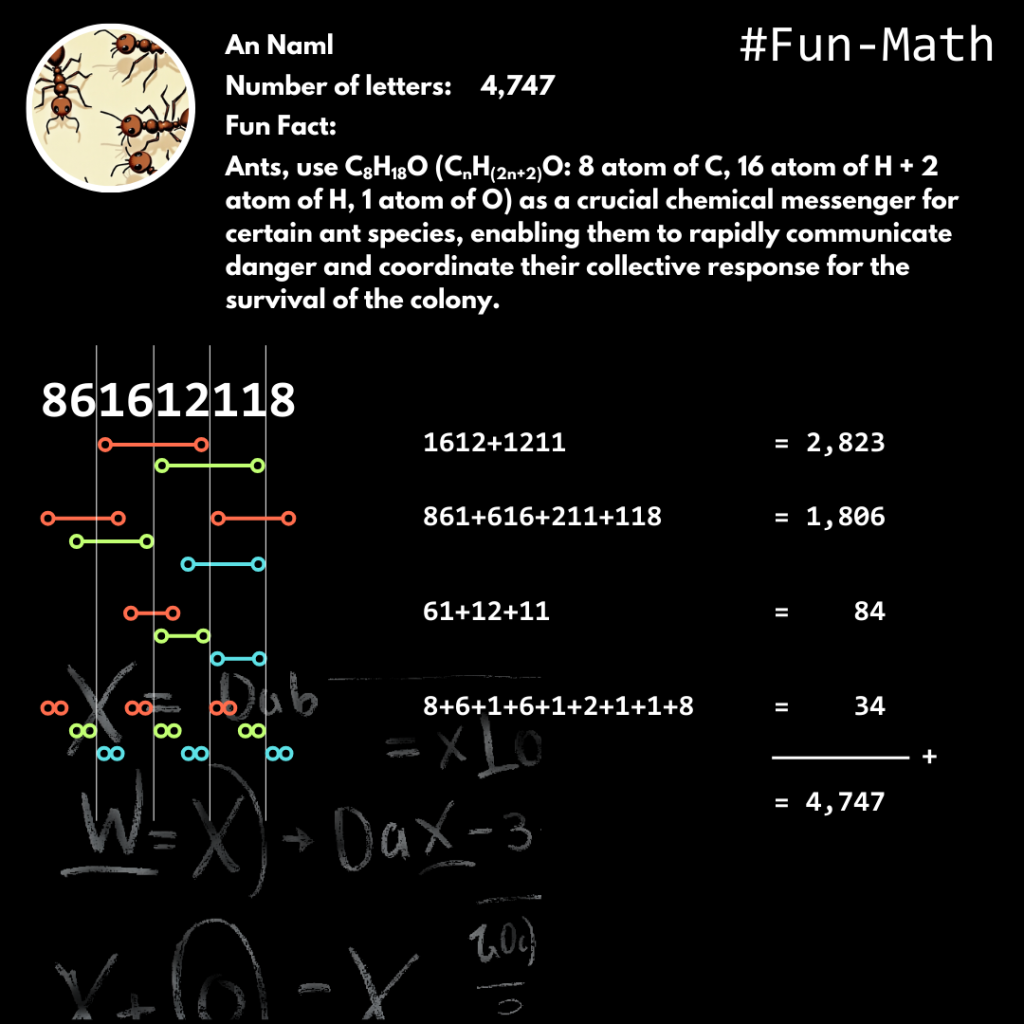
An Naml
Number of letters:
4,747
Fun Fact:
Ants, use C8H18O (CnH(2n+2)O: 8 atom of C, 16 atom of H + 2 atom of H, 1 atom of O) as a crucial chemical messenger for certain ant species, enabling them to rapidly communicate danger and coordinate their collective response for the survival of the colony.
861612118
1612+1211 + 861+616+211+118 + 61+12+11 + 8+6+1+6+1+2+1+1+8 = 4,747
#Fun-Math
- The Ant
- Semut
The ant is mentioned in Quran Chapter 27. In fact, Chapter 27 of the Quran is named “An-Naml” (The Ant). Ants, use C8H18O (8 C + 18 H + 1 O = 27 atoms) as a crucial chemical messenger for certain ant species, enabling them to rapidly communicate danger and coordinate their collective response for the survival of the colony.
And when they came across a valley of ants, an ant warned, “O ants! Go quickly into your homes so Solomon and his armies do not crush you, unknowingly.”
An Naml 27:18
Ants communicate through a sophisticated lexicon of chemical signals called pheromones, which are fundamental to nearly every aspect of their highly organized social lives. These powerful compounds, secreted from various glands, serve diverse purposes. Trail pheromones, for instance, are meticulously laid down by foraging ants, guiding nestmates to newly discovered food sources with remarkable efficiency, while others might mark territory or even signal a “no entry” zone. Beyond foraging, ants utilize pheromones for intricate recognition, distinguishing colony members from intruders, and for regulating reproduction and caste development within the nest. Crucially, in moments of peril, alarm pheromones are rapidly released, acting as an urgent call to action, alerting fellow ants to danger and triggering a range of responses from frantic escape and nest evacuation to aggressive, coordinated defense against threats. This complex chemical language allows ant colonies to function as highly integrated superorganisms, constantly adapting and responding to their environment with unparalleled precision.
While the exact chemical composition of alarm pheromones varies widely across ant species, certain compounds with the molecular formula C8H18O, specifically 4-methyl-3-heptanol [archive], have been identified as key players in this vital communication system.
When an ant encounters a threat—be it a predator, a rival colony, or a disturbed nest—it can quickly release alarm pheromones from specialized glands, often the mandibular or Dufour’s glands. These volatile chemicals rapidly disperse, carrying an urgent message to nearby ants. The perception of these pheromones by other ants triggers a range of behavioral responses, which can include increased activity and agitation, aggregation and recruitment, escape and dispersal, and aggression. The precise response depends on the species, the concentration of the pheromone, and the environmental context.
Research into the chemical ecology of ants has revealed that 4-methyl-3-heptanol is a significant component of alarm pheromones in several ant species. For instance, studies on the clonal raider ant Ooceraea biroi [archive] have shown that a blend of 4-methyl-3-heptanol and 4-methyl-3-heptanone (a closely related ketone) serves as their primary alarm signal. At low concentrations, these compounds can attract ants, drawing them towards the alarm source. However, at higher concentrations, they become repulsive, causing ants to move away, demonstrating the nuanced role of these chemicals in guiding ant behavior. This also occurs in Pogonomyrmex badius and Atta texana ants.
The presence of the alcohol group (-OH) in 4-methyl-3-heptanol contributes to its volatility, allowing it to rapidly dissipate and convey the urgent message across the ant colony.
It’s important to note the molecular composition of 4-methyl-3-heptanol. Each molecule of this alarm pheromone consists of 8 Carbon (C) atoms, 18 Hydrogen (H) atoms, and 1 Oxygen (O) atom. Adding these together, we confirm a total of 27 atoms per molecule (8 C+18 H+1 O=27 atoms). This atomic arrangement defines the unique chemical properties that allow 4-methyl-3-heptanol to function so effectively as an alarm signal in the complex world of ant communication.
In-depth information retrieval using AI and website.
Semut disebutkan dalam Al-Qur’an Surah ke-27. Faktanya, Surah ke-27 dalam Al-Qur’an dinamakan “An-Naml” (Semut). Semut menggunakan C8H18O (8 C + 18 H + 1 O = 27 atom) sebagai pembawa pesan kimiawi yang sangat penting bagi spesies semut tertentu, memungkinkan mereka untuk dengan cepat mengomunikasikan bahaya dan mengoordinasikan respons kolektif demi kelangsungan hidup koloni.
Hingga apabila mereka sampai di lembah semut, berkatalah seekor semut, “Hai semut-semut, masuklah ke dalam sarang-sarangmu agar kamu tidak diinjak oleh Sulaymān dan tentaranya, sedangkan mereka tidak menyadari”
An Naml 27:18
Semut berkomunikasi melalui kosa kata sinyal kimia yang canggih yang disebut feromon, yang merupakan fondasi bagi hampir setiap aspek kehidupan sosial mereka yang sangat terorganisir. Senyawa kuat ini, yang disekresikan dari berbagai kelenjar, memiliki beragam tujuan. Feromon jejak, misalnya, diletakkan dengan cermat oleh semut pekerja, membimbing anggota koloni ke sumber makanan yang baru ditemukan dengan efisiensi luar biasa, sementara feromon lain mungkin menandai wilayah atau bahkan memberi sinyal zona “dilarang masuk”.
Selain mencari makan, semut menggunakan feromon untuk pengenalan yang rumit, membedakan anggota koloni dari penyusup, dan untuk mengatur reproduksi serta pengembangan kasta dalam sarang. Yang terpenting, di saat bahaya, feromon alarm dilepaskan dengan cepat, bertindak sebagai panggilan mendesak untuk bertindak, memperingatkan semut lain akan bahaya dan memicu berbagai respons mulai dari melarikan diri dengan panik dan evakuasi sarang hingga pertahanan yang agresif dan terkoordinasi terhadap ancaman. Bahasa kimia yang kompleks ini memungkinkan koloni semut berfungsi sebagai superorganisme yang sangat terintegrasi, terus-menerus beradaptasi dan menanggapi lingkungan mereka dengan presisi yang tak tertandingi.
Meskipun komposisi kimiawi feromon alarm bervariasi luas antarspesies semut, senyawa tertentu dengan rumus molekul C8H18O, khususnya 4-metil-3-heptanol [archive], telah diidentifikasi sebagai pemain kunci dalam sistem komunikasi vital ini.
Ketika seekor semut menghadapi ancaman—baik itu predator, koloni saingan, atau sarang yang terganggu—ia dapat dengan cepat melepaskan feromon alarm dari kelenjar khusus, sering kali kelenjar mandibula atau kelenjar Dufour. Bahan kimia mudah menguap ini menyebar dengan cepat, membawa pesan mendesak kepada semut di dekatnya. Persepsi feromon ini oleh semut lain memicu berbagai respons perilaku, yang dapat mencakup peningkatan aktivitas dan agitasi, agregasi dan perekrutan, melarikan diri dan penyebaran, serta agresi. Respons yang tepat bergantung pada spesies, konsentrasi feromon, dan konteks lingkungan.
Penelitian ekologi kimia semut telah mengungkapkan bahwa 4-metil-3-heptanol adalah komponen signifikan dari feromon alarm pada beberapa spesies semut. Misalnya, penelitian pada semut prajurit klonal Ooceraea biroi [archive] telah menunjukkan bahwa campuran 4-metil-3-heptanol dan 4-metil-3-heptanon (keton yang sangat terkait) berfungsi sebagai sinyal alarm utama mereka. Pada konsentrasi rendah, senyawa-senyawa ini dapat menarik semut, menarik mereka ke sumber alarm. Namun, pada konsentrasi yang lebih tinggi, senyawa-senyawa ini menjadi menjijikkan, menyebabkan semut menjauh, menunjukkan peran bernuansa dari bahan kimia ini dalam memandu perilaku semut. hal ini juga terjadi pada semut Pogonomyrmex badius dan Atta texana.
Kehadiran gugus alkohol (-OH) dalam 4-metil-3-heptanol berkontribusi pada volatilitasnya, memungkinkannya untuk dengan cepat menghilang dan menyampaikan pesan mendesak ke seluruh koloni semut.
Penting untuk dicatat komposisi molekul 4-metil-3-heptanol. Setiap molekul feromon alarm ini terdiri dari 8 atom Karbon (C), 18 atom Hidrogen (H), dan 1 atom Oksigen (O). Menjumlahkan ini, kita mengonfirmasi total 27 atom per molekul (8 C+18 H+1 O=27 atom). Susunan atom ini mendefinisikan sifat kimia unik yang memungkinkan 4-metil-3-heptanol berfungsi secara efektif sebagai sinyal alarm dalam dunia komunikasi semut yang kompleks.
Penggalian informasi mendalam dengan bantuan AI dan situs web.
Imagine a spider building her web. She carefully spins each thread with great effort, believing her nest is strong. She thinks, “My nest is strong enough to catch insects, to protect me, and to hold me safely.” And in some ways, she is right, her silk is incredibly strong, even stronger than iron (al Hadid), in some ways. So why does the Qur’an chapter 29 verse 41 say that the spider’s house is the weakest? If only they knew.
How about 41 neutrons and 48 protons/electrons in Alanine? And… 7 neutrons in amine and 22 neutrons in carboxyl.
Fun Fact: The Spider (Al Ankabut)

Bayangkan seekor laba-laba sedang membangun jaringnya. Ia dengan hati-hati memintal setiap benang dengan penuh usaha, percaya bahwa sarangnya kuat. Ia berpikir, “Sarangku cukup kuat untuk menangkap serangga, melindungiku, dan menahanku dengan aman.” Dan dalam beberapa hal, ia benar—benang sutranya memang sangat kuat, bahkan dalam beberapa hal lebih kuat dari besi (al-Hadid), dalam beberapa hal. Lalu, mengapa dalam Surah ke-29 ayat 41, Allah berfirman bahwa rumah laba-laba adalah rumah yang paling lemah? Jika mereka mengetahui.
Bagaimana dengan 41 neutron and 48 proton/elektron di dalam Alanine? Dan… 7 neutron di dalam amin dan 22 neutron di dalam karboksil.
Fun Fact: Laba-laba (Al Ankabut)
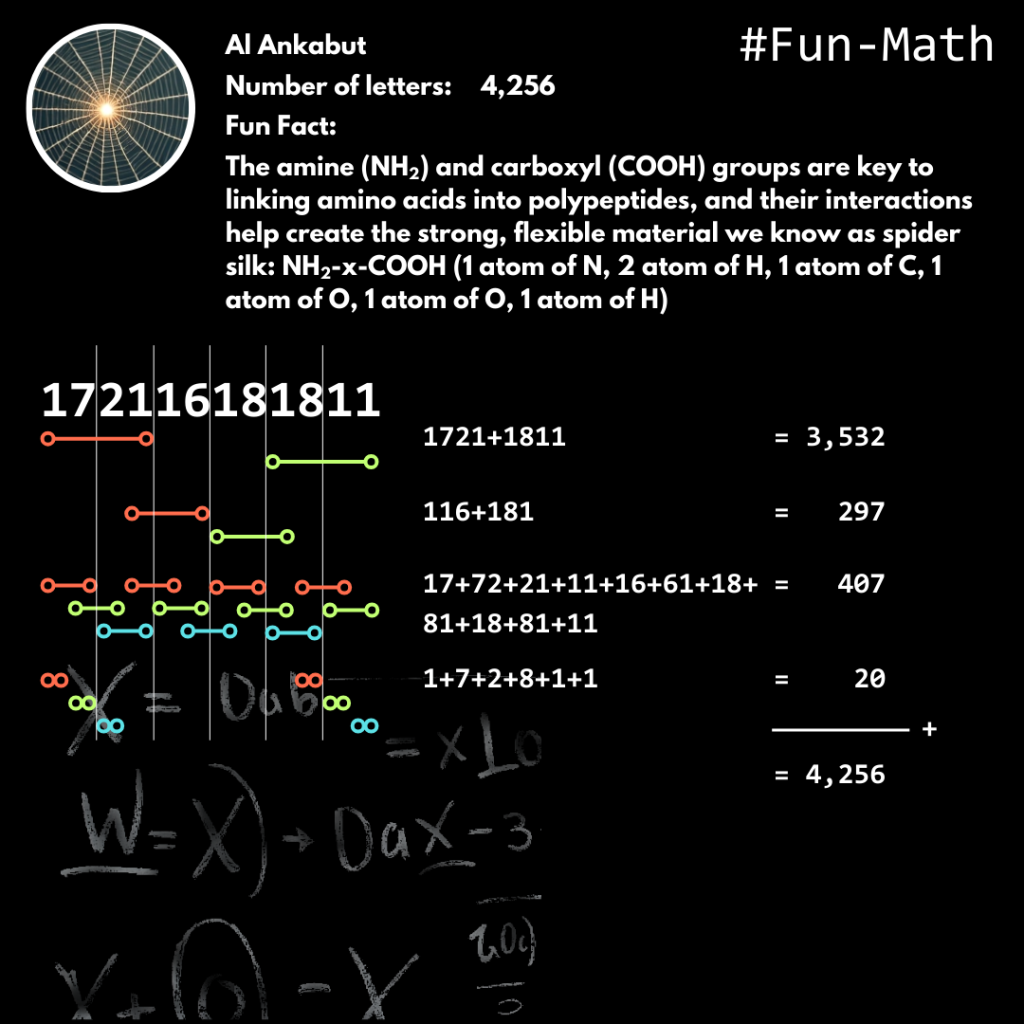
Al Ankabut
Number of letters:
4,256
Fun Fact:
The amine (NH2) and carboxyl (COOH) groups are key to linking amino acids into polypeptides, and their interactions help create the strong, flexible material we know as spider silk: NH2-x-COOH (1 atom of N, 2 atom of H, 1 atom of C, 1 atom of O, 1 atom of O, 1 atom of H)
172116181811
1721+1811 + 116+181 + 17+72+21+11+16+61+18+81+18+81+11 + 1+7+2+8+1+1 = 4,256
#Fun-Math
- The Spider
- Laba-laba
Imagine a spider building her web. She carefully spins each thread with great effort, believing her nest is strong. She thinks, “My nest is strong enough to catch insects, to protect me, and to hold me safely.” And in some ways, she is right, her silk is incredibly strong, even stronger than iron (al Hadid), in some ways.
Spider silk is one of the strongest natural materials known to science [archive]. It has a tensile strength—which means how much it can be stretched before breaking—of about 1,299 megapascals (MPa). That’s even stronger than iron or mild steel (al Hadid), which usually breaks at around 370 to 550 MPa. Not only that, spider silk is also very light and flexible. Scientists are amazed by it and try to copy it for use in high-tech materials like bulletproof vests and artificial ligaments.
Spider silk is remarkably tough, with a toughness of about 319 MJ/m³, which is significantly higher than that of Kevlar, whose toughness ranges from 50 to 80 MJ/m³. This means spider silk can absorb much energy before breaking, making it an exceptionally resilient and durable natural fiber.
So why does the Qur’an chapter 29 verse 41 say that the spider’s house is the weakest?
The example of those who take protectors other than Allah is like the spider who builds a house. And indeed, the weakest of houses is the house of the spider—if only they knew.
Al Ankabut:41
This verse is not just talking about physical strength. It is talking about true strength—the kind that gives real safety and protection. Even though the spider’s web is strong in its threads, it is still weak as a home. A simple gust of wind, a raindrop, or a human touch can destroy it in a moment. It cannot protect the spider from danger. It cannot last through storms. So from a human perspective, the spider’s house is one of the weakest shelters in nature.
The Qur’an uses this image as a metaphor. Just like the spider trusts her web, people sometimes place their trust in things other than Allah—like money, power, or false beliefs. These things might seem strong at first, but in reality, they are fragile and unreliable. When real hardship comes, they break—just like the web.
So this verse teaches us that true strength does not lie in appearances or in materials. It lies in faith, in truth, and in trusting Allah. A strong web made of silk is still a weak home. And a life without Allah, no matter how strong it looks on the outside, is still vulnerable.
Wait a minute, what about 29 and/or 41?
Verse 41 talk about strength and weakness, and in terms of spider web strength, the formation of β-sheets plays a key role in providing the web with its remarkable durability and resilience.
The polyalanine segments in spider silk proteins expose hydrophobic surfaces that cause the protein to fold into β-pleated sheets. These sheets are stabilized by hydrogen bonds, both within a single protein chain (intrachain) and between different protein chains (interchain). The formation of these β-pleated structures with numerous hydrogen bonds is what gives the spider silk its remarkable strength and stability. When these β-sheets align in a regular and repeating pattern, they can form crystals (β-Sheet Crystallization).
Alanine, consists of 3 carbon atoms, 7 hydrogen atoms, 1 nitrogen atom, and 2 oxygen atoms, with a molecular formula of C₃H₇NO₂. Total number of neutrons in one molecule of alanine (assuming most common isotopes): 0(H)+18(C)+7(N)+16(O)=41. Total number of protons / elektrons in one molecule of alanine: 7(H)+18(C)+7(N)+16(O)=48.
In verse 48, the Qur’an highlights the perfection of divine knowledge: “And you were not reciting any scripture before it, nor did you write it with your right hand; for then, would have certainly doubted the falsifiers.”
The amine (NH2) and carboxyl (COOH) groups are key to linking amino acids into polypeptides, and their interactions help create the strong, flexible material we know as spider silk, for example: Glycine (NH2-CH2–COOH), Alanine (CH3-CH(NH2)–COOH), Tyrosine (NH2-CH(COOH)-CH2-C6H4OH) [archive], etc.
Interestingly, the total number of neutrons in the amine and carboxyl groups is 29. This is calculated as follows: 7(N)+0(H)=7 neutrons from the amine group, and 6(C)+8(O)+8(O)+0(H)=22 neutrons from the carboxyl group.
In-depth information retrieval using AI and website.
Bayangkan seekor laba-laba sedang membangun jaringnya. Ia dengan hati-hati memintal setiap benang dengan penuh usaha, percaya bahwa sarangnya kuat. Ia berpikir, “Sarangku cukup kuat untuk menangkap serangga, melindungiku, dan menahanku dengan aman.” Dan dalam beberapa hal, ia benar—benang sutranya memang sangat kuat, bahkan dalam beberapa hal lebih kuat dari besi (al-Hadid).
Sutra laba-laba adalah salah satu material alami terkuat yang dikenal oleh ilmu pengetahuan [archive]. Sutra ini memiliki kekuatan tarik—yaitu seberapa besar ia dapat ditarik sebelum putus—sekitar 1.299 megapascal (MPa). Itu bahkan lebih kuat dibandingkan besi atau baja ringan (al-Hadid), yang biasanya putus pada sekitar 370 hingga 550 MPa. Bukan hanya itu, sutra laba-laba juga sangat ringan dan lentur. Para ilmuwan begitu kagum padanya dan mencoba menirunya untuk digunakan dalam bahan berteknologi tinggi seperti rompi antipeluru dan ligamen buatan.
Sutra laba-laba sangat tangguh, dengan kekuatan sekitar 319 MJ/m³, yang secara signifikan lebih tinggi dibandingkan Kevlar, yang kekuatannya berkisar antara 50 hingga 80 MJ/m³. Ini berarti sutra laba-laba dapat menyerap lebih banyak energi sebelum putus, menjadikannya serat alami yang sangat kuat dan tahan lama.
Lalu, mengapa dalam Surah ke-29 ayat 41, Allah berfirman bahwa rumah laba-laba adalah rumah yang paling lemah?
Perumpamaan orang-orang yang mengambil pelindung selain Allah adalah seperti laba-laba yang membuat rumah. Dan sesungguhnya rumah yang paling lemah adalah rumah laba-laba, jika mereka mengetahui.
Al Ankabut 29:41
Ayat ini bukan hanya berbicara tentang kekuatan fisik, tetapi tentang kekuatan sejati—yakni kekuatan yang memberikan keamanan dan perlindungan yang sebenarnya. Meskipun jaring laba-laba kuat dalam hal benangnya, tetap saja ia lemah sebagai tempat tinggal. Tiupan angin, tetesan hujan, atau sentuhan manusia saja sudah cukup untuk menghancurkannya dalam sekejap. Jaring itu tidak bisa melindungi laba-laba dari bahaya. Ia juga tidak bisa bertahan dalam badai. Maka dari sudut pandang manusia, rumah laba-laba adalah salah satu tempat berlindung yang paling lemah di alam.
Al-Qur’an menggunakan gambaran ini sebagai perumpamaan (metafora). Sama seperti laba-laba mempercayai jaringnya, manusia kadang menaruh kepercayaan kepada selain Allah—seperti harta, kekuasaan, atau keyakinan yang salah. Hal-hal itu mungkin terlihat kuat pada awalnya, tetapi pada kenyataannya rapuh dan tidak bisa diandalkan. Ketika kesulitan nyata datang, semuanya hancur—seperti jaring laba-laba.
Jadi, ayat ini mengajarkan kepada kita bahwa kekuatan sejati tidak terletak pada penampilan atau pada benda-benda material. Kekuatan sejati terletak pada iman, kebenaran, dan tawakal kepada Allah. Jaring yang kuat terbuat dari sutra pun tetaplah rumah yang lemah. Dan hidup tanpa Allah, sekuat apa pun kelihatannya dari luar, tetaplah rentan dan tidak aman.
Tunggu sebentar, bagaimana dengan ayat 29 dan/atau 41?
Ayat 41 berbicara tentang kekuatan dan kelemahan, dan dalam hal kekuatan jaring laba-laba, pembentukan β-sheet memainkan peran kunci dalam memberikan jaring kekuatan dan ketahanan yang luar biasa.
Segmen polyalanin dalam protein sutra laba-laba mengekspos permukaan hidrofobik yang menyebabkan protein melipat menjadi β-pleated sheet. Sheet ini distabilkan oleh ikatan hidrogen, baik dalam satu rantai protein (intrachain) maupun antar rantai protein yang berbeda (interchain). Pembentukan struktur β-pleated ini dengan banyak ikatan hidrogen adalah yang memberikan sutra laba-laba kekuatan dan kestabilan luar biasa. Ketika β-sheet ini sejajar dalam pola yang teratur dan berulang, mereka dapat membentuk kristal (Kristalisasi β-Sheet).
Alanine terdiri dari 3 atom karbon, 7 atom hidrogen, 1 atom nitrogen, dan 2 atom oksigen, dengan rumus molekul C₃H₇NO₂. Total jumlah neutron dalam satu molekul alanine (dengan asumsi isotop yang paling umum): 0(H)+18(C)+7(N)+16(O)=41. Total jumlah proton / elektron dalam satu molekul alanine: 7(H)+18(C)+7(N)+16(O)=48.
Dalam ayat 48, Al-Qur’an menyoroti kesempurnaan pengetahuan ilahi: “Dan kamu tidak membaca kitab sebelumnya, dan kamu tidak menulisnya dengan tangan kananmu; kalau begitu, pasti orang-orang yang mendustakan itu akan ragu.”
Kelompok amina (NH₂) dan karboksil (COOH) sangat penting dalam menghubungkan asam amino menjadi polipeptida, dan interaksi mereka membantu menciptakan material kuat dan fleksibel yang kita kenal sebagai sutra laba-laba, contohnya: Glisin (NH₂-CH₂-COOH), Alanin (CH3-CH(NH2)–COOH), Tirosin (NH2-CH(COOH)-CH2-C6H4OH) [archive], dan lain-lain.
Menariknya, jumlah total neutron dalam kelompok amina dan karboksil adalah 29. Ini dihitung sebagai berikut: 7(N)+0 (H) = 7 neutron dari kelompok amina, dan 6(C)+8(O)+8(O)+0(H) = 22 neutron dari kelompok karboksil.
Penggalian informasi mendalam dengan bantuan AI dan situs web.
Earth (or Sun) Relative to Galactic Center
The stars is mentioned in Quran Chapter 53. In fact, Chapter 53 of the Quran is named “An Najm” (The Star). The distance from the Galactic Center to the Sun (and Earth, of course) is 8 (5+3) kpc, passing through the Scutum Arm at approximately 5 kpc, satisfying the 5:3 ratio. Among the 58 bright stars historically used for celestial navigation, Deneb is the farthest, shining from a distance of ~0.8 kiloparsecs, yet its immense luminosity makes it a consistent and reliable guide for sailors.
Fun Fact: The Star (An Najm)

Bintang-bintang disebutkan dalam Al-Qur’an Surat 53. Bahkan, Surat 53 dalam Al-Qur’an dinamakan “An Najm” (Bintang). Jarak dari Pusat Galaksi ke Matahari (dan Bumi, tentu saja) adalah 8 (5+3) kpc, melewati Lengan Scutum pada jarak sekitar 5 kpc, yang memenuhi rasio 5:3. Di antara 58 bintang terang yang secara historis digunakan untuk navigasi langit, Deneb adalah yang terjauh, bersinar dari jarak sekitar 0,8 kiloparsec, namun luminositasnya yang luar biasa menjadikannya panduan yang konsisten dan andal bagi para pelaut.
Fun Fact: Bintang (An Najm)
Total Distance of Northern and Southern Stars
The stars is mentioned in Quran Chapter 53. In fact, Chapter 53 of the Quran is named “An Najm” (The Star). Sailors used a total of 58 stars for navigation, including 26 Northern Stars (Declination ≥ 0°) with a combined distance (from earth) of 6,852 light-years and 32 Southern Stars at a total of 11,334 light-years. The ratio of the distance of Southern stars:Northern stars is approximately 1:0.604552673372155 or 5:3.02276336686077 ≈ 5:3.
Fun Fact: The Star (An Najm)

Bintang-bintang disebutkan dalam Al-Qur’an Surat 53. Bahkan, Surat 53 dalam Al-Qur’an dinamakan “An Najm” (Bintang). Secara historis, para pelaut menggunakan total 58 bintang untuk navigasi. Dari jumlah tersebut, 26 adalah Bintang Utara (Deklinasi ≥ 0°) dengan jarak gabungan (dari bumi) 6.852 tahun cahaya, sementara 32 adalah Bintang Selatan yang memiliki total jarak 11.334 tahun cahaya. Rasio antara jumlah jarak Bintang Selatan:Bintang Utara kira-kira 1:0.604552673372155 or 5:3.02276336686077 ≈ 5:3.
Fun Fact: Bintang (An Najm)
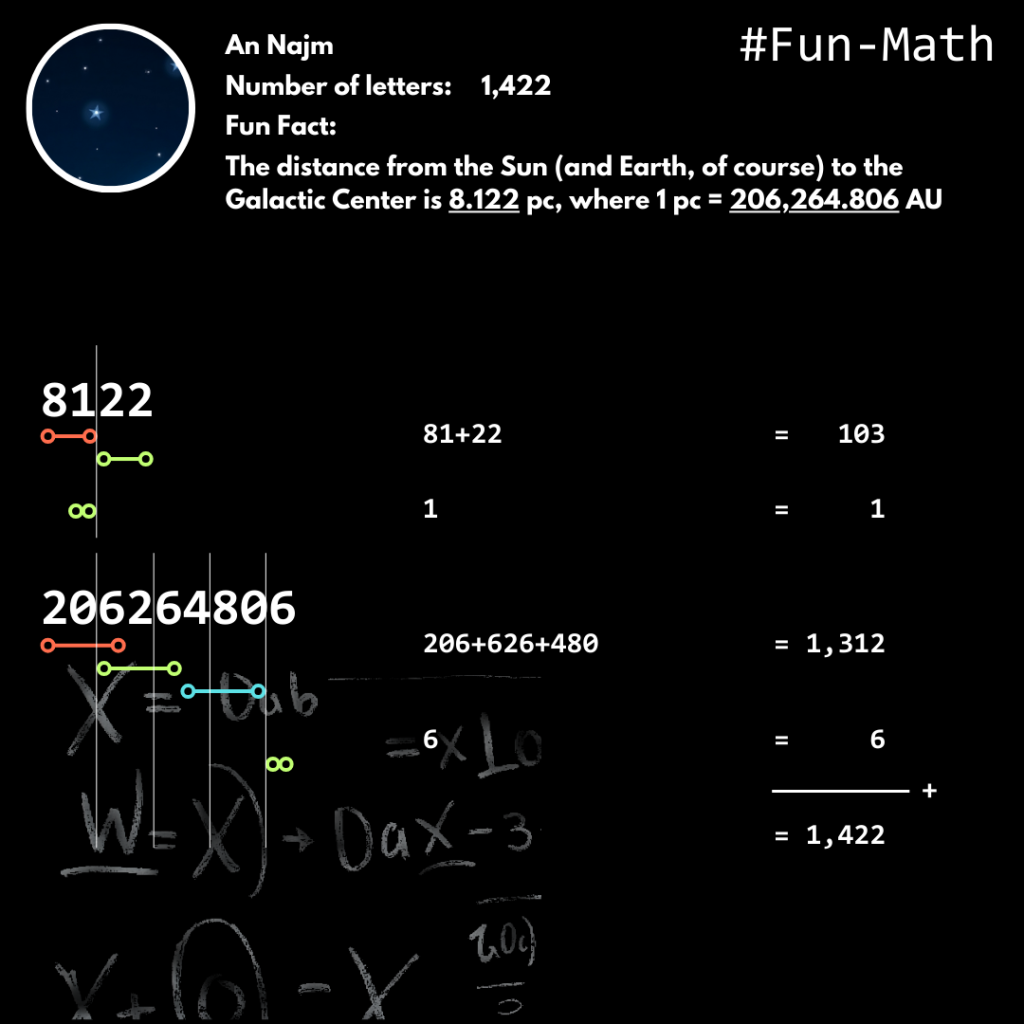
An Najm
Number of letters:
1,422
Fun Fact:
The distance from the Sun (and Earth, of course) to the Galactic Center is 8.122 pc, where 1 pc = 206,264.806 AU.
8122 206264806
206+626+480 + 81+22 + 1+6 = 1,422
#Fun-Math
- The Star
- Bintang
Earth (or Sun) Relative to Galactic Center
The stars is mentioned in Quran Chapter 53. In fact, Chapter 53 of the Quran is named “An Najm” (The Star). The distance from the Galactic Center to the Sun (and Earth, of course) is 8 (5+3) kpc, passing through the Scutum Arm at approximately 5 kpc, satisfying the 5:3 ratio. Among the 58 bright stars historically used for celestial navigation, Deneb is the farthest, shining from a distance of ~0.8 kiloparsecs, yet its immense luminosity makes it a consistent and reliable guide for sailors.
By the stars when they fade away!
Your fellow man (Muḥammad (ﷺ)) is neither misguided nor astray. Nor does he speak of his own whims. It is only a revelation sent down ˹to him˺.
An Najm 53:1-4
While celestial navigation uses a standard set of 58 bright stars, their true distances from Earth vary dramatically. The vast majority of these navigational aids are located within 0.1 kiloparsecs (326 light-years), making them our relatively close galactic neighbors. This group includes some of the most famous stars in the night sky, such as Sirius, Procyon, Vega, and Polaris, the North Star. These stars appear exceptionally bright in our sky not only because of their intrinsic luminosity but also because of their relative proximity, ensuring they are consistently visible and reliable reference points for navigators on Earth’s surface.
Moving beyond our immediate cosmic neighborhood, a smaller but significant number of navigational stars are found at greater distances, ranging from 0.1 to 0.5 kiloparsecs and beyond. These stars are not chosen for their nearness but for their immense intrinsic brightness. They are typically supergiants or hypergiants, which are hundreds or thousands of times more luminous than our Sun. This incredible power allows them to be seen across vast distances, appearing as bright beacons in our night sky. Key examples from this group include Betelgeuse, Rigel, and Canopus, all of which are crucial for navigation despite their considerable distance from Earth.
Ultimately, the reason navigators use stars with such a wide range of distances is to create a complete and reliable celestial grid. Stars like the exceptionally distant Deneb, located at around 0.8 kiloparsecs (2,600 light-years), serve as a testament to the power of stellar luminosity. This vast array of stars, from the very close to the exceptionally far, provides a reliable celestial map for determining one’s location anywhere on Earth. For context, our entire solar system, including the Sun, is located about approximately 8.122 ± 0.031 kiloparsecs from the supermassive black hole at the center of the Milky Way galaxy. This highlights the immense scale of our galaxy and shows that all the stars used for navigation are, in the grand scheme of things, still a relatively small part of our local galactic arm.
Based on an image [archive] (reimage below) from an paper [archive], the distance from the Galactic Center to the Sun (and Earth, of course) is 8 kpc, passing through the Scutum Arm at approximately 5 kpc, satisfying the 5:3 ratio.
Standard unit for Sun-Earth distance is 1 astronomical unit (AU), and 1 pc (parsec) is 206,265.806 AU.
Northern and Southern Stars
The stars is mentioned in Quran Chapter 53. In fact, Chapter 53 of the Quran is named “An Najm” (The Star). Sailors used a total of 58 stars for navigation, including 26 Northern Stars (Declination ≥ 0°) with a combined distance (from earth) of 6,852 light-years and 32 Southern Stars at a total of 11,334 light-years. The ratio of the distance of Southern stars:Northern stars is approximately 1:0.604552673372155 or 5:3.02276336686077 ≈ 5:3.
Northern Stars (Declination ≥ 0°), 26 stars, total distance 6,852 ly:
Polaris: 447 ly (Gaia parallax: 7.2928 ± 0.0348 mas), Alpheratz: 97 ly, Aldebaran: 65.2 ly, Alderamin: 49.0 ly, Alioth: 82.5 ly, Alkaid: 104 ly, Altair: 16.7 ly, Arcturus: 36.7 ly, Bellatrix: 251 ly, Betelgeuse: 548 ly (non-Gaia; high uncertainty), Capella: 42.8 ly, Deneb: 2,618 ly (Gaia geometric), Denebola: 35.9 ly, Dubhe: 124 ly, Elnath: 134 ly, Enif: 691 ly, Hamal: 65.9 ly, Kochab: 126 ly, Markab: 140 ly, Menkar: 220 ly, Mirfak: 593 ly, Pollux: 33.8 ly, Procyon: 11.5 ly, Regulus: 79.3 ly, Schedar: 228 ly, Vega: 25.0 ly
Southern Stars (Declination < 0°), 32 stars, total distance 11,334 ly:
Acamar: 161 ly, Achernar: 139 ly, Acrux: 322 ly, Adhara: 430 ly, Alnair: 103 ly, Alnilam: 1,342 ly, Ankaa: 85.0 ly, Antares: 553 ly, Atria: 415 ly, Avior: 630 ly, Canopus: 310 ly, Diphda: 96.1 ly, Fomalhaut: 25.1 ly, Gacrux: 88.7 ly, Gienah: 165 ly, Hadar: 392 ly, Kaus Australis: 143 ly, Menkent: 61.0 ly, Miaplacidus: 111 ly, Mirzam: 500 ly, Nunki: 224 ly, Peacock: 183 ly, Rigel: 863 ly, Rigil Kentaurus: 4.37 ly, Sabik: 84.2 ly, Saiph: 650 ly, Shaula: 571 ly, Sirius: 8.60 ly, Spica: 250 ly, Suhail: 545 ly, Wezen: 1,802 ly, Zubenelgenubi: 77.0 ly
Gaia DR3 Sources: Geometric distances from Bailer-Jones et al. (2021) [archive]; Bright stars (e.g., Betelgeuse, Rigel) have high parallax errors; distances use consensus values. Deneb, Alnilam, and Wezen use Gaia geometric distances (improved over raw parallax). Values may differ slightly from older catalogs (e.g., Hipparcos).
Bumi (Matahari) Relatif terhadap Pusat Galaksi
Bintang-bintang disebutkan dalam Al-Qur’an Surat 53. Bahkan, Surat 53 dalam Al-Qur’an dinamakan “An Najm” (Bintang). Jarak dari Pusat Galaksi ke Matahari (dan Bumi, tentu saja) adalah 8 (5+3) kpc, melewati Lengan Scutum pada jarak sekitar 5 kpc, yang memenuhi rasio 5:3. Di antara 58 bintang terang yang secara historis digunakan untuk navigasi langit, Deneb adalah yang terjauh, bersinar dari jarak sekitar 0,8 kiloparsec, namun luminositasnya yang luar biasa menjadikannya panduan yang konsisten dan andal bagi para pelaut.
Demi bintang ketika terbenam,
kawanmu (Muhammad) tidak sesat dan tidak (pula) keliru, dan tidaklah yang diucapkannya itu (Al-Qur`an) menurut keinginannya. Tidak lain (Al-Qur`an itu) adalah wahyu yang diwahyukan (kepadanya),
An Najm 53:1-4
Saat navigasi langit menggunakan 58 bintang terang standar, jarak aslinya dari Bumi sangat bervariasi. Sebagian besar bintang yang digunakan untuk navigasi ini terletak dalam jarak 0,1 kiloparsec (326 tahun cahaya), menjadikannya tetangga galaksi kita yang relatif dekat. Kelompok ini mencakup beberapa bintang paling terkenal di langit malam, seperti Sirius, Procyon, Vega, dan Polaris, atau Bintang Utara. Bintang-bintang ini terlihat sangat terang di langit kita bukan hanya karena luminositas intrinsiknya, tetapi juga karena jaraknya yang relatif dekat, sehingga mereka selalu terlihat dan menjadi titik acuan yang andal bagi para pelaut di permukaan Bumi.
Melampaui tetangga kosmik terdekat kita, sejumlah kecil tetapi signifikan bintang navigasi ditemukan pada jarak yang lebih jauh, berkisar antara 0,1 hingga 0,5 kiloparsec dan lebih jauh lagi. Bintang-bintang ini tidak dipilih karena kedekatannya, melainkan karena kecerahan intrinsiknya yang sangat besar. Bintang-bintang ini biasanya adalah super raksasa atau hyper raksasa, yang ratusan atau ribuan kali lebih bercahaya daripada Matahari kita. Kekuatan luar biasa ini memungkinkan mereka terlihat dari jarak yang sangat jauh, tampak seperti suar terang di langit malam kita. Contoh utama dari kelompok ini termasuk Betelgeuse, Rigel, dan Canopus, yang semuanya sangat penting untuk navigasi meskipun jaraknya cukup jauh dari Bumi.
Pada akhirnya, alasan para navigator menggunakan bintang-bintang dengan rentang jarak yang begitu luas adalah untuk menciptakan kisi langit yang lengkap dan andal. Bintang-bintang seperti Deneb yang sangat jauh, yang terletak sekitar 0,8 kiloparsec (2.600 tahun cahaya), menjadi bukti kekuatan luminositas bintang. Berbagai bintang ini, dari yang sangat dekat hingga yang sangat jauh, menyediakan peta langit yang andal untuk menentukan lokasi seseorang di mana pun di Bumi. Sebagai konteks, seluruh tata surya kita, termasuk Matahari, terletak sekitar 8,122 ± 0,031 kiloparsec dari lubang hitam supermasif di pusat galaksi Bima Sakti. Ini menyoroti skala galaksi kita yang sangat besar dan menunjukkan bahwa semua bintang yang digunakan untuk navigasi, dalam skema yang lebih besar, masih merupakan bagian yang relatif kecil dari lengan galaksi lokal kita.
Berdasarkan sebuah gambar [archive] dari paper [archive], jarak dari Pusat Galaksi ke Matahari (dan Bumi, tentu saja) adalah 8 kpc, melewati Lengan Scutum pada jarak sekitar 5 kpc, yang memenuhi rasio 5:3.
Satuan standar untuk jarak Matahari-Bumi adalah 1 unit astronomi (AU), dan 1 pc (parsec) adalah 206.265,806 AU.
Bintang Utara dan Selatan
Bintang-bintang disebutkan dalam Al-Qur’an Surat 53. Bahkan, Surat 53 dalam Al-Qur’an dinamakan “An Najm” (Bintang). Secara historis, para pelaut menggunakan total 58 bintang untuk navigasi. Dari jumlah tersebut, 26 adalah Bintang Utara (Deklinasi ≥ 0°) dengan jarak gabungan (dari bumi) 6.852 tahun cahaya, sementara 32 adalah Bintang Selatan yang memiliki total jarak 11.334 tahun cahaya. Rasio antara jumlah jarak Bintang Selatan:Bintang Utara kira-kira 1:0.604552673372155 or 5:3.02276336686077 ≈ 5:3.
Berikut adalah daftar bintang-bintang tersebut, beserta jaraknya dalam tahun cahaya:
Bintang Utara (Deklinasi ≥ 0°), 26 bintang, total jarak 6.852 tahun cahaya: Polaris: 447 tahun cahaya, Alpheratz: 97 tahun cahaya, Aldebaran: 65,2 tahun cahaya, Alderamin: 49,0 tahun cahaya, Alioth: 82,5 tahun cahaya, Alkaid: 104 tahun cahaya, Altair: 16,7 tahun cahaya, Arcturus: 36,7 tahun cahaya, Bellatrix: 251 tahun cahaya, Betelgeuse: 548 tahun cahaya, Capella: 42,8 tahun cahaya, Deneb: 2.618 tahun cahaya, Denebola: 35,9 tahun cahaya, Dubhe: 124 tahun cahaya, Elnath: 134 tahun cahaya, Enif: 691 tahun cahaya, Hamal: 65,9 tahun cahaya, Kochab: 126 tahun cahaya, Markab: 140 tahun cahaya, Menkar: 220 tahun cahaya, Mirfak: 593 tahun cahaya, Pollux: 33,8 tahun cahaya, Procyon: 11,5 tahun cahaya, Regulus: 79,3 tahun cahaya, Schedar: 228 tahun cahaya, Vega: 25,0 tahun cahaya.
Bintang Selatan (Deklinasi < 0°), 32 bintang, total jarak 11.334 tahun cahaya: Acamar: 161 tahun cahaya, Achernar: 139 tahun cahaya, Acrux: 322 tahun cahaya, Adhara: 430 tahun cahaya, Alnair: 103 tahun cahaya, Alnilam: 1.342 tahun cahaya, Ankaa: 85,0 tahun cahaya, Antares: 553 tahun cahaya, Atria: 415 tahun cahaya, Avior: 630 tahun cahaya, Canopus: 310 tahun cahaya, Diphda: 96,1 tahun cahaya, Fomalhaut: 25,1 tahun cahaya, Gacrux: 88,7 tahun cahaya, Gienah: 165 tahun cahaya, Hadar: 392 tahun cahaya, Kaus Australis: 143 tahun cahaya, Menkent: 61,0 tahun cahaya, Miaplacidus: 111 tahun cahaya, Mirzam: 500 tahun cahaya, Nunki: 224 tahun cahaya, Peacock: 183 tahun cahaya, Rigel: 863 tahun cahaya, Rigil Kentaurus: 4,37 tahun cahaya, Sabik: 84,2 tahun cahaya, Saiph: 650 tahun cahaya, Shaula: 571 tahun cahaya, Sirius: 8,60 tahun cahaya, Spica: 250 tahun cahaya, Suhail: 545 tahun cahaya, Wezen: 1.802 tahun cahaya, Zubenelgenubi: 77,0 tahun cahaya.
Sumber Data: Jarak geometrik dari Gaia DR3 oleh Bailer-Jones et al. (2021) [archive]. Bintang-bintang terang (seperti Betelgeuse dan Rigel) memiliki kesalahan paralaks yang tinggi, sehingga jaraknya menggunakan nilai konsensus. Deneb, Alnilam, dan Wezen menggunakan jarak geometrik Gaia yang telah ditingkatkan. Nilai-nilai ini mungkin sedikit berbeda dari katalog lama seperti Hipparcos.

The moon is mentioned in Quran Chapter 54 Verse 1. In fact, Chapter 54 of the Quran is named “Al Qamar” (The Moon), and it describes the event when the moon was split ˹in two˺. Relative to the plane of the ecliptic (Earth’s orbital plane around the Sun), the Moon’s axial tilt is relatively small, about 1.542≈1.54 degrees, and its inclination is about 5.1454 degrees.
Fun Fact: The Moon (Al Qamar)

Bulan disebutkan dalam Quran Surah 54 Ayat 1. Faktanya, Surah 54 dalam Al-Qur’an dinamakan “Al-Qamar” (Bulan), dan surah ini menggambarkan peristiwa ketika bulan terbelah dua. Relatif terhadap bidang ekliptika (bidang orbit Bumi mengelilingi Matahari), kemiringan sumbu Bulan relatif kecil, sekitar 1,542°≈1,54°, dan inklinasinya sekitar 5,1454°.
Fun Fact: Bulan (Al Qamar)
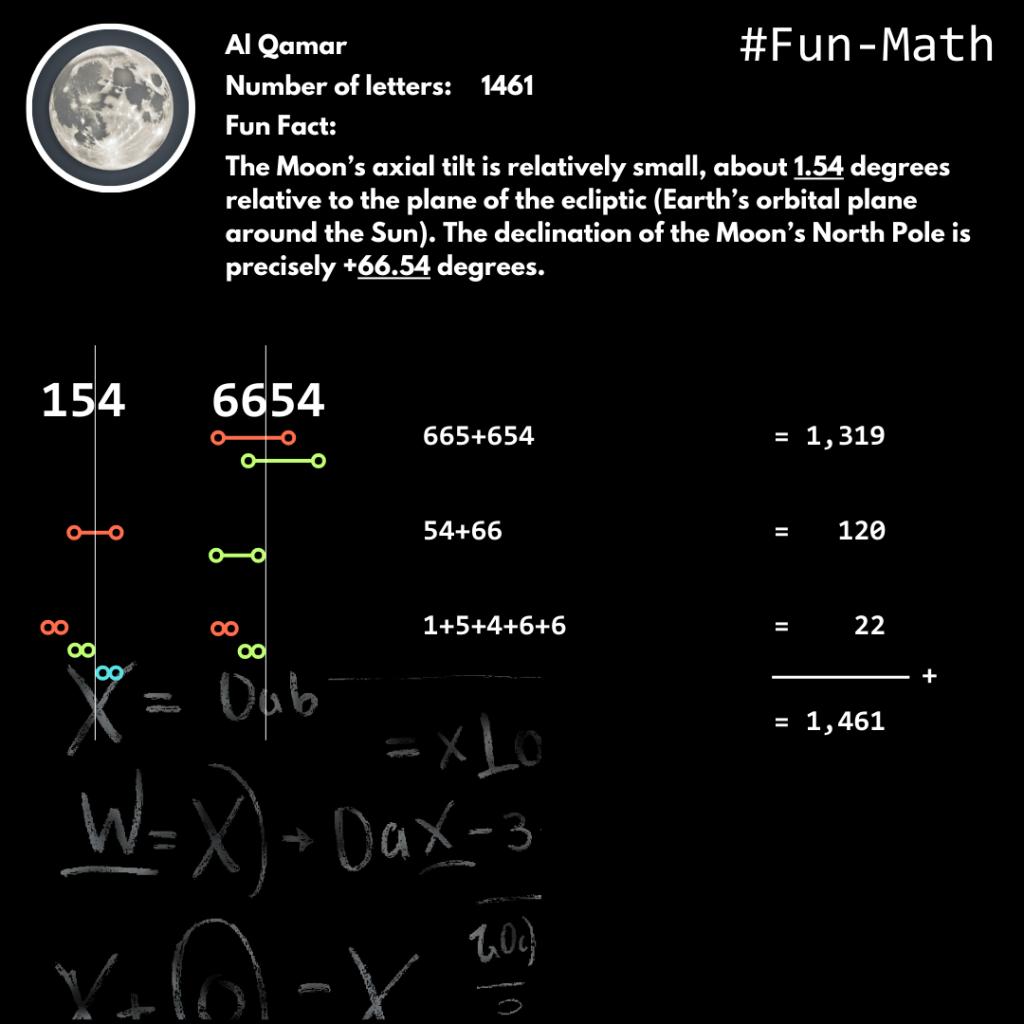
Al Qamar
Number of letters:
1,461
Fun Fact:
Relative to the plane of the ecliptic (Earth’s orbital plane around the Sun), the Moon’s axial tilt is relatively small, about 1.54 degrees, and its inclination is about 5.1454 degrees.
154 51454
154+514+145+454 + 51+14+45+54+15 + 5+1+4+5
#Fun-Math
- The Moon
- Bulan
The moon is mentioned in Quran Chapter 54 Verse 1. In fact, Chapter 54 of the Quran is named “Al Qamar” (The Moon). Relative to the plane of the ecliptic (Earth’s orbital plane around the Sun), the Moon’s axial tilt is relatively small, about 1.542≈1.54 degrees, and its inclination is about 5.1454 degrees.
The Hour has drawn near and the moon was split ˹in two˺
Al Qamar 54:1
#1: Axial Tilt
The Moon, our celestial companion, holds a unique position in the solar system, and one of its defining characteristics is its axial tilt. This tilt, formally known as obliquity, refers to the angle between the Moon’s axis of rotation and the plane in which Earth orbits the Sun, also known as the plane of the ecliptic. This angle is a remarkably slight 1.54 degrees (NASA document page 13 [archive]). This minimal tilt has profound implications for the lunar environment.
Compared to Earth’s significant axial tilt of approximately 23.4 degrees, which gives our planet its distinct seasons, the Moon experiences virtually no seasonal variations. Because its axis is nearly perpendicular to the plane of its orbit around the Sun, there are no dramatic shifts in solar insolation across its surface throughout its year (which is equivalent to Earth’s year). Consequently, regions near the Moon’s poles experience extremely consistent lighting conditions. The highest peaks at the lunar poles can be bathed in near-perpetual sunlight, while the floors of deeply shadowed craters remain in eternal darkness. These permanently shadowed regions are of immense scientific interest as potential cold traps, preserving water ice and other volatile compounds that have accumulated over billions of years.
The Moon’s minimal axial tilt is a key factor in its geological stability and the preservation of its surface features. Unlike Earth, where a more pronounced tilt contributes to dynamic atmospheric and oceanic circulation that shapes the landscape, the Moon’s surface is primarily sculpted by meteorite impacts, without the moderating effects of significant temperature fluctuations driven by seasonal changes. This small degree of axial tilt helps define the Moon’s stark, unchanging polar environments and contributes to its overall unique planetary characteristics.
#2: Inclination
The Moon’s 5.1454 degress [archive] orbital inclination [archive] is the main reason why eclipses are not a monthly occurrence. This tilt means the Moon’s orbit is at an angle to the ecliptic plane, which is the plane of Earth’s orbit around the Sun. As a result, the Moon usually passes either “above” or “below” the ecliptic. Eclipses can only happen when the Moon is in its new or full phase and is crossing the ecliptic, at a point known as a node. If the Moon’s orbit wasn’t tilted, it would cross the ecliptic plane every month, causing a solar eclipse at every new moon and a lunar eclipse at every full moon.
In-depth information retrieval using AI and website.
Bulan disebutkan dalam Quran Surah 54 Ayat 1. Faktanya, Surah 54 dalam Al-Qur’an dinamakan “Al-Qamar” (Bulan). Relatif terhadap bidang ekliptika (bidang orbit Bumi mengelilingi Matahari), kemiringan sumbu Bulan relatif kecil, sekitar 1,542°≈1,54°, dan inklinasinya sekitar 5,1454°.
Telah dekat (datangnya) saat itu dan telah terbelah bulan ˹menjadi dua˺.
Al Qamar 54:1
#1: Kemiringan Sumbu
Bulan, pendamping langit kita, memegang posisi unik dalam tata surya, dan salah satu karakteristik utamanya adalah kemiringan sumbunya. Kemiringan ini, yang secara formal dikenal sebagai oblikuitas, mengacu pada sudut antara sumbu rotasi Bulan dan bidang di mana Bumi mengelilingi Matahari, juga dikenal sebagai bidang ekliptika. Sudut ini sangatlah kecil, yaitu 1,54 derajat (dokumen NASA hal 13 [archive]). Kemiringan yang sangat minim ini memiliki implikasi mendalam bagi lingkungan Bulan.
Dibandingkan dengan kemiringan sumbu Bumi yang signifikan, sekitar 23,4 derajat, yang memberikan planet kita musim-musim yang jelas, Bulan praktis tidak mengalami variasi musiman. Karena sumbunya hampir tegak lurus dengan bidang orbitnya mengelilingi Matahari, tidak ada perubahan drastis dalam insolasi surya di permukaannya sepanjang tahunnya (yang setara dengan tahun Bumi). Akibatnya, wilayah dekat kutub Bulan mengalami kondisi pencahayaan yang sangat konsisten. Puncak tertinggi di kutub Bulan dapat bermandikan sinar matahari yang hampir abadi, sementara dasar kawah yang sangat teduh tetap dalam kegelapan abadi. Wilayah yang selalu teduh ini sangat diminati secara ilmiah sebagai perangkap dingin potensial, yang menjaga keberadaan es air dan senyawa volatil lainnya yang telah terakumulasi selama miliaran tahun.
Kemiringan sumbu Bulan yang minimal adalah faktor kunci dalam stabilitas geologisnya dan pelestarian fitur permukaannya. Berbeda dengan Bumi, di mana kemiringan yang lebih jelas berkontribusi pada sirkulasi atmosfer dan samudra yang dinamis yang membentuk lanskap, permukaan Bulan terutama dibentuk oleh dampak meteorit, tanpa efek moderasi dari fluktuasi suhu signifikan yang didorong oleh perubahan musiman. Tingkat kemiringan sumbu yang kecil ini membantu mendefinisikan lingkungan kutub Bulan yang suram dan tidak berubah, serta berkontribusi pada karakteristik planetnya yang unik secara keseluruhan.
#2: Deklinasi Kutub Utara
Kemiringan orbit [archive] Bulan sebesar 5.1454 derajat [archive] adalah alasan utama mengapa gerhana tidak terjadi setiap bulan. Kemiringan ini berarti orbit Bulan membentuk sudut dengan bidang ekliptika, yaitu bidang orbit Bumi mengelilingi Matahari. Akibatnya, Bulan biasanya melewati jalur di “atas” atau “bawah” ekliptika. Gerhana hanya dapat terjadi saat Bulan berada dalam fase baru atau purnama dan sedang melintasi bidang ekliptika, pada titik yang dikenal sebagai node. Jika orbit Bulan tidak miring, ia akan melintasi bidang ekliptika setiap bulan, menyebabkan gerhana Matahari pada setiap bulan baru dan gerhana Bulan pada setiap bulan purnama.
Penggalian informasi mendalam dengan bantuan AI dan situs web.
Iron is mentioned in Quran Chapter 57. In fact, Chapter 57 of the Quran is named “Al Hadid” (The Iron), and the only stable isotope of iron that exhibits magnetic properties is 57Fe.
Fun Fact: The Iron (Al Hadid)

Besi disebutkan dalam Surah ke-57 dalam Al-Qur’an. Bahkan, Surah ke-57 Al-Qur’an diberi nama “Al-Hadid” (Besi), dan satu-satunya isotop stabil besi yang memiliki sifat magnetik adalah 57Fe (besi-57).
Fun Fact: Besi (Al Hadid)
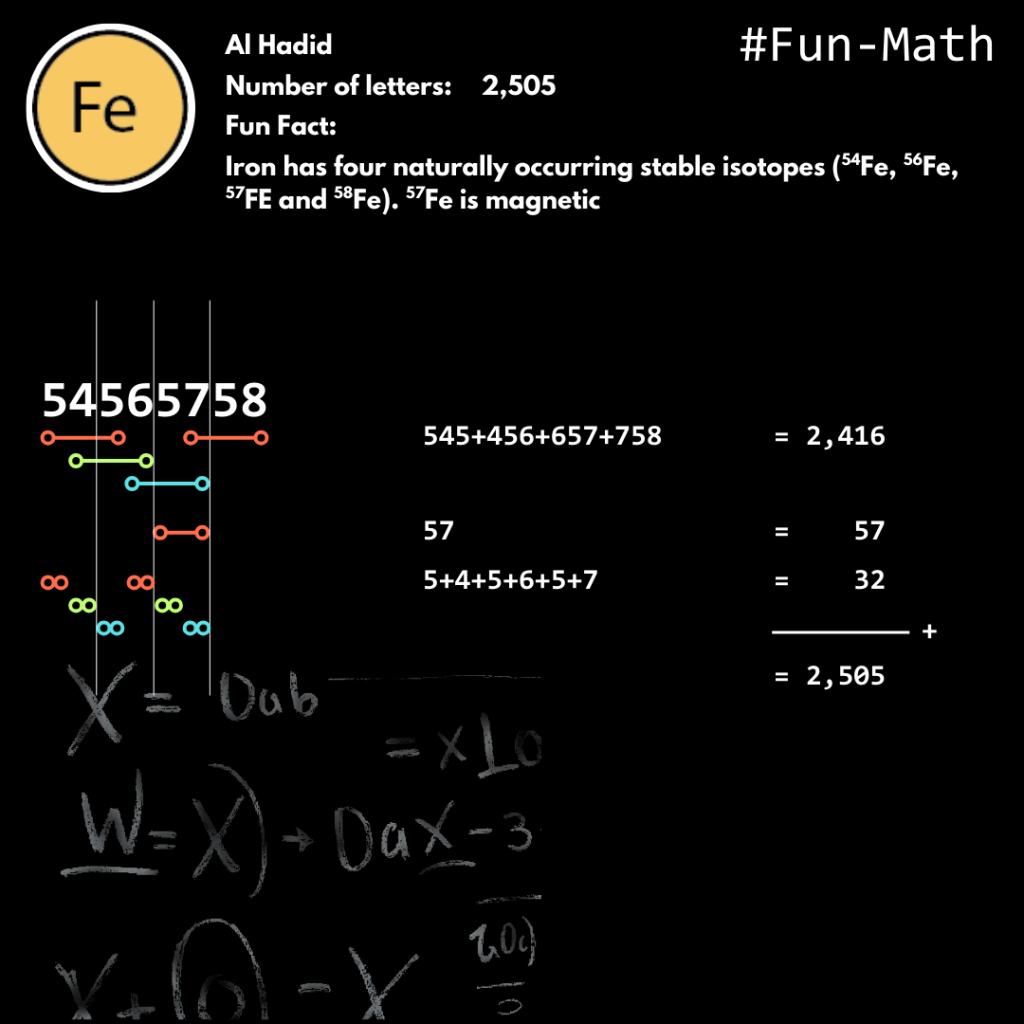
Al Hadid
Number of letters:
2,505
Fun Fact:
Iron has four naturally occurring stable isotopes (54Fe, 56Fe, 57Fe and 58Fe). 57Fe is magnetic
54565758
545+456+657+758 + 57 + 5+4+5+6+5+7 = 2,505
#Fun-Math
- Iron
- Besi
Iron is mentioned in Quran Chapter 57. In fact, Chapter 57 of the Quran is named “Al Hadid” (The Iron), and the only stable isotope of iron that exhibits magnetic properties is iron-57.
Iron [archive] has four naturally occurring stable isotopes (54Fe, 56Fe, 57Fe and 58Fe). 54Fe, 56Fe and 58Fe are non-magnetic because they have no nuclear spin (spin = 0), so they don’t have a magnetic moment. ⁵⁷Fe is magnetic because it has a nuclear spin of 1/2, which gives it a magnetic moment. This makes it useful in techniques like Mössbauer spectroscopy [archive] to study magnetic properties.
The magnetic properties of iron are defined by two fundamentally different phenomena: the ferromagnetic moment and the nuclear magnetic dipole moment. The ferromagnetic moment originates from the spin of the electrons in the outer shell (specifically the unpaired electrons in the 3d orbital) and is a macroscopic effect; this is the dominant source of iron’s powerful magnetism. When these electron spins align collectively across large regions called magnetic domains, they create a strong, measurable magnetic field, making iron a ferromagnetic material capable of forming permanent magnets. In sharp contrast, the nuclear magnetic dipole moment originates from the spin of the protons and neutrons within the nucleus (Fe−57 being the most relevant isotope with a spin of 1/2); this effect is subatomic, approximately 1,000 to 100,000 times weaker than the electron moment, and does not contribute to the bulk magnet you feel. Instead, the nuclear moment is crucial for highly specialized analytical techniques, such as Mössbauer spectroscopy, which uses this tiny nuclear magnetism to probe and study the local electronic and magnetic environment surrounding the iron atom.
Earth’s magnetic field and the Van Allen radiation belts are closely related, both playing a critical role in shielding earth from harmful solar and cosmic radiation with great might.
…And We sent down iron with its great might… (57:25)
Al Hadid 57:25
The word “sent down” in the Quranic verse (57:25) regarding iron alludes to its cosmic origins. Iron, like most elements heavier than hydrogen and helium, originates from stars. Here’s a breakdown of its cosmic journey to Earth:
1. Stellar Furnaces: Where Iron is Forged [archive]
Stars are giant cosmic furnaces. They primarily generate energy by fusing lighter elements into heavier ones in their cores. Initially, hydrogen fuses into helium. As stars age and run out of hydrogen fuel in their core, they start fusing helium into carbon, then carbon into oxygen, and so on.
This process of fusion continues until elements up to iron (Fe) are formed. Iron is unique because it has the most stable nucleus of any element. Fusing elements heavier than iron actually consumes energy rather than releasing it. This means that once a star’s core is primarily made of iron, nuclear fusion stops providing the outward pressure needed to counteract gravity. Massive stars (much larger than our Sun) go through various stages of fusion, eventually becoming red supergiants with an iron core.
2. Supernova Explosions: Spreading Iron Across the Universe
When a massive star’s iron core can no longer sustain fusion, gravity causes it to rapidly collapse. This collapse is incredibly violent. The sudden collapse leads to a massive explosion called a supernova. During this explosion, immense temperatures and pressures are generated. While iron is the heaviest element formed through standard stellar fusion, the extreme conditions of a supernova allow for the creation of elements heavier than iron through processes like rapid neutron capture (r-process). The supernova blasts the newly formed elements, including vast quantities of iron, out into interstellar space. This “stardust” mixes with existing gas and dust.
3. Formation of Our Solar System and Earth
Over billions of years, these enriched clouds of gas and dust (including the remnants of exploded stars) coalesce under their own gravity. Our own Solar System formed from such a nebula. The swirling cloud flattened into a disk, with the Sun forming at the center. Dust and gas particles in the disk collided and stuck together, gradually forming larger and larger bodies (planetesimals), and eventually planets like Earth. Because iron is a relatively heavy element, much of the iron in the early Earth sank towards the center, forming its dense, metallic core.
In summary, the iron found on Earth, including the vast amounts in its core and the smaller quantities in its crust, originated from the cores of massive stars that lived and died long before our Solar System even existed. We are, quite literally, made of stardust.
The word “great might” in the Quranic verse (57:25) can be understood in several ways, referring to iron’s inherent properties and its crucial roles:
The Great Might of Iron: Earth’s Magnetic Field and the Van Allen Belts
The Earth’s core is primarily composed of iron (Fe), with a significant amount of nickel (Ni), and smaller percentages of several lighter elements. Because we cannot directly sample the core, its composition is inferred from various geophysical data (like seismic wave velocities and Earth’s density) and geochemical models (comparing Earth’s composition to meteorites).
Here’s the generally accepted [archive] breakdown in terms of percentages by mass:
- Iron (Fe): ~85-90%
- Nickel (Ni): ~5-10%
- Lighter Elements: ~5-10%
The Earth’s magnetic field is primarily generated by a process called the geodynamo [archive], which occurs in the Earth’s outer core. This is a layer of molten iron alloy that surrounds the solid inner core. It’s this liquid outer core that is crucial for generating the magnetic field. Without the dynamic processes in the Earth’s outer core generating a strong magnetic field, the Van Allen Belts [archive] would not exist in their current form, and Earth would be much more vulnerable to the harmful radiation from space.
The Great Might of Iron: Hardening Iron [archive]
Iron’s “great might” is also evident in its ability to be hardened and strengthened through alloying. For instance, iron can be significantly hardened with manganese. Interestingly, the atomic number of Manganese (Mn) is 25, which is the same as the verse number of iron mentioned in Surah Al-Hadid, 57:25.
Iron, when alloyed with Manganese (to form steel), directly contributes to increased strength, hardness, and wear resistance. While carbon is the primary hardening agent in steel, manganese works in conjunction with carbon to amplify these effects:
- Hardenability: Manganese is exceptionally effective at increasing the hardenability of steel. Hardenability refers to the depth to which a steel can be hardened by heat treatment (quenching). Manganese achieves this by lowering the critical cooling rate required for the formation of martensite (a hard, brittle phase) and by influencing the transformation kinetics of austenite (the high-temperature phase of steel). This allows for more uniform hardening throughout a thicker section, making the steel stronger and more consistent.
- Solid Solution Strengthening: Manganese atoms dissolve within the iron crystal lattice, causing lattice distortion and hindering the movement of dislocations (defects in the crystal structure). This mechanism, known as solid solution strengthening, increases the material’s yield strength and tensile strength.
- Grain Refinement: In some cases, manganese can promote finer grain structures in steel, which generally leads to improved strength and toughness
In-depth information retrieval using AI and website.
Besi disebutkan dalam Surah ke-57 dalam Al-Qur’an. Bahkan, Surah ke-57 Al-Qur’an diberi nama “Al-Hadid” (Besi), dan satu-satunya isotop stabil besi yang memiliki sifat magnetik adalah besi-57.
Besi [archive] memiliki empat isotop stabil yang terjadi secara alami: 54Fe, 56Fe, 57Fe dan 58Fe. Isotop 54Fe, 56Fe dan 58Fe tidak bersifat magnetik karena tidak memiliki putaran nuklir (spin = 0), yang berarti mereka tidak memiliki momen magnetik. Sebaliknya, ⁵⁷Fe bersifat magnetik karena memiliki putaran nuklir 1/2, yang memberikan momen magnetik. Sifat ini membuat ⁵⁷Fe sangat berguna dalam teknik-teknik seperti spektroskopi Mössbauer [archive] untuk mempelajari sifat magnetik.
Sifat-sifat magnetik besi ditentukan oleh dua fenomena yang secara mendasar berbeda: momen feromagnetik dan momen dipol magnetik nuklir.
Momen feromagnetik bersumber dari spin elektron pada kulit terluar (khususnya elektron tak berpasangan di orbital 3d) dan merupakan efek makroskopis; inilah sumber dominan dari kemagnetan besi yang sangat kuat. Ketika spin-spin elektron ini terselaraskan secara kolektif di seluruh wilayah besar yang disebut domain magnetik, mereka menciptakan medan magnet yang kuat dan terukur, menjadikan besi material feromagnetik yang mampu membentuk magnet permanen. Sebaliknya, momen dipol magnetik nuklir bersumber dari spin proton dan neutron di dalam inti atom (Fe−57 menjadi isotop yang paling relevan dengan spin 1/2); efek ini bersifat subatomik, sekitar 1.000 hingga 100.000 kali lebih lemah daripada momen elektron, dan tidak berkontribusi pada magnet besar yang Anda rasakan. Sebaliknya, momen nuklir sangat penting untuk teknik analitik yang sangat khusus, seperti Spektroskopi Mössbauer, yang menggunakan kemagnetan nuklir yang sangat kecil ini untuk menyelidiki dan mempelajari lingkungan elektronik dan magnetik lokal di sekitar atom besi.
Medan magnet Bumi dan sabuk radiasi Van Allen sangat terkait erat, keduanya memainkan peran penting dalam melindungi Bumi dari radiasi matahari dan kosmik yang berbahaya dengan kekuatan yang hebat.
…Dan Kami menurunkan besi yang mempunyai kekuatan yang hebat (57:25)…
Al Hadid 57:25
Kata “diturunkan” dalam ayat Al-Quran (57:25) tentang besi mengacu pada asal-usul kosmisnya. Besi, seperti kebanyakan unsur yang lebih berat dari hidrogen dan helium, berasal dari bintang-bintang. Berikut adalah rincian perjalanan kosmis besi ke Bumi:
1. Tungku Bintang: Tempat Besi Ditempa [archive]
Bintang adalah tungku kosmis raksasa. Mereka terutama menghasilkan energi dengan menggabungkan unsur-unsur yang lebih ringan menjadi unsur-unsur yang lebih berat di intinya. Awalnya, hidrogen berfusi menjadi helium. Seiring bertambahnya usia bintang dan kehabisan bahan bakar hidrogen di intinya, mereka mulai menggabungkan helium menjadi karbon, kemudian karbon menjadi oksigen, dan seterusnya.
Proses fusi ini berlanjut hingga terbentuknya unsur-unsur hingga besi (Fe). Besi unik karena memiliki inti yang paling stabil dari semua unsur. Menggabungkan unsur-unsur yang lebih berat dari besi justru mengonsumsi energi daripada melepaskannya. Ini berarti bahwa begitu inti bintang sebagian besar terbuat dari besi, fusi nuklir berhenti memberikan tekanan ke luar yang diperlukan untuk melawan gravitasi. Bintang-bintang masif (jauh lebih besar dari Matahari kita) melalui berbagai tahap fusi, akhirnya menjadi raksasa merah dengan inti besi.
2. Ledakan Supernova: Menyebarkan Besi ke Seluruh Alam Semesta
Ketika inti besi bintang masif tidak dapat lagi mempertahankan fusi, gravitasi menyebabkannya runtuh dengan cepat. Keruntuhan ini sangat hebat. Keruntuhan yang tiba-tiba menyebabkan ledakan besar yang disebut supernova. Selama ledakan ini, suhu dan tekanan yang luar biasa dihasilkan. Meskipun besi adalah unsur terberat yang terbentuk melalui fusi bintang standar, kondisi ekstrem supernova memungkinkan penciptaan unsur-unsur yang lebih berat dari besi melalui proses seperti penangkapan neutron cepat (proses-r). Supernova menghamburkan unsur-unsur yang baru terbentuk, termasuk sejumlah besar besi, ke luar angkasa. “Debu bintang” ini bercampur dengan gas dan debu yang sudah ada.
3. Pembentukan Tata Surya dan Bumi Kita
Selama miliaran tahun, awan gas dan debu yang diperkaya ini (termasuk sisa-sisa bintang yang meledak) bergabung di bawah gravitasi mereka sendiri. Tata Surya kita terbentuk dari nebula semacam itu. Awan yang berputar-putar merata menjadi cakram, dengan Matahari terbentuk di tengahnya. Partikel debu dan gas di cakram bertabrakan dan saling menempel, secara bertahap membentuk benda-benda yang lebih besar (planetisimal), dan akhirnya planet-planet seperti Bumi. Karena besi adalah unsur yang relatif berat, sebagian besar besi di Bumi awal tenggelam ke pusat, membentuk intinya yang padat dan metalik.
Singkatnya, besi yang ditemukan di Bumi, termasuk jumlah besar di intinya dan jumlah yang lebih kecil di kerak bumi, berasal dari inti bintang-bintang masif yang hidup dan mati jauh sebelum Tata Surya kita ada. Kita, secara harfiah, terbuat dari debu bintang.
Kata “kekuatan yang hebat” dalam ayat Al-Quran (57:25) dapat dipahami dalam beberapa cara, mengacu pada sifat inheren besi dan peran pentingnya:
Kekuatan Besi yang Hebat: Medan Magnet Bumi dan Sabuk Van Allen
Inti Bumi sebagian besar terdiri dari besi (Fe), dengan sejumlah besar nikel (Ni), dan persentase yang lebih kecil dari beberapa unsur ringan. Karena kita tidak dapat langsung mengambil sampel inti bumi, komposisinya disimpulkan dari berbagai data geofisika (seperti kecepatan gelombang seismik dan kepadatan Bumi) serta model geokimia (membandingkan komposisi Bumi dengan meteorit).
Berikut adalah rincian persentase massa yang diterima secara umum [archive]:
- Besi (Fe): ~85-90%
- Nikel (Ni): ~5-10%
- Unsur Ringan: ~5-10%
Medan magnet Bumi terutama dihasilkan oleh proses yang disebut geodinamika [archive], yang terjadi di inti luar Bumi. Ini adalah lapisan paduan besi cair yang mengelilingi inti dalam yang padat. Inti luar cair inilah yang sangat penting untuk menghasilkan medan magnet. Tanpa proses dinamis di inti luar Bumi yang menghasilkan medan magnet yang kuat, Sabuk Van Allen [archive] tidak akan ada dalam bentuknya saat ini, dan Bumi akan jauh lebih rentan terhadap radiasi berbahaya dari luar angkasa.
Kekuatan Besi yang Hebat: Pengerasan Besi [archive]
“Kekuatan hebat” besi juga terlihat dari kemampuannya untuk dikeraskan dan diperkuat melalui paduan. Misalnya, besi dapat dikeraskan secara signifikan dengan mangan. Menariknya, nomor atom Mangan (Mn) adalah 25, sama dengan nomor ayat besi yang disebutkan dalam Surah Al-Hadid, 57:25.
Besi, ketika dipadukan dengan Mangan (untuk membentuk baja), secara langsung berkontribusi pada peningkatan kekuatan, kekerasan, dan ketahanan aus. Meskipun karbon adalah agen pengerasan utama dalam baja, mangan bekerja bersama karbon untuk memperkuat efek-efek ini:
- Kemampuan Keras (Hardenability): Mangan sangat efektif dalam meningkatkan kemampuan keras baja. Kemampuan keras mengacu pada kedalaman di mana baja dapat dikeraskan melalui perlakuan panas (quenching). Mangan mencapai ini dengan menurunkan laju pendinginan kritis yang diperlukan untuk pembentukan martensit (fase keras dan rapuh) dan dengan memengaruhi kinetika transformasi austenit (fase baja suhu tinggi). Hal ini memungkinkan pengerasan yang lebih seragam di seluruh bagian yang lebih tebal, membuat baja lebih kuat dan lebih konsisten.
- Penguatan Larutan Padat (Solid Solution Strengthening): Atom mangan larut dalam kisi kristal besi, menyebabkan distorsi kisi dan menghambat pergerakan dislokasi (cacat dalam struktur kristal). Mekanisme ini, yang dikenal sebagai penguatan larutan padat, meningkatkan kekuatan luluh dan kekuatan tarik material.
- Perbaikan Butiran (Grain Refinement): Dalam beberapa kasus, mangan dapat mendorong struktur butiran yang lebih halus pada baja, yang umumnya menghasilkan kekuatan dan ketangguhan yang lebih baik.
Penggalian informasi mendalam dengan bantuan AI dan situs web.
The Man is mentioned in Quran Chapter 76. In fact, Chapter 76 of the Quran is named “Al Insan” (The Man). Human begins from a drop of mixed fluid (nothing yet worth mentioning), where a single sperm carries 23 chromosomes — not pairs. Within that sperm, genes like p53 silently prepare to guard the future embryo’s genetic integrity.
Fun Fact: The Man (Al Insan)

Manusia disebutkan dalam Quran Surah 76. Bahkan, Surah 76 dalam Quran dinamakan “Al Insan” (Manusia). Manusia bermula dari setetes air mani bercampur (belum ada sesuatu yang berarti untuk disebutkan), di mana satu sel sperma membawa 23 kromosom — bukan berpasangan. Di dalam sperma itu, gen seperti p53 diam-diam bersiap untuk menjaga integritas genetik embrio di masa depan.
Fun Fact: Manusia (Al Insan)
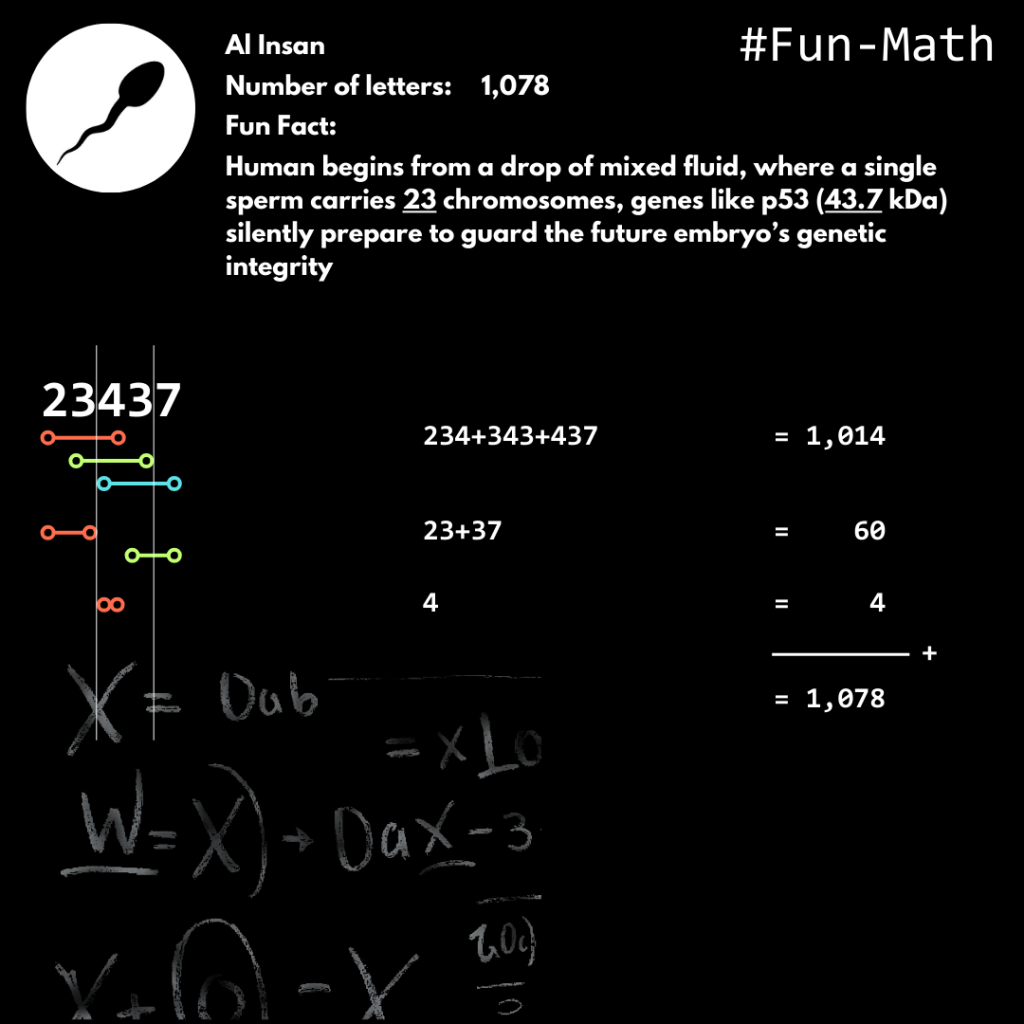
Al Insan
Number of letters:
1,078
Fun Fact:
Human begins from a drop of mixed fluid, where a single sperm carries 23 chromosomes, genes like p53 (43.7 kDa) silently prepare to guard the future embryo’s genetic integrity
23437
234+343+437 + 23+37 + 4 = 1,078
#Fun-Math
- The Man
- Manusia
The Man is mentioned in Quran Chapter 76. In fact, Chapter 76 of the Quran is named “Al Insan” (The Man). Human begins from a drop of mixed fluid (nothing yet worth mentioning), where a single sperm carries 23 chromosomes [archive] — not pairs. Within that sperm, genes like p53 silently prepare to guard the future embryo’s genetic integrity.
Is there not a period of time when each human is nothing yet worth mentioning? ˹For˺ indeed, We ˹alone˺ created humans from a drop of mixed fluids, ˹in order˺ to test them, so We made them hear and see.
Al Insan 76:1-2
Human reproduction, from the formation of gametes to the earliest stages of embryonic development, is profoundly influenced by the TP53 gene and the critical p53 protein it encodes. Often hailed as the “guardian of the genome,” [archive] p53‘s role extends beyond its well-known function in cancer suppression to actively police the integrity of genetic material, including the unique chromosome 23 (the Y chromosome) of sperm, at every step towards successful fertilization and beyond.
During the demanding process of sperm production, known as spermatogenesis, the TP53 gene, located on chromosome 17, is indispensable. It acts as a vigilant quality control checkpoint, scrutinizing the vast amount of DNA replication and meiotic division occurring in developing sperm. If significant DNA damage is detected, whether on autosomes or the sex chromosomes including the Y chromosome (chromosome 23), p53 can trigger cell cycle arrest to allow for repair or, if the damage is too severe, induce apoptosis (programmed cell death). This crucial mechanism ensures that only sperm carrying intact and healthy genetic material, including a fully functional Y chromosome essential for male offspring, are allowed to mature. Without this vital surveillance, compromised sperm with fragmented DNA or chromosomal aberrations, potentially including Y chromosome deletions common in male infertility, could proceed to fertilization, leading to failed pregnancies or developmental issues.
The influence of TP53 extends directly into the momentous event of fertilization and the subsequent delicate stages of early embryonic development. Once fertilization occurs, the newly formed embryo, a fusion of genetic material from both parents, continues to be under p53‘s watchful eye. If the combined DNA from the sperm (including its X or Y chromosome) and egg contains errors or aneuploidies, p53 can orchestrate the elimination of compromised embryonic cells, acting as a safeguard against developmental abnormalities. Beyond this intrinsic embryonic quality control, p53 in the maternal uterus plays a pivotal role in implantation. It regulates the expression of key factors, such as Leukemia Inhibitory Factor (LIF), which are essential for the uterine lining to become receptive to the implanting blastocyst. Genetic variations in TP53 have been associated with implantation failure, highlighting that the success of fertilization is not solely dependent on gamete quality, but also on the maternal environment influenced by this guardian protein. Thus, from the initial production of viable sperm with their intact chromosome 23, through the meticulous quality checks of the early embryo, to the critical stage of uterine receptivity, TP53 stands as a fundamental player in the intricate biological symphony of human reproduction.
The name p53 comes from the combination of the letter “p”, which stands for “protein”, and the number “53“, which refers to its apparent molecular weight of approximately 53 kilodaltons as measured during early laboratory experiments. Interestingly, the actual molecular weight of the p53 protein based on its amino acid sequence is closer to 43.7 kilodaltons, but it migrates more slowly in gel electrophoresis due to post-translational modifications, making it appear heavier. This discrepancy is common in protein analysis and led to the protein being universally recognized and named p53 in scientific literature.
In-depth information retrieval using AI and website.
Manusia disebutkan dalam Quran Surah 76. Bahkan, Surah 76 dalam Quran dinamakan “Al Insan” (Manusia). Manusia bermula dari setetes air mani bercampur (belum ada sesuatu yang berarti untuk disebutkan), di mana satu sel sperma membawa 23 kromosom [archive] — bukan berpasangan. Di dalam sperma itu, gen seperti p53 diam-diam bersiap untuk menjaga integritas genetik embrio di masa depan.
Bukankah telah datang atas manusia suatu waktu dari masa, sedang dia ketika itu belum merupakan sesuatu yang dapat disebut Sesungguhnya Kami telah menciptakan manusia dari setetes mani yang bercampur yang Kami hendak mengujinya (dengan perintah dan larangan), karena itu Kami jadikan dia mendengar dan melihat.
Al Insan 76:1-2
Reproduksi manusia, dari pembentukan gamet hingga tahap awal perkembangan embrio, sangat dipengaruhi oleh gen TP53 dan protein p53 penting yang dikodekannya. Sering disebut sebagai “penjaga genom,” [archive] peran p53 melampaui fungsi yang dikenal luas dalam penekanan kanker untuk secara aktif mengawasi integritas materi genetik, termasuk kromosom 23 yang unik (kromosom Y) pada sperma, di setiap langkah menuju pembuahan yang berhasil dan seterusnya.
Selama proses produksi sperma yang menuntut, yang dikenal sebagai spermatogenesis, gen TP53, yang terletak pada kromosom 17, sangat diperlukan. Gen ini bertindak sebagai pos pemeriksaan kontrol kualitas yang waspada, memeriksa sejumlah besar replikasi DNA dan pembelahan meiosis yang terjadi pada sperma yang sedang berkembang. Jika terdeteksi kerusakan DNA yang signifikan, baik pada autosom maupun kromosom seks termasuk kromosom Y (kromosom 23), p53 dapat memicu penghentian siklus sel untuk memungkinkan perbaikan atau, jika kerusakan terlalu parah, menginduksi apoptosis (kematian sel terprogram). Mekanisme penting ini memastikan bahwa hanya sperma yang membawa materi genetik yang utuh dan sehat, termasuk kromosom Y yang berfungsi penuh yang penting untuk keturunan laki-laki, yang diizinkan untuk matang. Tanpa pengawasan vital ini, sperma yang terganggu dengan DNA yang terfragmentasi atau aberasi kromosom, berpotensi termasuk delesi kromosom Y yang umum pada infertilitas pria, dapat melanjutkan ke pembuahan, menyebabkan kegagalan kehamilan atau masalah perkembangan.
Pengaruh TP53 meluas langsung ke peristiwa penting pembuahan dan tahap-tahap perkembangan embrio awal yang halus. Setelah pembuahan terjadi, embrio yang baru terbentuk, perpaduan materi genetik dari kedua orang tua, terus berada di bawah pengawasan p53. Jika DNA gabungan dari sperma (termasuk kromosom X atau Y-nya) dan sel telur mengandung kesalahan atau aneuploidi, p53 dapat mengatur eliminasi sel-sel embrio yang terganggu, bertindak sebagai pengaman terhadap kelainan perkembangan. Di luar kontrol kualitas embrio intrinsik ini, p53 dalam rahim ibu memainkan peran penting dalam implantasi. Ia mengatur ekspresi faktor-faktor kunci, seperti Faktor Penghambat Leukemia (LIF), yang penting agar lapisan rahim menjadi reseptif terhadap blastokista yang akan berimplantasi. Variasi genetik pada TP53 telah dikaitkan dengan kegagalan implantasi, menyoroti bahwa keberhasilan pembuahan tidak hanya bergantung pada kualitas gamet, tetapi juga pada lingkungan maternal yang dipengaruhi oleh protein penjaga ini. Dengan demikian, dari produksi awal sperma yang layak dengan kromosom 23 yang utuh, melalui pemeriksaan kualitas yang cermat pada embrio awal, hingga tahap kritis reseptifitas rahim, TP53 berdiri sebagai pemain fundamental dalam simfoni biologis reproduksi manusia yang rumit.
Nama p53 berasal dari kombinasi huruf “p” yang merupakan singkatan dari “protein”, dan angka “53” yang merujuk pada berat molekul tampak sekitar 53 kilodalton sebagaimana diukur dalam eksperimen laboratorium awal. Menariknya, berat molekul sebenarnya dari protein p53 berdasarkan urutan asam aminonya justru mendekati 43,7 kilodalton, namun protein ini bermigrasi lebih lambat dalam elektroforesis gel karena mengalami modifikasi pasca-translasi, sehingga terlihat lebih berat. Ketidaksesuaian ini umum terjadi dalam analisis protein dan menyebabkan protein ini secara luas dikenal serta dinamai p53 dalam literatur ilmiah.
Penggalian informasi mendalam dengan bantuan AI dan situs web.
The Genie is mentioned in Quran Chapter 72. In fact, Chapter 72 of the Quran is named “Al Jin” (The Genie). In Quran 55:15 and 15:27 stated that a genie was created from a smokeless flame of intensely hot fire.
Is there any smokeless flame of intensely hot fire in the universe? Yes, nuclear fusion in stars produces this. H fusion occurs at around 15 million °C, 4He fusion occurs at around 100 million °C, so on, within stars.
4He (α particle) can be produced when 1 neutron is absorbed by a Boron (B, atom number 5), which has 5 protons and 5 neutrons (10B). This absorption forms an unstable, excited Boron-11 (11B∗), then immediately decays, yielding a 2 different energies (4He or α with atom number of 2 and γ) and a 7Li; or a 7Li and 2 energies.
Fun Fact: The Genie (Al Jin)

Jin disebutkan dalam Al-Quran Surah ke-72. Bahkan, Surah 72 Al-Quran dinamai “Al-Jin”. Dalam Al-Quran Surah 55:15 dan 15:27 disebutkan bahwa jin diciptakan dari nyala api yang sangat panas dan tanpa asap.
Adakah nyala api yang sangat panas dan tanpa asap di alam semesta? Ya, fusi nuklir di bintang-bintang menghasilkannya. Fusi H terjadi pada sekitar 15 juta °C, fusi 4He terjadi pada sekitar 100 juta °C, dst, di dalam bintang.
4He (partikel α) dapat dihasilkan ketika 1 neutron diserap oleh Boron (B, nomor atom 5), yang memiliki 5 proton dan 5 neutron (10B). Penyerapan ini membentuk Boron-11 (11B∗) yang tidak stabil dan tereksitasi, kemudian segera meluruh, menghasilkan 2 energi berbeda (4He atau α dengan nomor atom 2) dan 7Li; atau 7Li dan 2 energi.
Fun Fact: Jin (Al Jin)
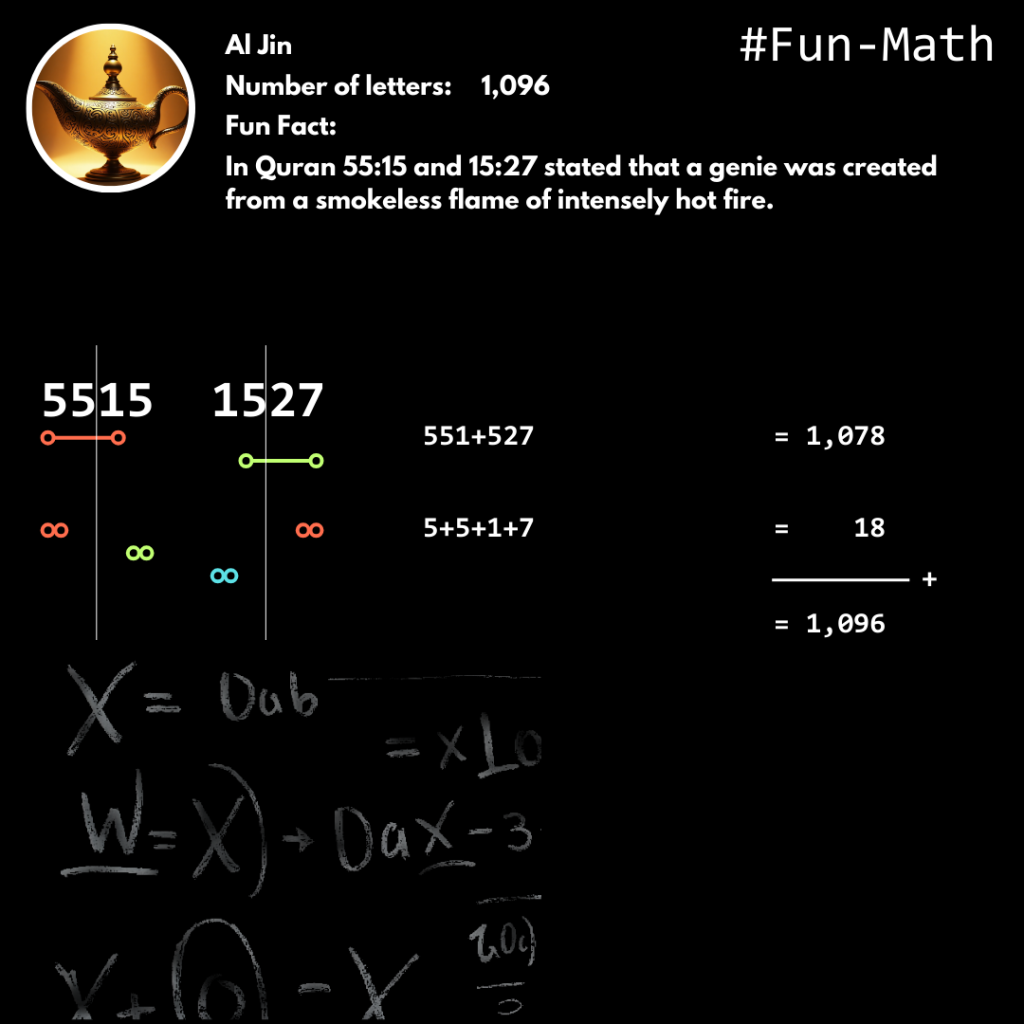
Al Jin
Number of letters:
1,096
Fun Fact:
In Quran 55:15 and 15:27 stated that a genie was created from a smokeless flame of intensely hot fire.
5515 1527
551+527 + 5+5+1+7 = 1,096
#Fun-Math
- The Genie
- Jin
The Genie is mentioned in Quran Chapter 72. In fact, Chapter 72 of the Quran is named “Al Jin” (The Genie). In Quran 55:15 and 15:27 stated that a genie was created from a smokeless flame of intensely hot fire. Is there any smokeless flame of intensely hot fire in the universe? Yes, nuclear fusion in stars produces this. H fusion occurs at around 15 million °C, 4He fusion occurs at around 100 million °C, so on, within stars. 4He (α particle) can be produced when 1 neutron is absorbed by a Boron (B, atom number 5), which has 5 protons and 5 neutrons (10B or ![]() ). This absorption forms an unstable, excited Boron-11 (11B∗), then immediately decays, yielding a 2 different energies (4He or α with atom number of 2 and γ) and a 7Li; or a 7Li and 2 energies.
). This absorption forms an unstable, excited Boron-11 (11B∗), then immediately decays, yielding a 2 different energies (4He or α with atom number of 2 and γ) and a 7Li; or a 7Li and 2 energies.
The nuclear reaction can be written as follows [archive]:
10B + n → 11B∗ → 7Li + 4He + γ or 7Li + α + γ
Stars are essentially giant nuclear fusion reactors [archive], and hydrogen (H) and helium (He) are their primary fuels. Here’s how they work:
A star’s core as an incredibly hot (around 15 million °C) and dense furnace. Here, immense pressure and heat force hydrogen atoms to smash together. This process, called nuclear fusion, converts hydrogen into helium. In doing so, a tiny bit of mass is transformed into a huge amount of energy. This energy is what makes stars shine so brightly and keeps them from collapsing under their own gravity. This is the longest stage of a star’s life, like our Sun’s current phase.
Once a star has exhausted most of the hydrogen in its core, its life begins to change significantly. Without hydrogen fusion providing outward pressure, gravity causes the inert helium core to contract and heat up. As the core contracts, the layer of hydrogen surrounding it gets denser and hotter, eventually reaching conditions suitable for hydrogen fusion to occur in a shell around the core. This causes the star to expand significantly and become a red giant. When the helium core reaches an incredibly high temperature (around 100 million °C) and density, helium nuclei can begin to fuse.
This process is called the triple-alpha process:
- Two helium-4 (4He) fuse to form an unstable beryllium-8 (8Be)
- Before the 8Be can decay, it must quickly capture another 4He to form a stable carbon-12 (12C)
In very massive stars, after the helium is exhausted, the core can continue to contract and heat up, allowing for the fusion of even heavier elements like carbon, oxygen, neon, and so on, in successive layers, resembling an onion. This process continues until iron is formed. Fusion reactions that produce elements heavier than iron consume energy rather than releasing it, leading to the collapse of the core and often a supernova explosion.
Nuclear fusion doesn’t produce smoke.
In-depth information retrieval using AI and website.
Jin disebutkan dalam Al-Quran Surah ke-72. Bahkan, Surah 72 Al-Quran dinamai “Al-Jin”. Dalam Al-Quran Surah 55:15 dan 15:27 disebutkan bahwa jin diciptakan dari nyala api yang sangat panas dan tanpa asap. Adakah nyala api yang sangat panas dan tanpa asap di alam semesta? Ya, fusi nuklir di bintang-bintang menghasilkannya. Fusi H terjadi pada sekitar 15 juta °C, fusi 4He terjadi pada sekitar 100 juta °C, dst, di dalam bintang. 4He (partikel α) dapat dihasilkan ketika 1 neutron diserap oleh Boron (B, nomor atom 5), yang memiliki 5 proton dan 5 neutron (10B atau ![]() ). Penyerapan ini membentuk inti Boron-11 (11B∗) yang tidak stabil dan tereksitasi, kemudian segera meluruh, menghasilkan 2 energi berbeda (4He atau α dengan nomor atom 2) dan 7Li; atau 7Li dan 2 energi.
). Penyerapan ini membentuk inti Boron-11 (11B∗) yang tidak stabil dan tereksitasi, kemudian segera meluruh, menghasilkan 2 energi berbeda (4He atau α dengan nomor atom 2) dan 7Li; atau 7Li dan 2 energi.
Reaksi nuklir tersebut dapat ditulis sebagai berikut [archive]:
10B + n → 11B∗ → 7Li + 4He + γ or 7Li + α + γ
Bintang-bintang pada dasarnya adalah reaktor fusi nuklir [archive] raksasa, dan hidrogen (H) serta helium (He) adalah bahan bakar utamanya. Begini cara kerjanya:
Inti bintang adalah tungku yang sangat panas (sekitar 15 juta °C) dan padat. Di sini, tekanan dan panas yang luar biasa memaksa atom-atom hidrogen untuk bertabrakan. Proses ini, yang disebut fusi nuklir, mengubah hidrogen menjadi helium. Dengan demikian, sedikit massa diubah menjadi energi yang sangat besar. Energi inilah yang membuat bintang bersinar sangat terang dan mencegahnya runtuh karena gravitasinya sendiri. Ini adalah tahap terpanjang dalam kehidupan bintang, seperti fase Matahari kita saat ini.
Setelah sebuah bintang menghabiskan sebagian besar hidrogen di intinya, kehidupannya mulai berubah secara signifikan. Tanpa fusi hidrogen yang memberikan tekanan keluar, gravitasi menyebabkan inti helium yang lembam mengerut dan memanas. Saat inti mengerut, lapisan hidrogen di sekitarnya menjadi lebih padat dan panas, akhirnya mencapai kondisi yang cocok untuk terjadinya fusi hidrogen di cangkang di sekitar inti. Hal ini menyebabkan bintang mengembang secara signifikan dan menjadi raksasa merah. Ketika inti helium mencapai suhu (sekitar 100 juta °C) dan kepadatan yang sangat tinggi, inti helium dapat mulai berfusi.
Proses ini disebut proses triple-alpha:
- Dua inti helium-4 (4He) berfusi membentuk berilium-8 (8Be) yang tidak stabil.
- Sebelum 8Be dapat meluruh, ia harus dengan cepat menangkap inti 4He lain untuk membentuk karbon-12 (12C) yang stabil.
Pada bintang yang sangat masif, setelah helium habis, intinya dapat terus mengerut dan memanas, memungkinkan terjadinya fusi unsur-unsur yang lebih berat seperti karbon, oksigen, neon, dan seterusnya, dalam lapisan-lapisan berturut-turut, menyerupai bawang. Proses ini berlanjut hingga terbentuknya besi. Reaksi fusi yang menghasilkan unsur-unsur lebih berat dari besi justru mengonsumsi energi daripada melepaskannya, yang mengarah pada keruntuhan inti dan sering kali ledakan supernova.
Fusi nuklir tidak menghasilkan asap.
Penggalian informasi mendalam dengan bantuan AI dan situs web.
The sun is mentioned in Quran Chapter 91. In fact, Chapter 91 of the Quran is named “Ash Shams” (The Sun), and mention day and night. By the way, did you know that the true length of a day (sidereal day) is approximately 23 hours, 56 minutes, and 4.091 seconds?
Fun Fact: The Sun (Ash Shams)

Matahari disebutkan dalam Al-Qur’an Surah 91. Faktanya, Surah 91 dalam Al-Qur’an dinamakan “Asy-Syams” (Matahari), dan menyebutkan siang dan malam. Ngomong-ngomong, tahukah Anda bahwa panjang sebenarnya dari satu hari (hari sideral) adalah sekitar 23 jam, 56 menit, dan 4,091 detik?
Fun Fact: Matahari (Asy Syams)
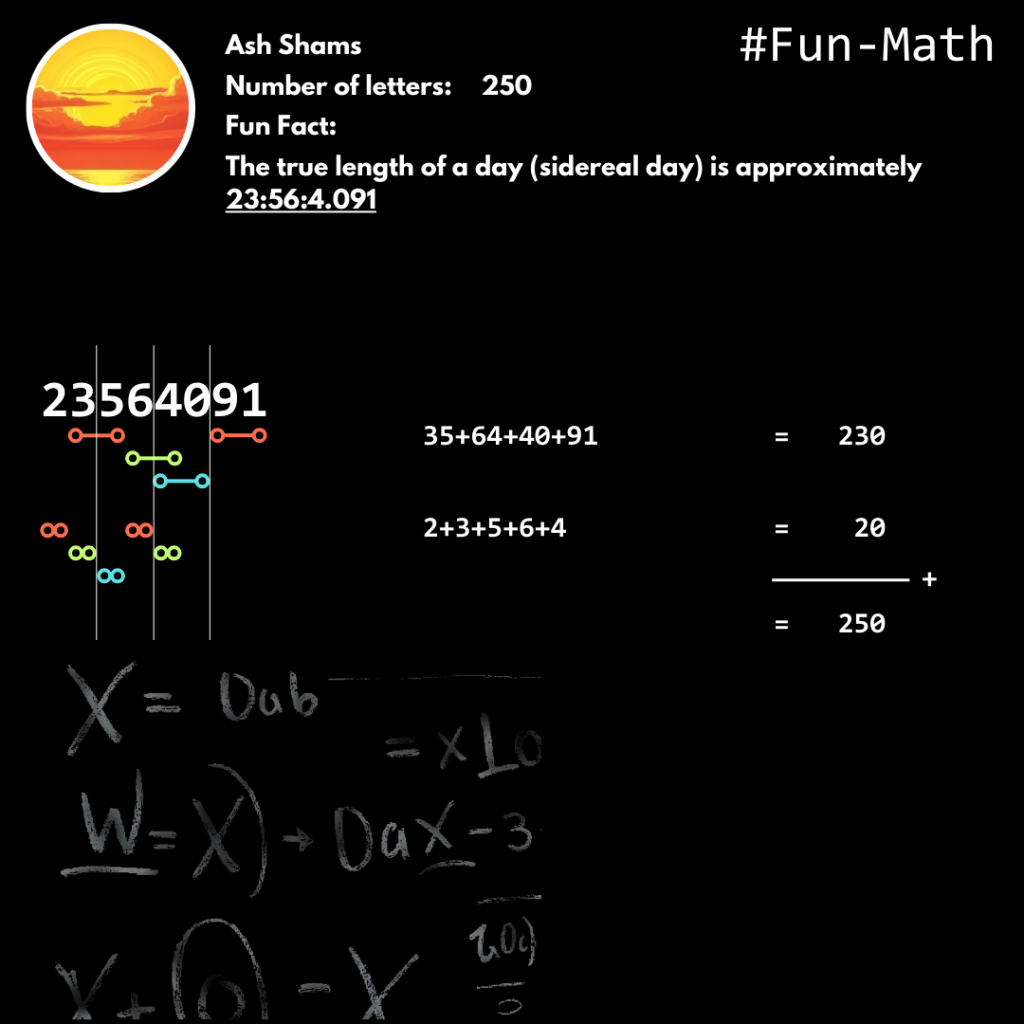
Ash Shams
Number of letters:
250
Fun Fact:
The true length of a day (sidereal day) is approximately 23:56:4.091
23564091
35+64+40+91 + 2+3+5+6+4 = 250
#Fun-Math
- The Sun
- Matahari
The sun is mentioned in Quran Chapter 91. In fact, Chapter 91 of the Quran is named “Ash Shams” (The Sun), and mention day and night. By the way, did you know that the true length of a day (sidereal day) is approximately 23 hours, 56 minutes, and 4.091 seconds?
By the sun and its brightness, and the moon as it follows it, and the day as it unveils it, and the night as it conceals it!
Ash Shams 91:1-4
Every day, the sun rises, brings light, and then sets, ushering in the night. This familiar cycle, which we measure as roughly 24 hours, is how we mark time and live our lives. But there’s a little secret to Earth’s spin that makes the real story of day and night even more fascinating.
Our everyday 24-hour day is called a “solar day.” It’s the time it takes for the Sun to appear in the same spot in the sky, like from one noon to the next. This makes perfect sense for us, as it keeps our clocks and schedules in line with the sun.
However, Earth has another, slightly shorter “day” called a “sidereal day” [archive]. This is the actual time it takes for Earth to make one complete turn on its own axis, a full 360-degree spin, when measured against the distant stars. This true spin takes about 23 hours, 56 minutes, and 4.091 seconds.
The reason for this tiny difference – that extra roughly 4 minutes – is because Earth isn’t just spinning; it’s also constantly moving around the Sun. Imagine Earth spinning like a top while also moving along a big circle. By the time Earth finishes one complete spin (its “sidereal day”), it has also moved a little bit in its path around the Sun. To “catch up” with the Sun and make it appear in the same place in the sky again, Earth has to spin just a tiny bit further. That extra little spin is what adds those roughly 4 minutes to our familiar 24-hour solar day.
In-depth information retrieval using AI and website.
Matahari disebutkan dalam Al-Qur’an Surah 91. Faktanya, Surah 91 dalam Al-Qur’an dinamakan “Asy-Syams” (Matahari), dan menyebutkan siang dan malam. Ngomong-ngomong, tahukah Anda bahwa panjang sebenarnya dari satu hari (hari sideral) adalah sekitar 23 jam, 56 menit, dan 4,091 detik?
Demi matahari dan cahayanya di pagi hari, dan bulan apabila mengiringinya, dan siang apabila menampakkannya, dan malam apabila menutupinya (gelap gulita).
Asy-Syams 91:1-4
Setiap hari, matahari terbit, membawa cahaya, lalu terbenam, mengantarkan malam. Siklus yang akrab ini, yang kita ukur sekitar 24 jam, adalah bagaimana kita menandai waktu dan menjalani hidup. Namun, ada sedikit rahasia dalam putaran Bumi yang membuat kisah siang dan malam menjadi lebih menarik.
Hari 24 jam kita sehari-hari disebut “hari matahari” (solar day). Ini adalah waktu yang dibutuhkan Matahari untuk muncul di tempat yang sama di langit, seperti dari tengah hari ke tengah hari berikutnya. Ini sangat masuk akal bagi kita, karena menjaga jam dan jadwal kita selaras dengan matahari.
Namun, Bumi memiliki “hari” lain yang sedikit lebih pendek, yang disebut “hari sideral” (sidereal day) [archive]. Ini adalah waktu sebenarnya yang dibutuhkan Bumi untuk melakukan satu putaran penuh pada porosnya sendiri, putaran 360 derajat penuh, jika diukur terhadap bintang-bintang yang jauh. Putaran sejati ini memakan waktu sekitar 23 jam, 56 menit, dan 4,091 detik.
Alasan untuk perbedaan kecil ini – tambahan sekitar 4 menit – adalah karena Bumi tidak hanya berputar; ia juga terus bergerak mengelilingi Matahari. Bayangkan Bumi berputar seperti gasing sambil juga bergerak dalam lingkaran besar. Pada saat Bumi menyelesaikan satu putaran penuh (hari sideralnya), ia juga telah bergerak sedikit di jalurnya mengelilingi Matahari. Untuk “mengejar” Matahari dan membuatnya muncul di tempat yang sama di langit lagi, Bumi harus berputar sedikit lebih jauh. Putaran ekstra kecil itulah yang menambahkan sekitar 4 menit ke hari matahari 24 jam kita yang sudah dikenal.
Penggalian informasi mendalam dengan bantuan AI dan situs web.
Chapter 92 of the Quran is named “Al-Layl” (The Night). In Verses 1 and 2, it discusses the principle of sunlight and when darkness covers it at night. Approximately 92% of the Earth’s surface experiences this daily cycle without fail, while about 8% does not. There, in this approximately 8% of Earth’s surface, the Sun either never rises above the horizon (during polar night) or never sets below the horizon (during the midnight sun) for a period ranging from 24 hours to approximately six months
Fun Fact: The Night (Al Layl)

Surah ke-92 dalam Al-Qur’an dinamai “Al-Layl” (Malam). Pada Ayat 1 dan 2, dibahas tentang prinsip sinar matahari dan bagaimana kegelapan menyelimutinya di malam hari. Sekitar 92% permukaan Bumi mengalami siklus harian ini tanpa henti, sementara sekitar 8% tidak. Di sana, di sekitar 8% permukaan Bumi ini, Matahari terkadang tidak pernah terbit di atas ufuk (selama malam kutub) atau tidak pernah terbenam di bawah ufuk (selama matahari tengah malam) untuk periode yang berkisar dari 24 jam hingga sekitar enam bulan.
Fun Fact: Malam (Al Layl)
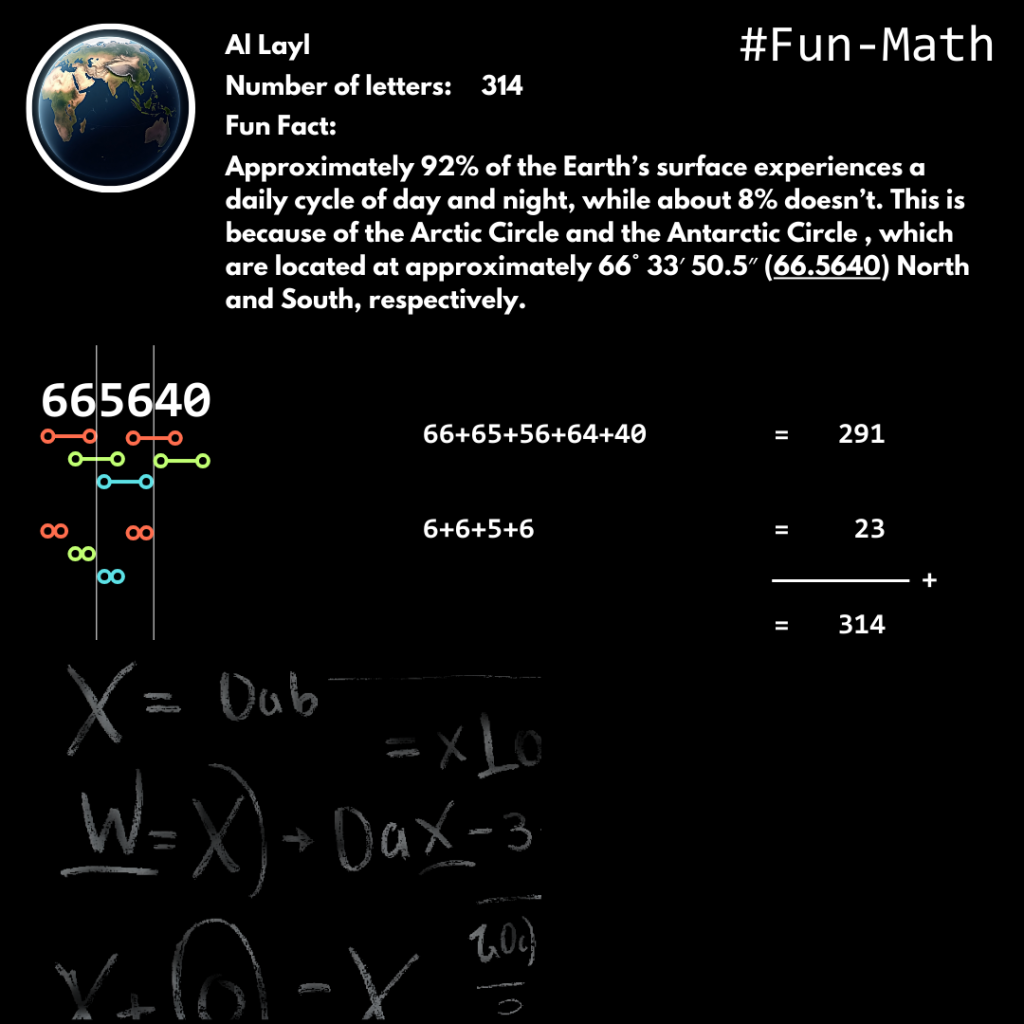
Al Layl
Number of letters:
314
Fun Fact:
Approximately 92% of the Earth’s surface experiences a daily cycle of day and night, while about 8% doesn’t. This is because of the Arctic Circle and the Antarctic Circle , which are located at approximately 66° 33′ 50.5″ (66.5640) North and South, respectively.
665640
66+65+56+64+40 + 6+6+5+6 = 314
#Fun-Math
- The Night
- Malam
Chapter 92 of the Quran is named “Al-Layl” (The Night). In Verses 1 and 2, it discusses the principle of sunlight and when darkness covers it at night. Approximately 92% of the Earth’s surface experiences this daily cycle without fail, while about 8% does not. There, in this approximately 8% of Earth’s surface, the Sun either never rises above the horizon (during polar night) or never sets below the horizon (during the midnight sun) for a period ranging from 24 hours to approximately six months
Normally a day consists of both daytime and nighttime. However, there are specific regions on Earth where this isn’t always the case for certain periods of the year. This fascinating phenomenon occurs in the polar regions, specifically within the Arctic and Antarctic Circles.
The Arctic Circle in the Northern Hemisphere and the Antarctic Circle in the Southern Hemisphere are parallels of latitude located at approximately 66° 33′ 50.5″ (66.5640277777778 ≈ 66.5640) North [archive] and South [archive], respectively. These circles are significant because they mark the boundaries where, for at least one day per year, the sun can remain continuously above the horizon (the midnight sun) or continuously below the horizon (the polar night). The exact latitude of these circles subtly shifts over long periods due to minor changes in Earth’s axial tilt.
Portion of Earth’s surface at ϕ latitudes
= (1 – sin(ϕ)) / 2
where:
ϕ = 66°33′50.5′′
ϕ = 66 + 33/60 + 50.5/3600
ϕ ≈ 66.5640°
then
Portion of Earth’s surface at 66.5640° latitudes
= (1 – sin(ϕ)) / 2
= (1 – sin(66.5640°)) / 2
≈ (1 – 0.92) / 2
≈ 0.04
Arctic and Antarctic Circle
≈ 0.04 + 0.04
≈ 0.08
Outside Arctic and Antarctic Circle
≈ 0.92
In-depth information retrieval using AI and website.
Surah ke-92 dalam Al-Qur’an dinamai “Al-Layl” (Malam). Pada Ayat 1 dan 2, dibahas tentang prinsip sinar matahari dan bagaimana kegelapan menyelimutinya di malam hari. Sekitar 92% permukaan Bumi mengalami siklus harian ini tanpa henti, sementara sekitar 8% tidak. Di sana, di sekitar 8% permukaan Bumi ini, Matahari terkadang tidak pernah terbit di atas ufuk (selama malam kutub) atau tidak pernah terbenam di bawah ufuk (selama matahari tengah malam) untuk periode yang berkisar dari 24 jam hingga sekitar enam bulan.
Normalnya, satu hari terdiri dari siang dan malam. Namun, ada wilayah tertentu di Bumi di mana hal ini tidak selalu terjadi selama periode tertentu dalam setahun. Fenomena menarik ini terjadi di daerah kutub, khususnya di dalam Lingkaran Arktik dan Antartika.
Lingkaran Arktik di Belahan Bumi Utara dan Lingkaran Antartika di Belahan Bumi Selatan adalah garis lintang yang terletak kira-kira pada 66° 33′ 50.5″ (66,5640277777778 ≈ 66,5640) Lintang Utara [archive] dan Selatan [archive] masing-masing. Lingkaran-lingkaran ini penting karena menandai batas di mana, setidaknya selama satu hari dalam setahun, matahari dapat tetap berada di atas ufuk secara terus-menerus (fenomena matahari tengah malam) atau terus-menerus di bawah ufuk (fenomena malam kutub). Garis lintang tepat dari lingkaran-lingkaran ini sedikit bergeser dalam jangka waktu yang lama karena perubahan kecil pada kemiringan sumbu Bumi.
Porsi dari permukaan bumi pada garis lintang ϕ
= (1 – sin(ϕ)) / 2
dimana:
ϕ = 66°33′50.5′′
ϕ = 66 + 33/60 + 50.5/3600
ϕ ≈ 66.5640°
kemudian
Porsi dari permukaan bumi pada garis lintang 66.5640°
= (1 – sin(ϕ)) / 2
= (1 – sin(66.5640°)) / 2
≈ (1 – 0.92) / 2
≈ 0.04
Lingkaran Arktik dan Antartika
≈ 0.04 + 0.04
≈ 0.08
Di luar Lingkaran Arktik dan Antartika
≈ 0.92
Penggalian informasi mendalam dengan bantuan AI dan situs web.
Fig Perspective
The fig is mentioned in Quran Chapter 95. In fact, Chapter 95 of the Quran is named “At Tin” (The Fig). Surah At-Tin mentions the fig and the olive in its first verse, referencing two objects in one verse. The five major minerals present in Figs (which is also present in Olives, but in different order): 39K, 40Ca, 24Mg, 31P, 56Fe. Total isotopes: 190. Half (one of two equal parts) of total isotopes: 95.
Fun Fact: The Fig (At Tin)
Interestingly,
1st + 5th = 95 and
2nd + 3rd + 4th = 95.

Buah tin disebutkan dalam Al-Qur’an Surah ke-95. Faktanya, Surah ke-95 dalam Al-Qur’an dinamakan “At-Tin” (Buah Tin). Surah At-Tin menyebutkan buah tin dan zaitun pada ayat pertamanya, merujuk pada dua objek dalam satu ayat. Lima mineral utama yang terdapat dalam buah tin (yang juga ada dalam buah zaitun, tetapi dengan urutan yang berbeda) adalah: 39K, 40Ca, 24Mg, 31P, 56Fe. Total isotopnya adalah 190. Setengah (salah satu dari dua bagian yang sama) dari total isotop tersebut adalah 95.
Fun Fact: Buah Tin (At Tin)
Menariknya,
ke-1 + ke-5 = 95 dan
ke-2 + ke-3 + ke-4 = 95.
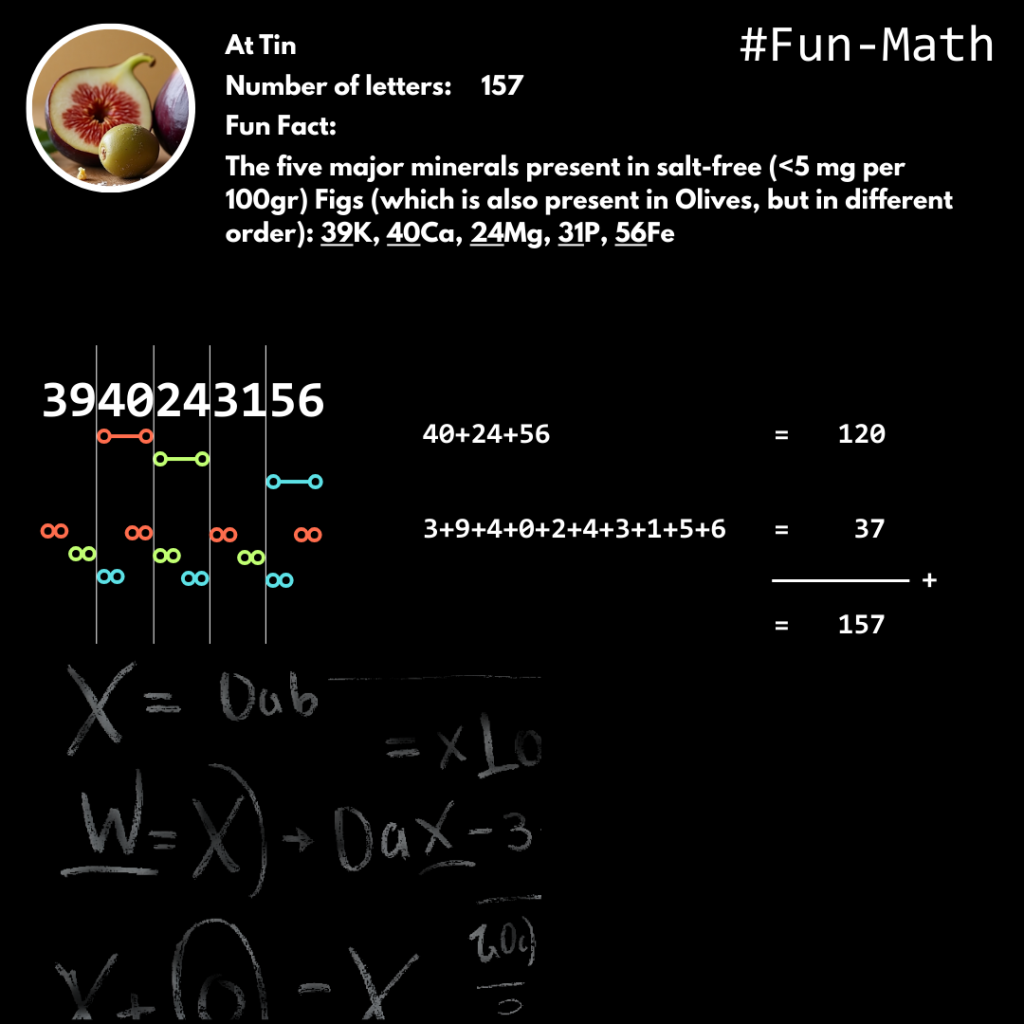
At Tin
Number of letters:
157
Fun Fact:
The five major minerals present in salt-free (<5 mg per 100gr) Figs (which is also present in Olives, but in different order): 39K, 40Ca, 24Mg, 31P, 56Fe
3940243156
40+24+56 + 3+9+4+0+2+4+3+1+5+6 = 157
#Fun-Math
Sinai Perspective
The fig is mentioned in Quran Chapter 95. In fact, Chapter 95 of the Quran is named “At Tin” (The Fig), with 8 Verses and 34 Words. Surah At-Tin mentions the Mount Sinai and the Secure City of Mecca in its second and third verse. The half-span of the angle formed by the bearings from western (-34.3545°) and eastern (-36.251°) boundaries of the Haram to Jabal Musa is 0.94825°≈0.95°. Jabal Musa, along with Jabal Serbal and several other mountains, are candidates for Mount Sinai
Fun Fact: The Fig (At Tin)

Buah tin disebutkan dalam Al-Qur’an Surah ke-95. Faktanya, Surah ke-95 dalam Al-Qur’an dinamakan “At-Tin” (Buah Tin), dengan 8 Ayat dan 34 Kata. Surah At-Tin menyebutkan gunung Sinai dan kota yang aman (Mekkah) pada ayat kedua dan ketiganya. Setengah rentang sudut yang dibentuk dari batas barat (-34.3545°) dan timur (-36.251°) Haram ke Jabal Musa adalah 0.94825°≈0.95°. Jabal Musa, bersama dengan Jabal Serbal dan beberapa gunung lainnya, adalah kandidat untuk Gunung Sinai.
Fun Fact: Buah Tin (At Tin)
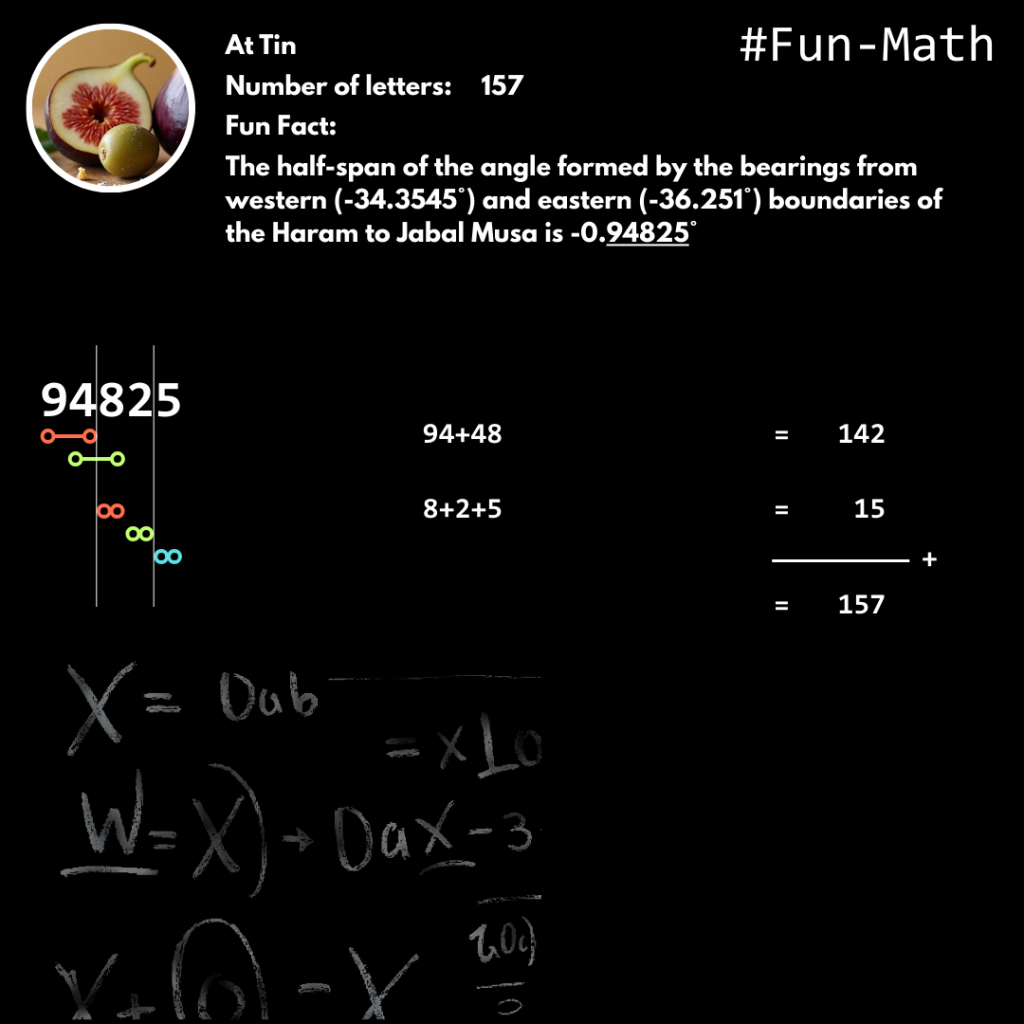
At Tin
Number of letters:
157
Fun Fact:
The half-span of the angle formed by the bearings from western (-34.3545°) and eastern (-36.251°) boundaries of the Haram to Jabal Musa is -0.94825°
94825
94+48 + 8+2+5 = 157
#Fun-Math
- The Fig
- Buah Tin
Fig Perspective
The fig is mentioned in Quran Chapter 95. In fact, Chapter 95 of the Quran is named “At Tin” (The Fig). Surah At-Tin mentions the fig and the olive in its first verse, referencing two objects in one verse. The five major minerals present in Figs (which is also present in Olives, but in different order): 39K, 40Ca, 24Mg, 31P, 56Fe. Total isotopes: 190. Half (one of two equal parts) of total isotopes: 95. Interestingly, 1st + 5th = 95 and 2nd + 3rd + 4th = 95.
Based on the available information for fresh Figs [archive] (per 100g), here’s an approximate order of minerals by weight of Fig, non-free [archive], from highest to lowest:
Potassium, K: 232 mg (Daily Value [archive]: 7.73%)
Calcium, Ca: 35 mg (Daily Value: 3.50%)
Magnesium, Mg: 17 mg (Daily Value: 4.25%)
Phosphorus, P: 14 mg (Daily Value: 2.00%)
Iron, Fe: 0.37 mg (Daily Value: 4.63%)
Zinc, Zn: 0.15 mg (Daily Value: 1.36%)
Manganese, Mn: 0.128 mg (Daily Value: 5.57%)
Copper, Cu: 0.07 mg (Daily Value: 7.78%)
Selenium, Se: 0.2 µg (Daily Value: 0.36%)
Sodium, Na: 1 mg (Daily Value: 0.07%, free (below 5 mg per 100 mg))
Following the same order as the Fig data, here’s an approximation of the available information for Olives (per 100g):
Potassium (K): Approximately 8-42 mg
Calcium (Ca): Approximately 50-88 mg
Magnesium (Mg): Approximately 4-11 mg
Phosporus (P): Approximately 3-4 mg
Iron (Fe): Approximately 0.5-3.3 mg
Zinc (Zn): Approximately 0.04-0.22 mg
Manganese (Mn): Approximately 0.02 mg
Copper (Cu): Approximately 0.12-0.25 mg
Selenium (Se): Approximately 0.9 mcg (micrograms)
Sodium (Na): Approximately 700 mg-1500 mg
When considering the five major minerals present in Figs, our main focus, the identified elements were potassium, calcium, magnesium, phosphorus, and iron. The sum of the mass numbers of their most abundant stable isotopes (39K, 40Ca, 24Mg, 31P, 56Fe) totals 190. Dividing this value by two (Fig and Olive) yields 95.
Bearing Perspective
The fig is mentioned in Quran Chapter 95. In fact, Chapter 95 of the Quran is named “At Tin” (The Fig), with 8 Verses and 34 Words. Surah At-Tin mentions the Mount Sinai and the Secure City of Mecca in its second and third verse. The half-span of the angle formed by the bearings from western (-34.3545°) and eastern (-36.251°) boundaries of the Haram to Jabal Musa is 0.94825°≈0.95°. Jabal Musa, along with Jabal Serbal and several other mountains, are candidates for Mount Sinai
By the fig and the olive, and Mount Sinai, and this secure city ˹of Mecca˺
At Tin 95:1-3
Long before a more established tradition focused solely on Jabal Musa, Mount Serbal, also located in the southern part of the Sinai Peninsula, commanded the attention of some early Christian communities [archive]. From approximately the 4th to the 6th centuries CE, certain Christian pilgrims and scholars considered Serbal to be the most likely candidate for Mount Sinai. Although it was eventually superseded by Jabal Musa in popularity, Serbal’s historical claim is notable as it represents one of the earliest focuses of devotion within the peninsula itself. Like much of the Sinai region, the environment around Mount Serbal is intensely dry and rocky.
As time progressed, tradition shifted and firmly took root at Jabal Musa, or Mount Moses, also situated in the southern Sinai Peninsula. This towering granite peak has become the most enduring and continuous candidate for Mount Sinai. Its prominence solidified remarkably from the early Christian era, particularly from the 4th century CE onwards, culminating in the construction of the iconic St. Catherine’s Monastery at its foot by the 6th century. The environment surrounding Jabal Musa is also a quintessential harsh and arid desert. Its landscape, marked by striking rock formations and sparse desert vegetation.
While Jewish textual tradition does not specifically point to a single geographical location for Mount Sinai, the event of the giving of the Torah is the single most central moment in Jewish history.
The presence of fig (Ficus carica) and olive (Olea europaea) trees in the vicinity of Jabal Serbal and Jabal Musa has been noted by researchers studying the ecology of the southern Sinai Peninsula. Both species grow in these regions without evidence of historical cultivation, suggesting they are native to certain microclimates in the mountain valleys.
Exact Bearing (Direction) [archive]
- Calculations use rounding to 4 decimal places (Oath by Fig, Olive, Sinai, Mecca)
- The result is rounded to 2 decimal places (Direction to Sinai from Mecca)
Haram to Jabal Musa
++++++++++++++++++++++++++++++++++++
Haram Border [Near Main Gate (W)]: 7GHX9J2P+W4V 21.352362499999998, 39.635296874999995 (0.3726690287043677 rad, 0.6917664304741693 rad )
Jabal Musa: 7GWMGXQG+C3 28.538562499999998, 33.975187500000004 (0.4980918794111842 rad, 0.592978885857421 rad )
++++++++++++++++++++++++++++++++++++
x = math.sin(-0.0988) * math.cos(0.4981)
x = -0.0986 * 0.8785
x = -0.0866
y = math.cos(0.3727) * math.sin(0.4981) – math.sin(0.3727) * math.cos(0.4981) * math.cos(-0.0988)
y = 0.9313 * 0.4778 – 0.3641 * 0.8785 * 0.9951
y = 0.1267
Initial Bearing:
math.atan2(-0.0866, 0.1267) = -0.5996 rad = -34.3545 degrees
Normalized Bearing:
325.6455 degrees
++++++++++++++++++++++++++++++++++++
Haram Border [Main Gate (W)]: 7GHX9M68+WP 21.3623125, 39.6668125 (0.3728426889649412 rad, 0.6923164818962432 rad )
Jabal Musa: 7GWMGXQG+C3 28.538562499999998, 33.975187500000004 (0.4980918794111842 rad, 0.592978885857421 rad )
++++++++++++++++++++++++++++++++++++
x = math.sin(-0.0993) * math.cos(0.4981)
x = -0.0991 * 0.8785
x = -0.0871
y = math.cos(0.3728) * math.sin(0.4981) – math.sin(0.3728) * math.cos(0.4981) * math.cos(-0.0993)
y = 0.9313 * 0.4778 – 0.3642 * 0.8785 * 0.9951
y = 0.1266
Initial Bearing:
math.atan2(-0.0871, 0.1266) = -0.6026 rad = -34.5264 degrees
Normalized Bearing:
325.4736 degrees
++++++++++++++++++++++++++++++++++++
Haram Border [Al Hudaibiyah (NW)]: 7GHXCJJW+7W 21.430687499999998, 39.6473125 (0.37403605784099225 rad, 0.6919761426921043 rad )
Jabal Musa: 7GWMGXQG+C3 28.538562499999998, 33.975187500000004 (0.4980918794111842 rad, 0.592978885857421 rad )
++++++++++++++++++++++++++++++++++++
x = math.sin(-0.099) * math.cos(0.4981)
x = -0.0988 * 0.8785
x = -0.0868
y = math.cos(0.374) * math.sin(0.4981) – math.sin(0.374) * math.cos(0.4981) * math.cos(-0.099)
y = 0.9309 * 0.4778 – 0.3653 * 0.8785 * 0.9951
y = 0.1254
Initial Bearing:
math.atan2(-0.0868, 0.1254) = -0.6055 rad = -34.6926 degrees
Normalized Bearing:
325.3074 degrees
++++++++++++++++++++++++++++++++++++
Haram Border [Near Masjid Aisha ‘Umm al-Mumineen’ (Masjid Al-Taneem) (N)]: 7GHXFR82+JC 21.466562500000002, 39.8010625 (0.3746621947101453 rad, 0.6946595864170456 rad )
Jabal Musa: 7GWMGXQG+C3 28.538562499999998, 33.975187500000004 (0.4980918794111842 rad, 0.592978885857421 rad )
++++++++++++++++++++++++++++++++++++
x = math.sin(-0.1017) * math.cos(0.4981)
x = -0.1015 * 0.8785
x = -0.0892
y = math.cos(0.3747) * math.sin(0.4981) – math.sin(0.3747) * math.cos(0.4981) * math.cos(-0.1017)
y = 0.9306 * 0.4778 – 0.366 * 0.8785 * 0.9948
y = 0.1248
Initial Bearing:
math.atan2(-0.0892, 0.1248) = -0.6206 rad = -35.5578 degrees
Normalized Bearing:
324.4422 degrees
++++++++++++++++++++++++++++++++++++
Kaaba: 7GHXCRFG+2F 21.422562499999998, 39.82618749999999 (0.3738942498392677 rad, 0.695098100391609 rad )
Jabal Musa: 7GWMGXQG+C3 28.538562499999998, 33.975187500000004 (0.4980918794111842 rad, 0.592978885857421 rad )
++++++++++++++++++++++++++++++++++++
x = math.sin(-0.1021) * math.cos(0.4981)
x = -0.1019 * 0.8785
x = -0.0895
y = math.cos(0.3739) * math.sin(0.4981) – math.sin(0.3739) * math.cos(0.4981) * math.cos(-0.1021)
y = 0.9309 * 0.4778 – 0.3652 * 0.8785 * 0.9948
y = 0.1256
Initial Bearing:
math.atan2(-0.0895, 0.1256) = -0.6191 rad = -35.4718 degrees
Normalized Bearing:
324.5282 degrees
++++++++++++++++++++++++++++++++++++
Haram Border [Al Ju’ranah (E}’]: 7GHXGWJQ+FHP 21.5312125, 39.938953125 (0.37579055007155954 rad, 0.6970662318309284 rad )
Jabal Musa: 7GWMGXQG+C3 28.538562499999998, 33.975187500000004 (0.4980918794111842 rad, 0.592978885857421 rad )
++++++++++++++++++++++++++++++++++++
x = math.sin(-0.1041) * math.cos(0.4981)
x = -0.1039 * 0.8785
x = -0.0913
y = math.cos(0.3758) * math.sin(0.4981) – math.sin(0.3758) * math.cos(0.4981) * math.cos(-0.1041)
y = 0.9302 * 0.4778 – 0.367 * 0.8785 * 0.9946
y = 0.1238
Initial Bearing:
math.atan2(-0.0913, 0.1238) = -0.6354 rad = -36.4057 degrees
Normalized Bearing:
323.5943 degrees
++++++++++++++++++++++++++++++++++++
Haram Border [Rashidiya (E)]: 7GHXFWPR+4JW 21.4853625, 39.94157812500001 (0.3749903166095202 rad, 0.6971120467237933 rad )
Jabal Musa: 7GWMGXQG+C3 28.538562499999998, 33.975187500000004 (0.4980918794111842 rad, 0.592978885857421 rad )
++++++++++++++++++++++++++++++++++++
x = math.sin(-0.1041) * math.cos(0.4981)
x = -0.1039 * 0.8785
x = -0.0913
y = math.cos(0.375) * math.sin(0.4981) – math.sin(0.375) * math.cos(0.4981) * math.cos(-0.1041)
y = 0.9305 * 0.4778 – 0.3663 * 0.8785 * 0.9946
y = 0.1245
Initial Bearing:
math.atan2(-0.0913, 0.1245) = -0.6327 rad = -36.251 degrees
Normalized Bearing:
323.749 degrees
++++++++++++++++++++++++++++++++++++
Miqot [Masjid Hudaibiyah NW]: 7GHXCJRG+Q7X 21.4419875, 39.62573437499999 (0.37423328004646766 rad, 0.6915995333644473 rad )
Jabal Musa: 7GWMGXQG+C3 28.538562499999998, 33.975187500000004 (0.4980918794111842 rad, 0.592978885857421 rad )
++++++++++++++++++++++++++++++++++++
x = math.sin(-0.0986) * math.cos(0.4981)
x = -0.0984 * 0.8785
x = -0.0864
y = math.cos(0.3742) * math.sin(0.4981) – math.sin(0.3742) * math.cos(0.4981) * math.cos(-0.0986)
y = 0.9308 * 0.4778 – 0.3655 * 0.8785 * 0.9951
y = 0.1252
Initial Bearing:
math.atan2(-0.0864, 0.1252) = -0.604 rad = -34.6067 degrees
Normalized Bearing:
325.3933 degrees
++++++++++++++++++++++++++++++++++++
Miqot [Masjid Ji’ronah (NE)]: 7GHXHX92+8F 21.568312499999998, 39.95118749999999 (0.37643806722404943 rad, 0.6972797619566019 rad )
Jabal Musa: 7GWMGXQG+C3 28.538562499999998, 33.975187500000004 (0.4980918794111842 rad, 0.592978885857421 rad )
++++++++++++++++++++++++++++++++++++
x = math.sin(-0.1043) * math.cos(0.4981)
x = -0.1041 * 0.8785
x = -0.0915
y = math.cos(0.3764) * math.sin(0.4981) – math.sin(0.3764) * math.cos(0.4981) * math.cos(-0.1043)
y = 0.93 * 0.4778 – 0.3676 * 0.8785 * 0.9946
y = 0.1232
Initial Bearing:
math.atan2(-0.0915, 0.1232) = -0.6388 rad = -36.6005 degrees
Normalized Bearing:
323.3995 degrees
The half-span of the angle formed by the bearings from western (Miqot [Masjid Hudaibiyah NW]) and eastern (Miqot [Masjid Ji’ronah (NE)]) boundaries of the Haram to Jabal Musa=(-34.6067 – -36.6005)/2=0.9969
The half-span of the angle formed by the bearings from extreme western (Haram Border [Near Main Gate (W)]) and eastern (Haram Border [Rashidiya (E)]) boundaries of the Haram to Jabal Musa
=(-34.3545 – -36.251)/2
=0.94825
≈0.95
Haram to Jabal Serbal
++++++++++++++++++++++++++++++++++++
Haram Border [Near Main Gate (W)]: 7GHX9J2P+W4V 21.352362499999998, 39.635296874999995 (0.3726690287043677 rad, 0.6917664304741693 rad )
Jabal Serbal: 7GWMJMW2+HM 28.646437499999998, 33.6516875 (0.4999746533417731 rad, 0.5873327457272193 rad )
++++++++++++++++++++++++++++++++++++
x = math.sin(-0.1045) * math.cos(0.5)
x = -0.1043 * 0.8776
x = -0.0915
y = math.cos(0.3727) * math.sin(0.5) – math.sin(0.3727) * math.cos(0.5) * math.cos(-0.1045)
y = 0.9313 * 0.4794 – 0.3641 * 0.8776 * 0.9945
y = 0.1287
Initial Bearing:
math.atan2(-0.0915, 0.1287) = -0.618 rad = -35.4088 degrees
Normalized Bearing:
324.5912 degrees
++++++++++++++++++++++++++++++++++++
Haram Border [Main Gate (W)]: 7GHX9M68+WP 21.3623125, 39.6668125 (0.3728426889649412 rad, 0.6923164818962432 rad )
Jabal Serbal: 7GWMJMW2+HM 28.646437499999998, 33.6516875 (0.4999746533417731 rad, 0.5873327457272193 rad )
++++++++++++++++++++++++++++++++++++
x = math.sin(-0.105) * math.cos(0.5)
x = -0.1048 * 0.8776
x = -0.092
y = math.cos(0.3728) * math.sin(0.5) – math.sin(0.3728) * math.cos(0.5) * math.cos(-0.105)
y = 0.9313 * 0.4794 – 0.3642 * 0.8776 * 0.9945
y = 0.1286
Initial Bearing:
math.atan2(-0.092, 0.1286) = -0.621 rad = -35.5807 degrees
Normalized Bearing:
324.4193 degrees
++++++++++++++++++++++++++++++++++++
Haram Border [Al Hudaibiyah (NW)]: 7GHXCJJW+7W 21.430687499999998, 39.6473125 (0.37403605784099225 rad, 0.6919761426921043 rad )
Jabal Serbal: 7GWMJMW2+HM 28.646437499999998, 33.6516875 (0.4999746533417731 rad, 0.5873327457272193 rad )
++++++++++++++++++++++++++++++++++++
x = math.sin(-0.1047) * math.cos(0.5)
x = -0.1045 * 0.8776
x = -0.0917
y = math.cos(0.374) * math.sin(0.5) – math.sin(0.374) * math.cos(0.5) * math.cos(-0.1047)
y = 0.9309 * 0.4794 – 0.3653 * 0.8776 * 0.9945
y = 0.1274
Initial Bearing:
math.atan2(-0.0917, 0.1274) = -0.6239 rad = -35.7468 degrees
Normalized Bearing:
324.2532 degrees
++++++++++++++++++++++++++++++++++++
Haram Border [Near Masjid Aisha ‘Umm al-Mumineen’ (Masjid Al-Taneem) (N)]: 7GHXFR82+JC 21.466562500000002, 39.8010625 (0.3746621947101453 rad, 0.6946595864170456 rad )
Jabal Serbal: 7GWMJMW2+HM 28.646437499999998, 33.6516875 (0.4999746533417731 rad, 0.5873327457272193 rad )
++++++++++++++++++++++++++++++++++++
x = math.sin(-0.1074) * math.cos(0.5)
x = -0.1072 * 0.8776
x = -0.0941
y = math.cos(0.3747) * math.sin(0.5) – math.sin(0.3747) * math.cos(0.5) * math.cos(-0.1074)
y = 0.9306 * 0.4794 – 0.366 * 0.8776 * 0.9942
y = 0.1268
Initial Bearing:
math.atan2(-0.0941, 0.1268) = -0.6384 rad = -36.5776 degrees
Normalized Bearing:
323.4224 degrees
++++++++++++++++++++++++++++++++++++
Kaaba: 7GHXCRFG+2F 21.422562499999998, 39.82618749999999 (0.3738942498392677 rad, 0.695098100391609 rad )
Jabal Serbal: 7GWMJMW2+HM 28.646437499999998, 33.6516875 (0.4999746533417731 rad, 0.5873327457272193 rad )
++++++++++++++++++++++++++++++++++++
x = math.sin(-0.1078) * math.cos(0.5)
x = -0.1076 * 0.8776
x = -0.0944
y = math.cos(0.3739) * math.sin(0.5) – math.sin(0.3739) * math.cos(0.5) * math.cos(-0.1078)
y = 0.9309 * 0.4794 – 0.3652 * 0.8776 * 0.9942
y = 0.1276
Initial Bearing:
math.atan2(-0.0944, 0.1276) = -0.6369 rad = -36.4917 degrees
Normalized Bearing:
323.5083 degrees
++++++++++++++++++++++++++++++++++++
Haram Border [Al Ju’ranah (E}’]: 7GHXGWJQ+FHP 21.5312125, 39.938953125 (0.37579055007155954 rad, 0.6970662318309284 rad )
Jabal Serbal: 7GWMJMW2+HM 28.646437499999998, 33.6516875 (0.4999746533417731 rad, 0.5873327457272193 rad )
++++++++++++++++++++++++++++++++++++
x = math.sin(-0.1098) * math.cos(0.5)
x = -0.1096 * 0.8776
x = -0.0962
y = math.cos(0.3758) * math.sin(0.5) – math.sin(0.3758) * math.cos(0.5) * math.cos(-0.1098)
y = 0.9302 * 0.4794 – 0.367 * 0.8776 * 0.994
y = 0.1258
Initial Bearing:
math.atan2(-0.0962, 0.1258) = -0.6528 rad = -37.4027 degrees
Normalized Bearing:
322.5973 degrees
++++++++++++++++++++++++++++++++++++
Haram Border [Rashidiya (E)]: 7GHXFWPR+4JW 21.4853625, 39.94157812500001 (0.3749903166095202 rad, 0.6971120467237933 rad )
Jabal Serbal: 7GWMJMW2+HM 28.646437499999998, 33.6516875 (0.4999746533417731 rad, 0.5873327457272193 rad )
++++++++++++++++++++++++++++++++++++
x = math.sin(-0.1098) * math.cos(0.5)
x = -0.1096 * 0.8776
x = -0.0962
y = math.cos(0.375) * math.sin(0.5) – math.sin(0.375) * math.cos(0.5) * math.cos(-0.1098)
y = 0.9305 * 0.4794 – 0.3663 * 0.8776 * 0.994
y = 0.1265
Initial Bearing:
math.atan2(-0.0962, 0.1265) = -0.6502 rad = -37.2537 degrees
Normalized Bearing:
322.7463 degrees
++++++++++++++++++++++++++++++++++++
Miqot [Masjid Hudaibiyah NW]: 7GHXCJRG+Q7X 21.4419875, 39.62573437499999 (0.37423328004646766 rad, 0.6915995333644473 rad )
Jabal Serbal: 7GWMJMW2+HM 28.646437499999998, 33.6516875 (0.4999746533417731 rad, 0.5873327457272193 rad )
++++++++++++++++++++++++++++++++++++
x = math.sin(-0.1043) * math.cos(0.5)
x = -0.1041 * 0.8776
x = -0.0914
y = math.cos(0.3742) * math.sin(0.5) – math.sin(0.3742) * math.cos(0.5) * math.cos(-0.1043)
y = 0.9308 * 0.4794 – 0.3655 * 0.8776 * 0.9946
y = 0.1272
Initial Bearing:
math.atan2(-0.0914, 0.1272) = -0.6231 rad = -35.701 degrees
Normalized Bearing:
324.299 degrees
++++++++++++++++++++++++++++++++++++
Miqot [Masjid Ji’ronah (NE)]: 7GHXHX92+8F 21.568312499999998, 39.95118749999999 (0.37643806722404943 rad, 0.6972797619566019 rad )
Jabal Serbal: 7GWMJMW2+HM 28.646437499999998, 33.6516875 (0.4999746533417731 rad, 0.5873327457272193 rad )
++++++++++++++++++++++++++++++++++++
x = math.sin(-0.11) * math.cos(0.5)
x = -0.1098 * 0.8776
x = -0.0964
y = math.cos(0.3764) * math.sin(0.5) – math.sin(0.3764) * math.cos(0.5) * math.cos(-0.11)
y = 0.93 * 0.4794 – 0.3676 * 0.8776 * 0.994
y = 0.1252
Initial Bearing:
math.atan2(-0.0964, 0.1252) = -0.6562 rad = -37.5975 degrees
Normalized Bearing:
322.4025 degrees
The half-span of the angle formed by the bearings from western (Miqot [Masjid Hudaibiyah NW]) and eastern (Miqot [Masjid Ji’ronah (NE)]) boundaries of the Haram to Jabal Serbal
=(-35.701 – -37.5975)/2
=0.94825
≈0.95
The half-span of the angle formed by the bearings from western (Haram Border [Near Main Gate (W)]) and eastern (Haram Border [Rashidiya (E)]) boundaries of the Haram to Jabal Serbal=(-35.4088 – -37.2537)/2=0.92245
In-depth information retrieval using AI, website, and Google Maps. Recalculate with python.
Perspektif Buah Tin
Buah tin disebutkan dalam Al-Qur’an Surah ke-95. Faktanya, Surah ke-95 dalam Al-Qur’an dinamakan “At-Tin” (Buah Tin). Surah At-Tin menyebutkan buah tin dan zaitun pada ayat pertamanya, merujuk pada dua objek dalam satu ayat. Lima mineral utama yang terdapat dalam buah tin (yang juga ada dalam buah zaitun, tetapi dengan urutan yang berbeda) adalah: 39K, 40Ca, 24Mg, 31P, 56Fe. Total isotopnya adalah 190. Setengah (salah satu dari dua bagian yang sama) dari total isotop tersebut adalah 95. Menariknya, ke-1 + ke-5 = 95 dan ke-2 + ke-3 + ke-4 = 95.
Berdasarkan informasi yang tersedia untuk buah tin segar [archive] (per 100g), berikut adalah perkiraan urutan mineral berdasarkan beratnya, tidak bebas [archive], dari tertinggi hingga terendah:
Kalium, K: 232 mg (Nilai Harian [archive]: 7,73%)
Kalsium, Ca: 35 mg (Nilai Harian: 3,50%)
Magnesium, Mg: 17 mg (Nilai Harian: 4,25%)
Fosfor, P: 14 mg (Nilai Harian: 2,00%)
Zat Besi, Fe: 0,37 mg (Nilai Harian: 4,63%)
Seng, Zn: 0,15 mg (Nilai Harian: 1,36%)
Mangan, Mn: 0,128 mg (Nilai Harian: 5,57%)
Tembaga, Cu: 0,07 mg (Nilai Harian: 7,78%)
Selenium, Se: 0,2 µg (Nilai Harian: 0,36%)
Natrium, Na: 1 mg (Nilai Harian: 0,07%, bebas (dibawah 5 mg per 100 mg))
Mengikuti urutan yang sama dengan data buah tin, berikut adalah perkiraan informasi yang tersedia untuk buah zaitun (per 100g):
Kalium (K): Sekitar 8-42 mg
Kalsium (Ca): Sekitar 50-88 mg
Magnesium (Mg): Sekitar 4-11 mg
Fosfor (P): Sekitar 3-4 mg
Zat Besi (Fe): Sekitar 0.5-3.3 mg
Seng (Zn): Sekitar 0.04-0.22 mg
Mangan (Mn): Sekitar 0.02 mg
Tembaga (Cu): Sekitar 0.12-0.25 mg
Selenium (Se): Sekitar 0.9 mcg (mikrogram)
Natrium (Na): Sekitar 700-1500 mg
Ketika mempertimbangkan lima mineral utama yang terdapat dalam buah tin, elemen-elemen yang teridentifikasi adalah kalium, kalsium, magnesium, fosfor, dan zat besi. Jumlah nomor massa isotop stabilnya yang paling melimpah (39K, 40Ca, 24Mg, 31P, 56Fe) berjumlah 190. Membagi nilai ini dengan dua (merujuk pada buah tin dan zaitun) menghasilkan 95.
Perspektif Arah
Buah tin disebutkan dalam Al-Qur’an Surah ke-95. Faktanya, Surah ke-95 dalam Al-Qur’an dinamakan “At-Tin” (Buah Tin), dengan 8 Ayat dan 34 Kata. Surah At-Tin menyebutkan gunung Sinai dan kota yang aman (Mekkah) pada ayat kedua dan ketiganya. Setengah rentang sudut yang dibentuk dari batas barat (-34.3545°) dan timur (-36.251°) Haram ke Jabal Musa adalah 0.94825°≈0.95°. Jabal Musa, bersama dengan Jabal Serbal dan beberapa gunung lainnya, adalah kandidat untuk Gunung Sinai.
Demi (buah) tin dan (buah) zaitun, dan demi bukit Ṭūrsīnā`, dan demi kota (Mekah) ini yang aman
At Tin 95:1-3
Jauh sebelum tradisi yang lebih mapan hanya berfokus pada Jabal Musa, Gunung Serbal, yang juga terletak di bagian selatan Semenanjung Sinai, menarik perhatian beberapa komunitas Kristen [archive] awal. Dari sekitar abad ke-4 hingga ke-6 Masehi, peziarah dan cendekiawan Kristen tertentu menganggap Serbal sebagai kandidat yang paling mungkin untuk Gunung Sinai. Meskipun pada akhirnya popularitasnya digantikan oleh Jabal Musa, klaim historis Serbal patut dicatat karena mewakili salah satu fokus devosi paling awal di semenanjung itu sendiri. Seperti sebagian besar wilayah Sinai, lingkungan di sekitar Gunung Serbal sangat kering dan berbatu.
Seiring berjalannya waktu, tradisi bergeser dan mengakar kuat di Jabal Musa, atau Gunung Musa, yang juga terletak di Semenanjung Sinai bagian selatan. Puncak granit yang menjulang tinggi ini telah menjadi kandidat Gunung Sinai yang paling abadi dan berkelanjutan. Keunggulannya semakin kokoh secara signifikan sejak era Kristen awal, khususnya dari abad ke-4 Masehi dan seterusnya, mencapai puncaknya dengan pembangunan Biara Santa Katarina yang ikonis di kakinya pada abad ke-6 Masehi. Lingkungan di sekitar Jabal Musa juga merupakan gurun yang keras dan gersang. Lanskapnya ditandai oleh formasi batuan yang mencolok dan vegetasi gurun yang jarang.
Meskipun tradisi tekstual Yahudi tidak secara spesifik menunjuk lokasi geografis untuk Gunung Sinai, peristiwa pemberian Taurat adalah momen paling sentral dalam sejarah Yahudi.
Kehadiran pohon tin (Ficus carica) dan zaitun (Olea europaea) di sekitar Jabal Serbal dan Jabal Musa telah dicatat oleh para peneliti yang mempelajari ekologi Semenanjung Sinai bagian selatan. Kedua spesies ini tumbuh di wilayah-wilayah tersebut tanpa bukti budidaya historis, menunjukkan bahwa mereka adalah tumbuhan asli di mikroklima tertentu di lembah-lembah pegunungan.
- Perhitungan menggunakan pembulatan 4 digit di belakang koma (Sumpah dengan Tin, Zaitun, Sinai, Mekah)
- Hasil dibulatkan 2 digit di belakang koma (Arah ke Sinai dari Mekah)
Haram ke Jabal Musa
++++++++++++++++++++++++++++++++++++
Haram Border [Near Main Gate (W)]: 7GHX9J2P+W4V 21.352362499999998, 39.635296874999995 (0.3726690287043677 rad, 0.6917664304741693 rad )
Jabal Musa: 7GWMGXQG+C3 28.538562499999998, 33.975187500000004 (0.4980918794111842 rad, 0.592978885857421 rad )
++++++++++++++++++++++++++++++++++++
x = math.sin(-0.0988) * math.cos(0.4981)
x = -0.0986 * 0.8785
x = -0.0866
y = math.cos(0.3727) * math.sin(0.4981) – math.sin(0.3727) * math.cos(0.4981) * math.cos(-0.0988)
y = 0.9313 * 0.4778 – 0.3641 * 0.8785 * 0.9951
y = 0.1267
Initial Bearing:
math.atan2(-0.0866, 0.1267) = -0.5996 rad = -34.3545 degrees
Normalized Bearing:
325.6455 degrees
++++++++++++++++++++++++++++++++++++
Haram Border [Main Gate (W)]: 7GHX9M68+WP 21.3623125, 39.6668125 (0.3728426889649412 rad, 0.6923164818962432 rad )
Jabal Musa: 7GWMGXQG+C3 28.538562499999998, 33.975187500000004 (0.4980918794111842 rad, 0.592978885857421 rad )
++++++++++++++++++++++++++++++++++++
x = math.sin(-0.0993) * math.cos(0.4981)
x = -0.0991 * 0.8785
x = -0.0871
y = math.cos(0.3728) * math.sin(0.4981) – math.sin(0.3728) * math.cos(0.4981) * math.cos(-0.0993)
y = 0.9313 * 0.4778 – 0.3642 * 0.8785 * 0.9951
y = 0.1266
Initial Bearing:
math.atan2(-0.0871, 0.1266) = -0.6026 rad = -34.5264 degrees
Normalized Bearing:
325.4736 degrees
++++++++++++++++++++++++++++++++++++
Haram Border [Al Hudaibiyah (NW)]: 7GHXCJJW+7W 21.430687499999998, 39.6473125 (0.37403605784099225 rad, 0.6919761426921043 rad )
Jabal Musa: 7GWMGXQG+C3 28.538562499999998, 33.975187500000004 (0.4980918794111842 rad, 0.592978885857421 rad )
++++++++++++++++++++++++++++++++++++
x = math.sin(-0.099) * math.cos(0.4981)
x = -0.0988 * 0.8785
x = -0.0868
y = math.cos(0.374) * math.sin(0.4981) – math.sin(0.374) * math.cos(0.4981) * math.cos(-0.099)
y = 0.9309 * 0.4778 – 0.3653 * 0.8785 * 0.9951
y = 0.1254
Initial Bearing:
math.atan2(-0.0868, 0.1254) = -0.6055 rad = -34.6926 degrees
Normalized Bearing:
325.3074 degrees
++++++++++++++++++++++++++++++++++++
Haram Border [Near Masjid Aisha ‘Umm al-Mumineen’ (Masjid Al-Taneem) (N)]: 7GHXFR82+JC 21.466562500000002, 39.8010625 (0.3746621947101453 rad, 0.6946595864170456 rad )
Jabal Musa: 7GWMGXQG+C3 28.538562499999998, 33.975187500000004 (0.4980918794111842 rad, 0.592978885857421 rad )
++++++++++++++++++++++++++++++++++++
x = math.sin(-0.1017) * math.cos(0.4981)
x = -0.1015 * 0.8785
x = -0.0892
y = math.cos(0.3747) * math.sin(0.4981) – math.sin(0.3747) * math.cos(0.4981) * math.cos(-0.1017)
y = 0.9306 * 0.4778 – 0.366 * 0.8785 * 0.9948
y = 0.1248
Initial Bearing:
math.atan2(-0.0892, 0.1248) = -0.6206 rad = -35.5578 degrees
Normalized Bearing:
324.4422 degrees
++++++++++++++++++++++++++++++++++++
Kaaba: 7GHXCRFG+2F 21.422562499999998, 39.82618749999999 (0.3738942498392677 rad, 0.695098100391609 rad )
Jabal Musa: 7GWMGXQG+C3 28.538562499999998, 33.975187500000004 (0.4980918794111842 rad, 0.592978885857421 rad )
++++++++++++++++++++++++++++++++++++
x = math.sin(-0.1021) * math.cos(0.4981)
x = -0.1019 * 0.8785
x = -0.0895
y = math.cos(0.3739) * math.sin(0.4981) – math.sin(0.3739) * math.cos(0.4981) * math.cos(-0.1021)
y = 0.9309 * 0.4778 – 0.3652 * 0.8785 * 0.9948
y = 0.1256
Initial Bearing:
math.atan2(-0.0895, 0.1256) = -0.6191 rad = -35.4718 degrees
Normalized Bearing:
324.5282 degrees
++++++++++++++++++++++++++++++++++++
Haram Border [Al Ju’ranah (E}’]: 7GHXGWJQ+FHP 21.5312125, 39.938953125 (0.37579055007155954 rad, 0.6970662318309284 rad )
Jabal Musa: 7GWMGXQG+C3 28.538562499999998, 33.975187500000004 (0.4980918794111842 rad, 0.592978885857421 rad )
++++++++++++++++++++++++++++++++++++
x = math.sin(-0.1041) * math.cos(0.4981)
x = -0.1039 * 0.8785
x = -0.0913
y = math.cos(0.3758) * math.sin(0.4981) – math.sin(0.3758) * math.cos(0.4981) * math.cos(-0.1041)
y = 0.9302 * 0.4778 – 0.367 * 0.8785 * 0.9946
y = 0.1238
Initial Bearing:
math.atan2(-0.0913, 0.1238) = -0.6354 rad = -36.4057 degrees
Normalized Bearing:
323.5943 degrees
++++++++++++++++++++++++++++++++++++
Haram Border [Rashidiya (E)]: 7GHXFWPR+4JW 21.4853625, 39.94157812500001 (0.3749903166095202 rad, 0.6971120467237933 rad )
Jabal Musa: 7GWMGXQG+C3 28.538562499999998, 33.975187500000004 (0.4980918794111842 rad, 0.592978885857421 rad )
++++++++++++++++++++++++++++++++++++
x = math.sin(-0.1041) * math.cos(0.4981)
x = -0.1039 * 0.8785
x = -0.0913
y = math.cos(0.375) * math.sin(0.4981) – math.sin(0.375) * math.cos(0.4981) * math.cos(-0.1041)
y = 0.9305 * 0.4778 – 0.3663 * 0.8785 * 0.9946
y = 0.1245
Initial Bearing:
math.atan2(-0.0913, 0.1245) = -0.6327 rad = -36.251 degrees
Normalized Bearing:
323.749 degrees
++++++++++++++++++++++++++++++++++++
Miqot [Masjid Hudaibiyah NW]: 7GHXCJRG+Q7X 21.4419875, 39.62573437499999 (0.37423328004646766 rad, 0.6915995333644473 rad )
Jabal Musa: 7GWMGXQG+C3 28.538562499999998, 33.975187500000004 (0.4980918794111842 rad, 0.592978885857421 rad )
++++++++++++++++++++++++++++++++++++
x = math.sin(-0.0986) * math.cos(0.4981)
x = -0.0984 * 0.8785
x = -0.0864
y = math.cos(0.3742) * math.sin(0.4981) – math.sin(0.3742) * math.cos(0.4981) * math.cos(-0.0986)
y = 0.9308 * 0.4778 – 0.3655 * 0.8785 * 0.9951
y = 0.1252
Initial Bearing:
math.atan2(-0.0864, 0.1252) = -0.604 rad = -34.6067 degrees
Normalized Bearing:
325.3933 degrees
++++++++++++++++++++++++++++++++++++
Miqot [Masjid Ji’ronah (NE)]: 7GHXHX92+8F 21.568312499999998, 39.95118749999999 (0.37643806722404943 rad, 0.6972797619566019 rad )
Jabal Musa: 7GWMGXQG+C3 28.538562499999998, 33.975187500000004 (0.4980918794111842 rad, 0.592978885857421 rad )
++++++++++++++++++++++++++++++++++++
x = math.sin(-0.1043) * math.cos(0.4981)
x = -0.1041 * 0.8785
x = -0.0915
y = math.cos(0.3764) * math.sin(0.4981) – math.sin(0.3764) * math.cos(0.4981) * math.cos(-0.1043)
y = 0.93 * 0.4778 – 0.3676 * 0.8785 * 0.9946
y = 0.1232
Initial Bearing:
math.atan2(-0.0915, 0.1232) = -0.6388 rad = -36.6005 degrees
Normalized Bearing:
323.3995 degrees
The half-span of the angle formed by the bearings from western (Miqot [Masjid Hudaibiyah NW]) and eastern (Miqot [Masjid Ji’ronah (NE)]) boundaries of the Haram to Jabal Musa=(-34.6067 – -36.6005)/2=0.9969
Setengah rentang sudut yang dibentuk dari batas barat (Haram Border [Near Main Gate (W)]) dan timur (Haram Border [Rashidiya (E)]) Haram ke Jabal Musa
=(-34.3545 – -36.251)/2
=0.94825
≈0.95
Haram ke Jabal Serbal
++++++++++++++++++++++++++++++++++++
Haram Border [Near Main Gate (W)]: 7GHX9J2P+W4V 21.352362499999998, 39.635296874999995 (0.3726690287043677 rad, 0.6917664304741693 rad )
Jabal Serbal: 7GWMJMW2+HM 28.646437499999998, 33.6516875 (0.4999746533417731 rad, 0.5873327457272193 rad )
++++++++++++++++++++++++++++++++++++
x = math.sin(-0.1045) * math.cos(0.5)
x = -0.1043 * 0.8776
x = -0.0915
y = math.cos(0.3727) * math.sin(0.5) – math.sin(0.3727) * math.cos(0.5) * math.cos(-0.1045)
y = 0.9313 * 0.4794 – 0.3641 * 0.8776 * 0.9945
y = 0.1287
Initial Bearing:
math.atan2(-0.0915, 0.1287) = -0.618 rad = -35.4088 degrees
Normalized Bearing:
324.5912 degrees
++++++++++++++++++++++++++++++++++++
Haram Border [Main Gate (W)]: 7GHX9M68+WP 21.3623125, 39.6668125 (0.3728426889649412 rad, 0.6923164818962432 rad )
Jabal Serbal: 7GWMJMW2+HM 28.646437499999998, 33.6516875 (0.4999746533417731 rad, 0.5873327457272193 rad )
++++++++++++++++++++++++++++++++++++
x = math.sin(-0.105) * math.cos(0.5)
x = -0.1048 * 0.8776
x = -0.092
y = math.cos(0.3728) * math.sin(0.5) – math.sin(0.3728) * math.cos(0.5) * math.cos(-0.105)
y = 0.9313 * 0.4794 – 0.3642 * 0.8776 * 0.9945
y = 0.1286
Initial Bearing:
math.atan2(-0.092, 0.1286) = -0.621 rad = -35.5807 degrees
Normalized Bearing:
324.4193 degrees
++++++++++++++++++++++++++++++++++++
Haram Border [Al Hudaibiyah (NW)]: 7GHXCJJW+7W 21.430687499999998, 39.6473125 (0.37403605784099225 rad, 0.6919761426921043 rad )
Jabal Serbal: 7GWMJMW2+HM 28.646437499999998, 33.6516875 (0.4999746533417731 rad, 0.5873327457272193 rad )
++++++++++++++++++++++++++++++++++++
x = math.sin(-0.1047) * math.cos(0.5)
x = -0.1045 * 0.8776
x = -0.0917
y = math.cos(0.374) * math.sin(0.5) – math.sin(0.374) * math.cos(0.5) * math.cos(-0.1047)
y = 0.9309 * 0.4794 – 0.3653 * 0.8776 * 0.9945
y = 0.1274
Initial Bearing:
math.atan2(-0.0917, 0.1274) = -0.6239 rad = -35.7468 degrees
Normalized Bearing:
324.2532 degrees
++++++++++++++++++++++++++++++++++++
Haram Border [Near Masjid Aisha ‘Umm al-Mumineen’ (Masjid Al-Taneem) (N)]: 7GHXFR82+JC 21.466562500000002, 39.8010625 (0.3746621947101453 rad, 0.6946595864170456 rad )
Jabal Serbal: 7GWMJMW2+HM 28.646437499999998, 33.6516875 (0.4999746533417731 rad, 0.5873327457272193 rad )
++++++++++++++++++++++++++++++++++++
x = math.sin(-0.1074) * math.cos(0.5)
x = -0.1072 * 0.8776
x = -0.0941
y = math.cos(0.3747) * math.sin(0.5) – math.sin(0.3747) * math.cos(0.5) * math.cos(-0.1074)
y = 0.9306 * 0.4794 – 0.366 * 0.8776 * 0.9942
y = 0.1268
Initial Bearing:
math.atan2(-0.0941, 0.1268) = -0.6384 rad = -36.5776 degrees
Normalized Bearing:
323.4224 degrees
++++++++++++++++++++++++++++++++++++
Kaaba: 7GHXCRFG+2F 21.422562499999998, 39.82618749999999 (0.3738942498392677 rad, 0.695098100391609 rad )
Jabal Serbal: 7GWMJMW2+HM 28.646437499999998, 33.6516875 (0.4999746533417731 rad, 0.5873327457272193 rad )
++++++++++++++++++++++++++++++++++++
x = math.sin(-0.1078) * math.cos(0.5)
x = -0.1076 * 0.8776
x = -0.0944
y = math.cos(0.3739) * math.sin(0.5) – math.sin(0.3739) * math.cos(0.5) * math.cos(-0.1078)
y = 0.9309 * 0.4794 – 0.3652 * 0.8776 * 0.9942
y = 0.1276
Initial Bearing:
math.atan2(-0.0944, 0.1276) = -0.6369 rad = -36.4917 degrees
Normalized Bearing:
323.5083 degrees
++++++++++++++++++++++++++++++++++++
Haram Border [Al Ju’ranah (E}’]: 7GHXGWJQ+FHP 21.5312125, 39.938953125 (0.37579055007155954 rad, 0.6970662318309284 rad )
Jabal Serbal: 7GWMJMW2+HM 28.646437499999998, 33.6516875 (0.4999746533417731 rad, 0.5873327457272193 rad )
++++++++++++++++++++++++++++++++++++
x = math.sin(-0.1098) * math.cos(0.5)
x = -0.1096 * 0.8776
x = -0.0962
y = math.cos(0.3758) * math.sin(0.5) – math.sin(0.3758) * math.cos(0.5) * math.cos(-0.1098)
y = 0.9302 * 0.4794 – 0.367 * 0.8776 * 0.994
y = 0.1258
Initial Bearing:
math.atan2(-0.0962, 0.1258) = -0.6528 rad = -37.4027 degrees
Normalized Bearing:
322.5973 degrees
++++++++++++++++++++++++++++++++++++
Haram Border [Rashidiya (E)]: 7GHXFWPR+4JW 21.4853625, 39.94157812500001 (0.3749903166095202 rad, 0.6971120467237933 rad )
Jabal Serbal: 7GWMJMW2+HM 28.646437499999998, 33.6516875 (0.4999746533417731 rad, 0.5873327457272193 rad )
++++++++++++++++++++++++++++++++++++
x = math.sin(-0.1098) * math.cos(0.5)
x = -0.1096 * 0.8776
x = -0.0962
y = math.cos(0.375) * math.sin(0.5) – math.sin(0.375) * math.cos(0.5) * math.cos(-0.1098)
y = 0.9305 * 0.4794 – 0.3663 * 0.8776 * 0.994
y = 0.1265
Initial Bearing:
math.atan2(-0.0962, 0.1265) = -0.6502 rad = -37.2537 degrees
Normalized Bearing:
322.7463 degrees
++++++++++++++++++++++++++++++++++++
Miqot [Masjid Hudaibiyah NW]: 7GHXCJRG+Q7X 21.4419875, 39.62573437499999 (0.37423328004646766 rad, 0.6915995333644473 rad )
Jabal Serbal: 7GWMJMW2+HM 28.646437499999998, 33.6516875 (0.4999746533417731 rad, 0.5873327457272193 rad )
++++++++++++++++++++++++++++++++++++
x = math.sin(-0.1043) * math.cos(0.5)
x = -0.1041 * 0.8776
x = -0.0914
y = math.cos(0.3742) * math.sin(0.5) – math.sin(0.3742) * math.cos(0.5) * math.cos(-0.1043)
y = 0.9308 * 0.4794 – 0.3655 * 0.8776 * 0.9946
y = 0.1272
Initial Bearing:
math.atan2(-0.0914, 0.1272) = -0.6231 rad = -35.701 degrees
Normalized Bearing:
324.299 degrees
++++++++++++++++++++++++++++++++++++
Miqot [Masjid Ji’ronah (NE)]: 7GHXHX92+8F 21.568312499999998, 39.95118749999999 (0.37643806722404943 rad, 0.6972797619566019 rad )
Jabal Serbal: 7GWMJMW2+HM 28.646437499999998, 33.6516875 (0.4999746533417731 rad, 0.5873327457272193 rad )
++++++++++++++++++++++++++++++++++++
x = math.sin(-0.11) * math.cos(0.5)
x = -0.1098 * 0.8776
x = -0.0964
y = math.cos(0.3764) * math.sin(0.5) – math.sin(0.3764) * math.cos(0.5) * math.cos(-0.11)
y = 0.93 * 0.4794 – 0.3676 * 0.8776 * 0.994
y = 0.1252
Initial Bearing:
math.atan2(-0.0964, 0.1252) = -0.6562 rad = -37.5975 degrees
Normalized Bearing:
322.4025 degrees
The half-span of the angle formed by the bearings from western (Miqot [Masjid Hudaibiyah NW]) and eastern (Miqot [Masjid Ji’ronah (NE)]) boundaries of the Haram to Jabal Serbal=(-37.5975–35.701)/2=0.94825
Setengah rentang sudut yang dibentuk dari batas barat (Haram Border [Near Main Gate (W)]) dan timur (Haram Border [Rashidiya (E)]) Haram ke Jabal Serbal
=(-37.2537–35.4088)/2
=0.92245
≈0.92
Penggalian informasi mendalam dengan bantuan AI, Google Maps, dan situs web.
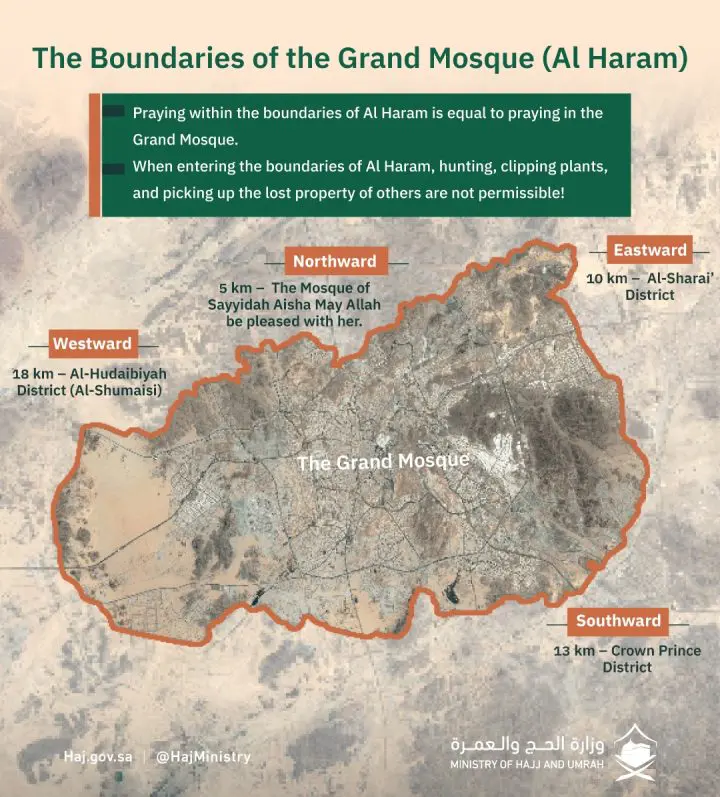
https://github.com/basit-adhi/GodSigns/blob/main/95AtTin.py
from openlocationcode import openlocationcode as olc_lib
import math
def plus_code_to_lat_lon(plus_code):
"""
Converts a Plus Code to its corresponding latitude and longitude.
"""
try:
decoded_code = olc_lib.decode(plus_code)
return decoded_code.latitudeCenter, decoded_code.longitudeCenter
except ValueError:
print(f"Error: Invalid Plus Code '{plus_code}'")
return None
except Exception as e:
print(f"An unexpected error occurred during decoding: {e}")
return None
def calculate_bearing_plus_code(plus_code1, plus_code2, log=True, rounding=200):
"""
Calculates the bearing from a starting point to a destination point, using plus code.
"""
lat1, lon1 = plus_code_to_lat_lon(plus_code1.PLUSCODE_)
lat2, lon2 = plus_code_to_lat_lon(plus_code2.PLUSCODE_)
if log :
print("\n++++++++++++++++++++++++++++++++++++")
print(f"{plus_code1.NAME_}: {plus_code1.PLUSCODE_} {lat1}, {lon1} ({math.radians(lat1)} rad, {math.radians(lon1)} rad )")
print(f"{plus_code2.NAME_}: {plus_code2.PLUSCODE_} {lat2}, {lon2} ({math.radians(lat2)} rad, {math.radians(lon2)} rad )")
print("++++++++++++++++++++++++++++++++++++")
return calculate_bearing(plus_code1.NAME_, plus_code2.NAME_, lat1, lon1, lat2, lon2, log, rounding)
def calculate_bearing(label1, label2, lat1, lon1, lat2, lon2, log=True, rounding=200):
"""
Calculates the bearing from a starting point to a destination point.
"""
# Convert degrees to radians
lat1_rad = round(math.radians(lat1), rounding)
lon1_rad = round(math.radians(lon1), rounding)
lat2_rad = round(math.radians(lat2), rounding)
lon2_rad = round(math.radians(lon2), rounding)
delta_lon = round(lon2_rad - lon1_rad, rounding)
x = round(round(math.sin(delta_lon), rounding) * round(math.cos(lat2_rad), rounding), rounding)
y = round(round(math.cos(lat1_rad), rounding) * round(math.sin(lat2_rad), rounding) - round(math.sin(lat1_rad), rounding) * round(math.cos(lat2_rad), rounding) * round(math.cos(delta_lon), rounding), rounding)
if log :
print(f"x = math.sin({delta_lon}) * math.cos({lat2_rad})")
print(f"x = {round(math.sin(delta_lon), rounding)} * {round(math.cos(lat2_rad), rounding)}")
print(f"x = {x}")
print(f"y = math.cos({lat1_rad}) * math.sin({lat2_rad}) - math.sin({lat1_rad}) * math.cos({lat2_rad}) * math.cos({delta_lon})")
print(f"y = {round(math.cos(lat1_rad), rounding)} * {round(math.sin(lat2_rad), rounding)} - {round(math.sin(lat1_rad), rounding)} * {round(math.cos(lat2_rad), rounding)} * {round(math.cos(delta_lon), rounding)}")
print(f"y = {y}")
initial_bearing = round(math.atan2(x, y), rounding)
# Convert bearing from radians to degrees
initial_bearing_deg = round(math.degrees(initial_bearing), rounding)
if log :
print(f"Initial Bearing: \nmath.atan2({x}, {y}) = {initial_bearing} rad = {initial_bearing_deg} degrees")
# Normalize bearing to a 0-360 degree range
compass_bearing = round((initial_bearing_deg + 360) % 360, rounding)
if log :
print(f"Normalized Bearing: \n{compass_bearing} degrees")
return compass_bearing
class MapPoint:
NAME_ = ""
PLUSCODE_ = ""
#makkah boundary
nearMainGate = MapPoint()
nearMainGate.NAME_ = "Haram Border [Near Main Gate (W)]"
nearMainGate.PLUSCODE_ = "7GHX9J2P+W4V"
MainGate = MapPoint()
MainGate.NAME_ = "Haram Border [Main Gate (W)]"
MainGate.PLUSCODE_ = "7GHX9M68+WP"
Hudaibiyah = MapPoint()
Hudaibiyah.NAME_ = "Haram Border [Al Hudaibiyah (NW)]"
Hudaibiyah.PLUSCODE_ = "7GHXCJJW+7W"
Taneem = MapPoint()
Taneem.NAME_ = "Haram Border [Near Masjid Aisha 'Umm al-Mumineen' (Masjid Al-Taneem) (N)]"
Taneem.PLUSCODE_ = "7GHXFR82+JC"
Kaaba = MapPoint()
Kaaba.NAME_ = "Kaaba"
Kaaba.PLUSCODE_ = "7GHXCRFG+2F"
#aproximately south of Saud Al Ruwais mosque God's mercy, GWMR+V2X, Al Ju'ranah 24434, Arab Saudi
Juranah = MapPoint()
Juranah.NAME_ = "Haram Border [Al Ju'ranah (E}']"
Juranah.PLUSCODE_ = "7GHXGWJQ+FHP"
Rashidiya = MapPoint()
Rashidiya.NAME_ = "Haram Border [Rashidiya (E)]"
Rashidiya.PLUSCODE_ = "7GHXFWPR+4JW"
#miqot
MasjidHudaibiyah = MapPoint()
MasjidHudaibiyah.NAME_ ="Miqot [Masjid Hudaibiyah NW]"
MasjidHudaibiyah.PLUSCODE_ = "7GHXCJRG+Q7X"
MasjidJironah = MapPoint()
MasjidJironah.NAME_ = "Miqot [Masjid Ji'ronah (NE)]"
MasjidJironah.PLUSCODE_ = "7GHXHX92+8F"
#mount sinai
JabalMoses = MapPoint()
JabalMoses.NAME_ = "Jabal Musa"
JabalMoses.PLUSCODE_ = "7GWMGXQG+C3"
JabalSerbal = MapPoint()
JabalSerbal.NAME_ = "Jabal Serbal"
JabalSerbal.PLUSCODE_ = "7GWMJMW2+HM"
loc_ = JabalMoses
rounding_ = 4
rounding_result_ = 2
cb1 = calculate_bearing_plus_code(nearMainGate, JabalMoses, True, rounding_)
cb2 = calculate_bearing_plus_code(MainGate, JabalMoses, True, rounding_)
cb3 = calculate_bearing_plus_code(Hudaibiyah, JabalMoses, True, rounding_)
cb4 = calculate_bearing_plus_code(Taneem, JabalMoses, True, rounding_)
cb5 = calculate_bearing_plus_code(Kaaba, JabalMoses, True, rounding_)
cb6 = calculate_bearing_plus_code(Juranah, JabalMoses, True, rounding_)
cb7 = calculate_bearing_plus_code(Rashidiya, JabalMoses, True, rounding_)
mq1 = calculate_bearing_plus_code(MasjidHudaibiyah, JabalMoses, True, rounding_)
mq2 = calculate_bearing_plus_code(MasjidJironah, JabalMoses, True, rounding_)
print("")
point1 = MasjidHudaibiyah
point2 = MasjidJironah
bear1 = calculate_bearing_plus_code(point1, loc_, False, rounding_)
bear2 = calculate_bearing_plus_code(point2, loc_, False, rounding_)
hh = round(bear1-bear2, rounding_)
print(f"The half-span of the angle formed by the bearings from western ({point1.NAME_}) and eastern ({point2.NAME_}) boundaries of the Haram to {loc_.NAME_}=({round(bear1-360, rounding_)}-{round(bear2-360, rounding_)})/2={hh/2}\n\n")
point1 = nearMainGate
point2 = Rashidiya
bear1 = calculate_bearing_plus_code(point1, loc_, False, rounding_)
bear2 = calculate_bearing_plus_code(point2, loc_, False, rounding_)
hh = round(bear1-bear2, rounding_)
print(f"The half-span of the angle formed by the bearings from western ({point1.NAME_}) and eastern ({point2.NAME_}) boundaries of the Haram to {loc_.NAME_}=({round(bear1-360, rounding_)}-{round(bear2-360, rounding_)})/2={hh/2}\n\n")
print(f"{hh/2}≈{round(hh/2, rounding_result_)} --> Surah At-Tin (Quran Chapter 95) mentions the Mount Sinai and the Secure City of Mecca in its second and third verse.")
loc_ = JabalSerbal
cb1 = calculate_bearing_plus_code(nearMainGate, JabalSerbal, True, rounding_)
cb2 = calculate_bearing_plus_code(MainGate, JabalSerbal, True, rounding_)
cb3 = calculate_bearing_plus_code(Hudaibiyah, JabalSerbal, True, rounding_)
cb4 = calculate_bearing_plus_code(Taneem, JabalSerbal, True, rounding_)
cb5 = calculate_bearing_plus_code(Kaaba, JabalSerbal, True, rounding_)
cb6 = calculate_bearing_plus_code(Juranah, JabalSerbal, True, rounding_)
cb7 = calculate_bearing_plus_code(Rashidiya, JabalSerbal, True, rounding_)
mq1 = calculate_bearing_plus_code(MasjidHudaibiyah, JabalSerbal, True, rounding_)
mq2 = calculate_bearing_plus_code(MasjidJironah, JabalSerbal, True, rounding_)
print("")
point1 = MasjidHudaibiyah
point2 = MasjidJironah
bear1 = calculate_bearing_plus_code(point1, loc_, False, rounding_)
bear2 = calculate_bearing_plus_code(point2, loc_, False, rounding_)
hh = round(bear1-bear2, rounding_)
print(f"The half-span of the angle formed by the bearings from western ({point1.NAME_}) and eastern ({point2.NAME_}) boundaries of the Haram to {loc_.NAME_}=({round(bear1-360, rounding_)}-{round(bear2-360, rounding_)})/2={hh/2}\n\n")
point1 = nearMainGate
point2 = Rashidiya
bear1 = calculate_bearing_plus_code(point1, loc_, False, rounding_)
bear2 = calculate_bearing_plus_code(point2, loc_, False, rounding_)
hh = round(bear1-bear2, rounding_)
print(f"The half-span of the angle formed by the bearings from western ({point1.NAME_}) and eastern ({point2.NAME_}) boundaries of the Haram to {loc_.NAME_}=({round(bear1-360, rounding_)}-{round(bear2-360, rounding_)})/2={hh/2}\n\n")Surah Al-Asr is the 103rd chapter of the Quran. Its location in the Quran is in Juz’ 30. “Asr” in Arabic generally refers to Epoch / Era / Age / Time / Afternoon. Cesium-133 atom unique properties are used to precisely define the second (time) within the International System of Units (SI). Hmm… 103, 30, and 133.
Fun Fact: The Time (Al Asr)

Surah Al-Asr adalah surah ke-103 dalam Al-Quran. Letaknya di Al-Quran ada di Juz’ 30. “Asr” dalam bahasa Arab umumnya merujuk pada Zaman / Era / Masa / Waktu / Sore. Sifat unik atom Sesium-133 digunakan untuk mendefinisikan secara tepat detik (masa) dalam Sistem Satuan Internasional (SI). Hmm… 103, 30, dan 133.
Fun Fact: Masa (Al Asr)
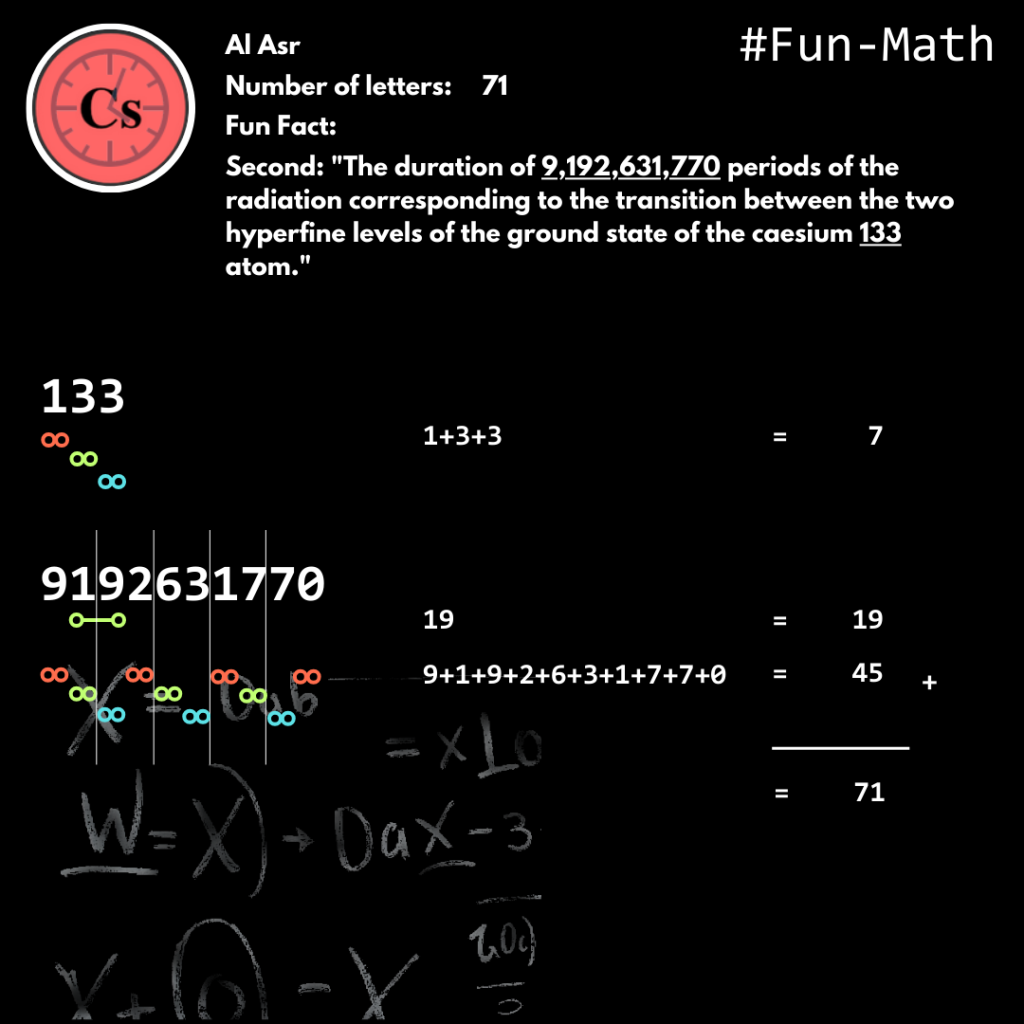
Al Asr
Number of letters:
71
Fun Fact:
Second: “The duration of 9,192,631,770 periods of the radiation corresponding to the transition between the two hyperfine levels of the ground state of the caesium 133 atom.”
133 9192631770
19 + 1+3+3+9+1+9+2+6+3+1+7+7+0 =71
#Fun-Math
- Time
- Masa
Surah Al-Asr is the 103rd chapter of the Quran. Its location in the Quran is in Juz’ 30. “Asr” in Arabic generally refers to Epoch / Era / Age / Time / Afternoon. Cesium-133 atom unique properties are used to precisely define the second (time) within the International System of Units (SI). Hmm… 103, 30, and 133.
For millennia, humanity has sought to measure time with increasing accuracy, from sundials to intricate mechanical clocks. Yet, the pursuit of truly universal and unwavering temporal precision reached its zenith with the advent of the atomic clock [archive], an innovation inextricably linked to a singular, remarkable element: Cesium-133 (Cs-133).
The unparalleled stability and measurability of this hyperfine transition led to a monumental decision by the 13th General Conference on Weights and Measures (CGPM) in 1967.
They formally redefined the second as: “The duration of 9,192,631,770 periods of the radiation corresponding to the transition between the two hyperfine levels of the ground state of the caesium 133 atom.”
This definition decoupled time from astronomical observation and grounded it in a fundamental, invariant property of matter itself.
In-depth information retrieval using AI and website.
Surah Al-Asr adalah surah ke-103 dalam Al-Quran. Letaknya di Al-Quran ada di Juz’ 30. “Asr” dalam bahasa Arab umumnya merujuk pada Zaman / Era / Masa / Waktu / Sore. Sifat unik atom Sesium-133 digunakan untuk mendefinisikan secara tepat detik (masa) dalam Sistem Satuan Internasional (SI). Hmm… 103, 30, dan 133.
Selama ribuan tahun, umat manusia telah berusaha mengukur waktu dengan akurasi yang terus meningkat, mulai dari jam matahari hingga jam mekanis yang rumit. Namun, pencarian presisi waktu yang benar-benar universal dan tak tergoyahkan mencapai puncaknya dengan hadirnya jam atom [archive], sebuah inovasi yang tak terpisahkan dari satu elemen tunggal yang luar biasa: Sesium-133 (Cs-133).
Stabilitas dan kemampuan ukur transisi hiperhalus yang tak tertandingi ini mengarah pada keputusan monumental oleh Konferensi Umum Timbangan dan Ukuran ke-13 (CGPM) pada tahun 1967.
Mereka secara resmi mendefinisikan ulang detik sebagai: “Durasi 9.192.631.770 periode radiasi yang berkaitan dengan transisi antara dua tingkat hiperhalus keadaan dasar atom sesium 133.”
Definisi ini melepaskan waktu dari pengamatan astronomi dan mendasarkannya pada sifat fundamental dan invarian materi itu sendiri.
Penggalian informasi mendalam dengan bantuan AI dan situs web.
In the context of the Quran, specifically Surah Al-Falaq, Chapter 113, “Falaq” means daybreak or dawn. Indium Gallium Arsenide (InGaAs, total atomic number: 113) is known for its ability to detect light across NIR and SWIR regions. It can detect light during Astronomical Twilight (possibly weak), Nautical Twilight, and Civil Twilight.
Fun Fact: The Daybreak (Al Falaq)

Dalam konteks Al-Qur’an, khususnya Surah Al-Falaq, Pasal 113, “Falaq” berarti fajar atau terbitnya matahari. Indium Gallium Arsenide (InGaAs, nomor atom total: 113) dikenal karena kemampuannya mendeteksi cahaya di wilayah NIR (inframerah dekat) dan SWIR (inframerah gelombang pendek). Material ini dapat mendeteksi cahaya selama Senja Astronomis (kemungkinan lemah), Senja Nautika, dan Senja Sipil.
Fun Fact: Subuh (Al Falaq)
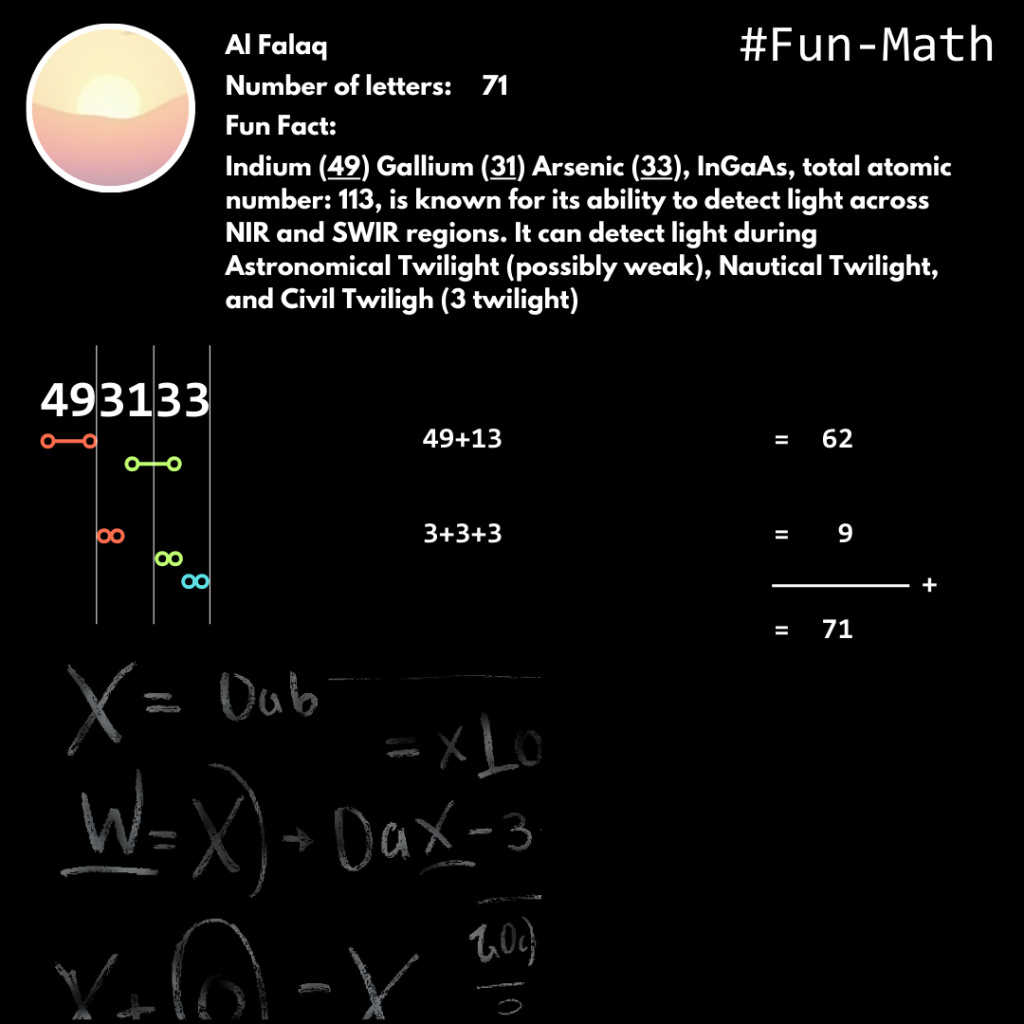
Al Falaq
Number of letters:
71
Fun Fact:
Indium (49) Gallium (31) Arsenic (33), InGaAs, total atomic number: 113, is known for its ability to detect light across NIR and SWIR regions. It can detect light during Astronomical Twilight (possibly weak), Nautical Twilight, and Civil Twiligh (3 twilight)
493133
49+13 + 3+3+3 = 71
#Fun-Math
- The Daybreak
- Subuh
In the context of the Quran, specifically Surah Al-Falaq, Chapter 113, “Falaq” means daybreak or dawn. Indium Gallium Arsenide (InGaAs, total atomic number: 113) is known for its ability to detect light across NIR and SWIR regions. It can detect light during Astronomical Twilight (possibly weak), Nautical Twilight, and Civil Twilight.
Indium Gallium Arsenide (InGaAs) [archive] is a semiconductor material known for its exceptional ability to detect light across the near-infrared (NIR) and short-wave infrared (SWIR) regions. The NIR spectrum generally spans from 0.75 to 1.4 microns, while the SWIR spectrum extends from 1.4 to 3.0 microns. InGaAs is uniquely suited for these wavelengths, making it an essential material for applications such as telecommunications, environmental monitoring, and industrial imaging. By tuning the ratio of indium and gallium, the bandgap of InGaAs can be adjusted, allowing for precise detection in these critical infrared ranges.
The atomic structure of InGaAs is composed of indium (atomic number 49), gallium (atomic number 31), and arsenic (atomic number 33), with a total atomic number of 113. These elements combine in a crystal lattice that optimizes the material’s ability to absorb and convert infrared light into electrical signals. This allows InGaAs to be highly sensitive to low-light conditions, such as those found during dawn or twilight, where infrared radiation is often the first to appear before visible light becomes detectable by the human eye.
InGaAs sensors are particularly powerful in detecting light during daybreak, especially in the NIR and SWIR ranges, where sunlight begins to emerge in the early morning. As the sun rises, its infrared light is often the first indicator of daylight, and InGaAs detectors are capable of picking up these subtle changes in light long before visible light is noticeable. This makes InGaAs an invaluable tool for detecting daybreak or other low-light events, enabling early detection and response in various automated systems, from smart buildings to scientific applications.
While InGaAs is excellent for NIR and SWIR light detection, other semiconductor materials like silicon (Si) and germanium (Ge) are also used in light sensing. Silicon-based sensors are typically designed for visible light, but they lose effectiveness in the infrared spectrum. Germanium performs better in the infrared range than silicon but does not match the versatility of InGaAs for both NIR and SWIR. InGaAs provides superior performance across a broader range of wavelengths, making it the preferred choice for high-precision light sensing in the infrared spectrum.
InGaAs At -18° (Astronomical Twilight)
At -18°, the sun is in the astronomical twilight phase, where it is well below the horizon. During this time, both visible and most infrared light from the sun are effectively absent, although some residual SWIR radiation from airglow or scattering may still be detectable by InGaAs sensors. This would be a weakest signal, and detection would depend on the sensitivity of the infrared sensors. Even in this phase, the sensor’s ability to detect faint SWIR signals can still be critical, especially in applications such as astronomy or atmospheric research.
InGaAs At -12° (Nautical Twilight)
As the sun reaches -12° below the horizon, this is the phase known as nautical twilight. During this time, the light in the NIR and SWIR regions becomes stronger and is still detectable by InGaAs sensors. The infrared radiation is still scattered in the atmosphere, but it is much brighter compared to the later twilight phases. SWIR light, which begins at around 1.4 microns, can be captured by the sensor, and the signal strength is increasing. InGaAs sensors can effectively detect these strengthening signals, allowing them to be used in applications like remote sensing or low-light monitoring.
InGaAs At -6° (Civil Twilight)
During civil twilight, the sun is just below the horizon (around 6° below). At this stage, there is still some weak infrared radiation (mostly NIR) that is scattered by the atmosphere. While visible light is not yet detectable by the human eye, infrared light, especially in the NIR range, can be picked up by InGaAs sensors. This makes InGaAs sensors highly effective at detecting early changes in light conditions, such as at the start of dawn, before visible light gradually becomes visible to the human eye.
In-depth information retrieval using AI and website.
Dalam konteks Al-Qur’an, khususnya Surah Al-Falaq, Pasal 113, “Falaq” berarti fajar atau terbitnya matahari. Indium Gallium Arsenide (InGaAs, nomor atom total: 113) dikenal karena kemampuannya mendeteksi cahaya di wilayah NIR (inframerah dekat) dan SWIR (inframerah gelombang pendek). Material ini dapat mendeteksi cahaya selama Senja Astronomis (kemungkinan lemah), Senja Nautika, dan Senja Sipil.
Indium Gallium Arsenide (InGaAs) [archive] adalah material semikonduktor yang dikenal karena kemampuannya yang luar biasa dalam mendeteksi cahaya di wilayah near-infrared (NIR) dan short-wave infrared (SWIR). Spektrum NIR umumnya membentang dari 0,75 hingga 1,4 mikron, sementara spektrum SWIR meluas dari 1,4 hingga 3,0 mikron. InGaAs sangat cocok untuk panjang gelombang ini, menjadikannya material penting untuk aplikasi seperti telekomunikasi, pemantauan lingkungan, dan pencitraan industri. Dengan menyesuaikan rasio indium dan galium, celah pita energi (bandgap) InGaAs dapat diatur, memungkinkan deteksi presisi dalam rentang inframerah yang krusial ini.
Struktur atom InGaAs tersusun dari indium (nomor atom 49), galium (nomor atom 31), dan arsenik (nomor atom 33), dengan total nomor atom 113. Elemen-elemen ini bergabung dalam kisi kristal yang mengoptimalkan kemampuan material untuk menyerap dan mengubah cahaya inframerah menjadi sinyal listrik. Hal ini memungkinkan InGaAs menjadi sangat sensitif terhadap kondisi cahaya rendah, seperti yang ditemukan saat fajar atau senja, di mana radiasi inframerah seringkali menjadi yang pertama kali muncul sebelum cahaya tampak dapat dideteksi oleh mata manusia.
Sensor InGaAs sangat ampuh dalam mendeteksi cahaya saat fajar, terutama dalam rentang NIR dan SWIR, di mana sinar matahari mulai muncul di pagi hari. Saat matahari terbit, cahaya inframerahnya seringkali menjadi indikator pertama adanya siang hari, dan detektor InGaAs mampu menangkap perubahan cahaya halus ini jauh sebelum cahaya tampak terlihat. Ini menjadikan InGaAs alat yang sangat berharga untuk mendeteksi fajar atau peristiwa cahaya rendah lainnya, memungkinkan deteksi dini dan respons dalam berbagai sistem otomatis, mulai dari bangunan pintar hingga aplikasi ilmiah.
Meskipun InGaAs sangat baik untuk deteksi cahaya NIR dan SWIR, material semikonduktor lain seperti silikon (Si) dan germanium (Ge) juga digunakan dalam penginderaan cahaya. Sensor berbasis silikon biasanya dirancang untuk cahaya tampak, tetapi efektivitasnya berkurang dalam spektrum inframerah. Germanium bekerja lebih baik dalam rentang inframerah daripada silikon, tetapi tidak menyamai keserbagunaan InGaAs untuk NIR dan SWIR. InGaAs memberikan kinerja yang unggul di berbagai panjang gelombang yang lebih luas, menjadikannya pilihan yang lebih disukai untuk penginderaan cahaya presisi tinggi dalam spektrum inframerah.
InGaAs pada -18° (Senja Astronomis)
Pada -18°, matahari berada dalam fase senja astronomi, di mana ia berada jauh di bawah cakrawala. Selama waktu ini, baik cahaya tampak maupun sebagian besar cahaya inframerah dari matahari secara efektif tidak ada, meskipun beberapa radiasi SWIR sisa dari pancaran cahaya atmosfer (airglow) atau hamburan mungkin masih dapat dideteksi oleh sensor InGaAs. Ini akan menjadi sinyal terlemah, dan pendeteksian akan bergantung pada sensitivitas sensor inframerah. Bahkan dalam fase ini, kemampuan sensor untuk mendeteksi sinyal SWIR yang samar masih dapat menjadi sangat penting, terutama dalam aplikasi seperti astronomi atau penelitian atmosfer.
InGaAs pada -12° (Senja Nautika)
Saat matahari mencapai -12° di bawah cakrawala, ini adalah fase yang dikenal sebagai senja nautika. Selama waktu ini, cahaya di wilayah NIR (Near-Infrared) dan SWIR (Short-Wave Infrared) menjadi lebih kuat dan masih dapat dideteksi oleh sensor InGaAs. Radiasi inframerah masih tersebar di atmosfer, tetapi jauh lebih terang dibandingkan fase senja berikutnya. Cahaya SWIR, yang dimulai sekitar 1,4 mikron, dapat ditangkap oleh sensor, dan kekuatan sinyalnya meningkat. Sensor InGaAs dapat secara efektif mendeteksi sinyal yang menguat ini, memungkinkannya digunakan dalam aplikasi seperti penginderaan jarak jauh atau pemantauan cahaya rendah.
InGaAs pada -6° (Senja Sipil)
Selama senja sipil, matahari berada tepat di bawah cakrawala (sekitar 6° di bawah). Pada tahap ini, masih ada beberapa radiasi inframerah lemah (kebanyakan NIR) yang tersebar oleh atmosfer. Meskipun cahaya tampak belum terdeteksi oleh mata manusia, cahaya inframerah, terutama dalam kisaran NIR, dapat ditangkap oleh sensor InGaAs. Hal ini membuat sensor InGaAs sangat efektif dalam mendeteksi perubahan kondisi cahaya awal, seperti saat fajar menyingsing, sebelum cahaya tampak secara bertahap terlihat oleh mata manusia.
Penggalian informasi mendalam dengan bantuan AI dan situs web.
It is not ˹possible˺ for this Quran to have been produced by anyone other than Allah. In fact, it is a confirmation of what came before, and an explanation of the Scripture. It is, without a doubt, from the Lord of all worlds. Or do they claim, “He made it up!”? Tell them ˹O Prophet˺, “Produce one sûrah like it then, and seek help from whoever you can—other than Allah—if what you say is true!”
Yunus 10:37-38
Tidaklah mungkin Al-Qurān ini dibuat oleh selain Allah; akan tetapi (Al-Qurān itu) membenarkan kitab-kitab yang sebelumnya dan menjelaskan hukum-hukum yang telah ditetapkannya, tidak ada keraguan di dalamnya, (diturunkan) dari Tuhan semesta alam. Atau (patutkah) mereka mengatakan “Muhammad membuat-buatnya”. Katakanlah, “(Kalau benar yang kamu katakan itu), maka cobalah datangkan sebuah surah seumpamanya dan panggillah siapa-siapa yang dapat kamu panggil (untuk membuatnya) selain Allah jika kamu orang-orang yang benar”.
Yunis 10:37-38
Let’s Think / Mari Berfikir
Thanks to inventions in optics, waves, and other technologies, our current experiences are profoundly different from those of the Prophet’s companions, and even from our grandparents’.
Setelah teknologi optik, gelombang dan lainnya ditemukan; apa yang kita alami sekarang, sahabat Nabi tidak mengalaminya, bahkan kakek kita mungkin juga tidak mengalaminya.
He created you ˹all˺ from a single soul, then from it He made its mate. And He produced for you four pairs of cattle. He creates you in the wombs of your mothers ˹in stages˺, one development after another, in three layers of darkness. That is Allah—your Lord! All authority belongs to Him. There is no god ˹worthy of worship˺ except Him. How can you then be turned away? (Az Zumar 5)
Dia menciptakan kamu dari seorang diri, kemudian Dia jadikan darinya istrinya dan Dia menurunkan untuk kamu delapan ekor yang berpasangan dari binatang ternak. Dia menjadikan kamu dalam perut ibumu kejadian demi kejadian dalam tiga kegelapan. Yang (berbuat) demikian itu adalah Allah, Tuhan kamu, Tuhan Yang mempunyai kerajaan. Tidak ada Tuhan (yang berhak disembah) selain Dia, maka bagaimana kamu dapat dipalingkan? (Az Zumar 5)
And indeed, We created humankind from an extract of clay, then placed each ˹human˺ as a sperm-drop in a secure place, then We developed the drop into a clinging clot, then developed the clot into a lump ˹of flesh˺, then developed the lump into bones, then clothed the bones with flesh, then We brought it into being as a new creation. So Blessed is Allah, the Best of Creators. (Al Mu’minun 12-14)
Dan sungguh, Kami telah menciptakan manusia dari saripati (berasal) dari tanah. Kemudian Kami menjadikannya air mani (yang disimpan) dalam tempat yang kokoh (rahim). Kemudian, air mani itu Kami jadikan sesuatu yang melekat, lalu sesuatu yang melekat itu Kami jadikan segumpal daging, dan segumpal daging itu lalu Kami jadikan tulang belulang, lalu tulang belulang itu Kami bungkus dengan daging. Kemudian, Kami menjadikannya makhluk yang (berbentuk) lain. Mahasuci Allah, Pencipta yang paling baik. (Al Mu’minun 12-14)
˹He is the One˺ Who created seven heavens, one above the other. You will never see any imperfection in the creation of the Most Compassionate. So look again: do you see any flaws? (Al Mulk 3)
Yang menciptakan tujuh langit berlapis-lapis. Tidak akan kamu lihat sesuatu yang tidak seimbang pada ciptaan Tuhan Yang Maha Pengasih. Maka lihatlah sekali lagi, adakah kamu lihat sesuatu yang cacat? (Al Mulk 3)
Indeed, in the creation of the heavens and the earth and the alternation of the day and night there are signs for people of reason. ˹They are˺ those who remember Allah while standing, sitting, and lying on their sides, and reflect on the creation of the heavens and the earth ˹and pray˺, “Our Lord! You have not created ˹all of˺ this without purpose. Glory be to You! Protect us from the torment of the Fire…” (Ali Imron 190-191)
Sesungguhnya dalam penciptaan langit dan bumi, dan pergantian malam dan siang terdapat tanda-tanda (kebesaran Allah) bagi orang yang berakal, (yaitu) orang-orang yang mengingat Allah sambil berdiri, duduk atau dalam keadaan berbaring, dan mereka memikirkan tentang penciptaan langit dan bumi (seraya berkata), “Ya Tuhan kami, tidaklah Engkau menciptakan semua ini sia-sia; Mahasuci Engkau, lindungilah kami dari azab neraka…” (Ali Imron 190-191)
Do the disbelievers not realize that the heavens and earth were ˹once˺ one mass then We split them apart? And We created from water every living thing. Will they not then believe? (Al Anbiya 30)
Dan apakah orang-orang yang kafir tidak mengetahui bahwasanya langit dan bumi itu keduanya dahulu adalah suatu yang padu, kemudian Kami pisahkan antara keduanya. Dan dari air, Kami jadikan segala sesuatu yang hidup. Maka mengapakah mereka tiada juga beriman? (Al Anbiya 30)
We also showed Abraham the wonders of the heavens and the earth, so he would be sure in faith. When the night grew dark upon him, he saw a star and said, “This is my Lord!” But when it set, he said, “I do not love things that set.” Then when he saw the moon rising, he said, “This one is my Lord!” But when it disappeared, he said, “If my Lord does not guide me, I will certainly be one of the misguided people.” Then when he saw the sun shining, he said, “This must be my Lord—it is the greatest!” But again when it set, he declared, “O my people! I totally reject whatever you associate ˹with Allah in worship˺.” (Al An’am 76-78)
Dan demikianlah Kami memperlihatkan kepada Ibrahim kekuasaan (Kami yang terdapat) di langit dan di bumi, dan agar dia termasuk orang-orang yang yakin. Ketika malam telah menjadi gelap, dia (Ibrahim) melihat sebuah bintang (lalu) dia berkata, “Inilah Tuhanku.” Maka ketika bintang itu terbenam dia berkata, “Aku tidak suka kepada yang terbenam.” Lalu ketika dia melihat bulan terbit dia berkata, “Inilah Tuhanku.” Tetapi ketika bulan itu terbenam dia berkata, “Sungguh, jika Tuhanku tidak memberi petunjuk kepadaku, pastilah aku termasuk orang-orang yang sesat.” Kemudian ketika dia melihat matahari terbit, dia berkata, “Inilah Tuhanku, ini lebih besar.”Tetapi ketika matahari terbenam, dia berkata, “Wahai kaumku! Sungguh, aku berlepas diri dari apa yang kamu persekutukan.” (Al An’am 76-78)
However, all technological achievements produced by humans relating to themselves (DNA, cloning, Artificial Inteligence, etc), universe, and its contents have limits.
Namun, semua pencapaian teknologi yang dihasilkan manusia berkaitan dengan dirinya (DNA, kloning, kecerdasan buatan, dll) serta alam semesta beserta isinya ada batasnya
They ask you ˹O Prophet˺ about the spirit (soul). Say, “Its nature is known only to my Lord, and you ˹O humanity˺ have been given but little knowledge.” (Al Isra 85)
Dan mereka bertanya kepadamu tentang ruh. Katakanlah, “Ruh itu termasuk urusan Tuhan-ku dan tidaklah kamu diberi pengetahuan, melainkan sedikit”. (Al Isra 85)
Did every single things in details, from atoms (or smaller) to the observerable universe (or bigger), happen by chance? The key word is “impossible, unless”, that is, it is impossible for all of this to happen, unless Allah created it.
Apakah setiap hal secara detail, mulai dari atom (atau yang lebih kecil) hingga alam semesta yang dapat diamati (atau lebih besar), terjadi secara kebetulan? Kata kuncinya adalah “mustahil, kecuali”, artinya semua itu tidak mungkin terjadi, kecuali Allah yang menciptakannya.
So, know ˹well, O Prophet,˺ that there is no god ˹worthy of worship˺ except Allah. And seek forgiveness for your shortcomings and for ˹the sins of˺ the believing men and women. For Allah ˹fully˺ knows your movements and places of rest ˹O people˺. (Muhammad 19)
Maka ketahuilah, bahwa tidak ada tuhan (yang patut disembah) selain Allah, dan mohonlah ampunan atas dosamu dan atas (dosa) orang-orang mukmin, laki-laki dan perempuan. Dan Allah mengetahui tempat usaha dan tempat tinggalmu. (Muhammad 19)
˹O believers!˺ Do not insult what they invoke besides Allah or they will insult Allah spitefully out of ignorance. This is how We have made each people’s deeds appealing to them. Then to their Lord is their return, and He will inform them of what they used to do. (Al An’am 108)
Dan janganlah kamu memaki sembahan-sembahan yang mereka sembah selain Allah, karena mereka nanti akan memaki Allah dengan melampaui batas tanpa pengetahuan. Demikianlah Kami jadikan setiap umat menganggap baik pekerjaan mereka. Kemudian kepada Tuhan merekalah mereka kembali, lalu Dia memberitakan kepada mereka apa yang dahulu mereka kerjakan. (Al An’am 108)
Presentation Format (Bahasa Indonesia)
Format Presentasi
https://docs.google.com/presentation/d/1BFRAC0CIR6AHZJ6TCEmw1nqCwAgbyDczPQrU63uNtJw
